Snow-Forecast’s Rolling News on Ski Resorts Re-Opening (2023)

Last Updated 7 February 2023 at 6.20 GMT (Updates so far since commenced on 12 May 2020: 1,529)
The web’s most comprehensive guide of ski resorts opening around the world during the pandemic.
An estimated 5000 Ski Areas Are Currently Open Worldwide in 65 Countries on 3 Continents including: Asia: China, India, Israel, Japan, Kazakhstan, Kyghizstan, Lebanon, Mongolia, Pakistan, Uzbekistan Europe: Andorra, Austria, Bosnia, Bulgaria, Croatia, Czech Republic, Estonia, Finland, France, Germany, Georgia, Greece, Hungary, Portugal, Iceland, Italy, Latvia, Lithuania, Norway, Poland, Portugal, Romania, Russia, Scotland, Slovak Republic, Slovenia, Spain, Sweden, Switzerland, Turkey, Ukraine North America: Canada, USA
Browse by country:
North America:
Europe:
Asia:
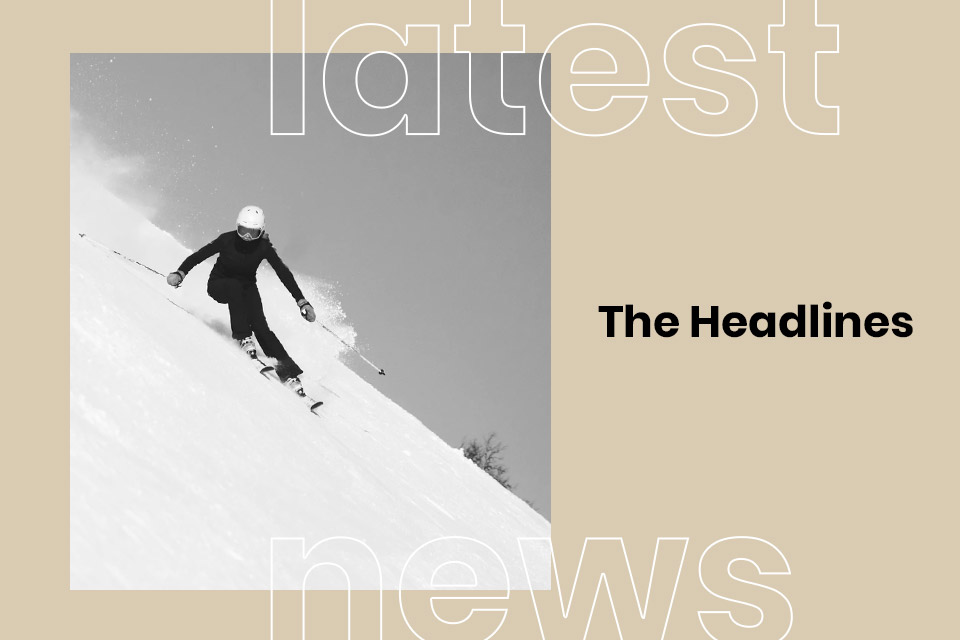
- Nearly three years after the start of the pandemic in the west, unvaccinated travel to the USA for non-citizens/residents remains banned.
- China reports crowds returning to ski slopes as Covid infection wave following restrictions easing begins to diminish.
- Mask-wearing remains in place in South Korea but there are reports restrictions will be lifted indoors early in 2023, but probably not on public transport, including enclosed skilift cabins.
- Japan’s 22-23 season – First open to international arrivals since early 2020 – underway (23 October)
- Mt Ruapehu in New Zealand has gone into voluntary administration after two pandemic seasons followed by a bad snow season (13 October)
- Japan’s borders have re-opened (11 October)
- Canada have dropped all border restrictions on entry (1 Oct)
- Australia has said it will end mandatory Covid isolation for five days from 14 October (29 September)
- Japan is inching closer to re-opening its borders …or at least making travel there a little easier. (22 September)
- Spain has extended its restrictions on arrivals from outside the EU to late November and close to the start of the ski season. It’s possible for vaccinated and unvaccinated people to enter but unvaccinated people must have proof of a recent negative PCR test or infection recovery (17 September).
- Japan has announced restrictions easing from September including the dropping of the need to take a pre-arrival PCR test and to travel in an organised group for citizens of selected countries who are triple vaccinated (24 August).
- New Zealand has full re-opened its borders. (1 August)
- USA will no longer require a negative COVID test result for arrivals so skiers heading there or returning there from skiing in the southern hemisphere or Europe’s glaciers will no longer need to take a pre-departure test before flying there (12 June).
- The main US travel body, ASTA, has told their government the main issue stopping travel from recovering is inbound testing (June 8).
- Japan is reopening its borders to tourists, initially with restrictions, from June 10th. (May 27)
(Headlines from earlier in the pandemic are archived below)
*** Scroll down to the country section below for more details and latest updates ***
Click the links below to see:
- Country-By-Country Update on what’s happening to ski resorts there.
- Operating In A Pandemic – What Has Changed?
- Common Sense
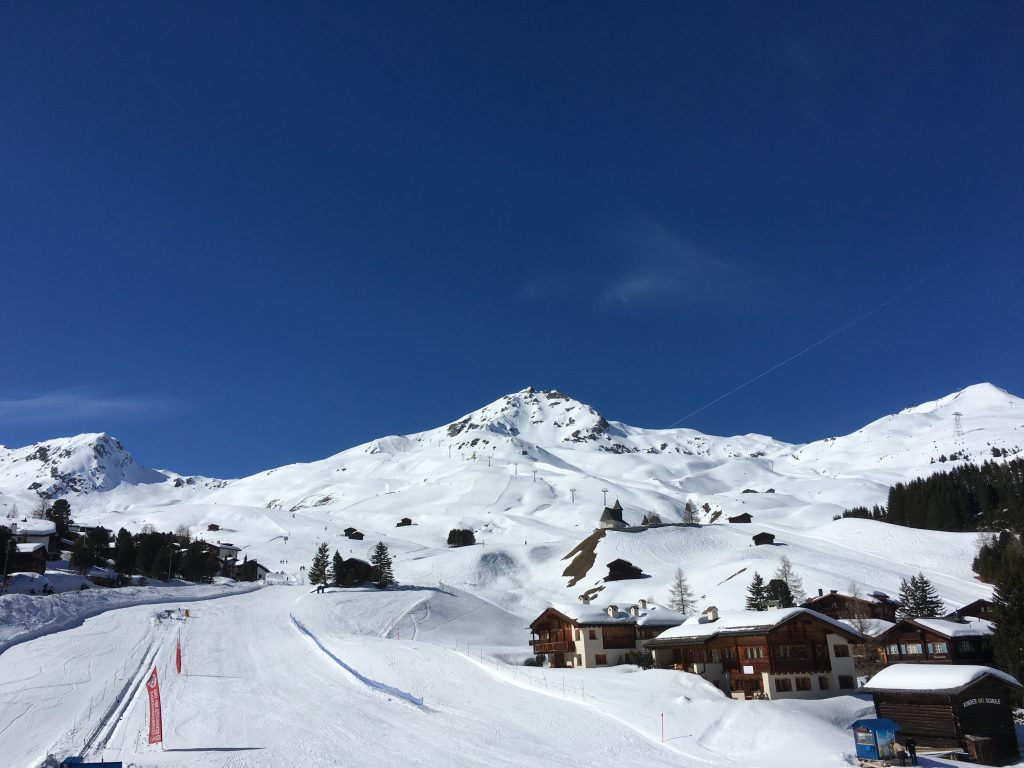
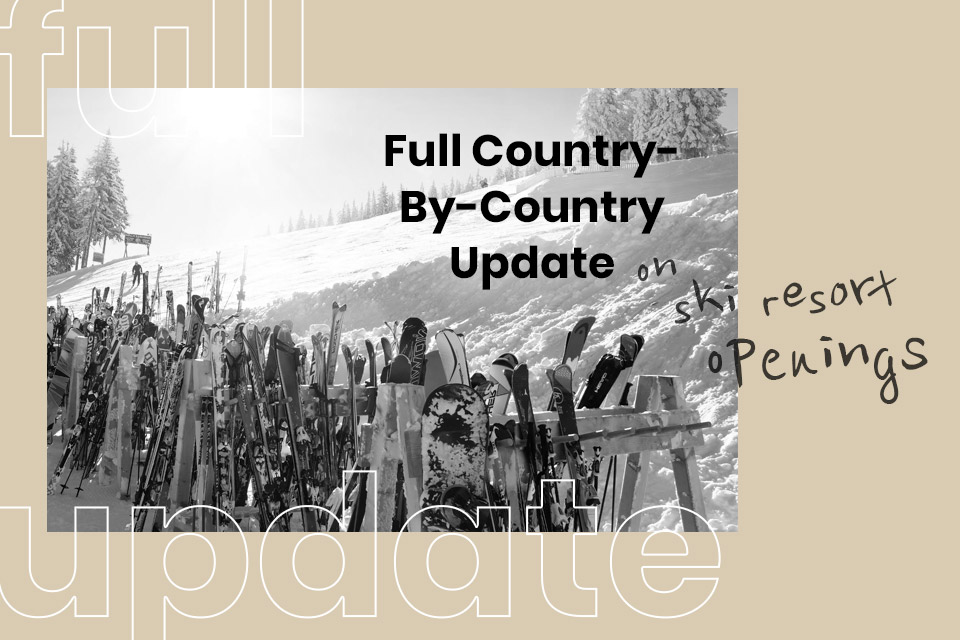
(Please note updates are posted for each country when we hear of new developments. These are changing around the world at different times and sometimes without much publicity now so please contact us if you see something that needs updating. We run checks on all countries regularly but only update a section when we hear of something to update, with the most recent date for each country listed in its entry)
Skis Areas Open in the Northern Hemisphere for the 2022-23 Season
(Scroll down for info on Northern Hemisphere ski nations’ spring 2020, winters 20-21 and 21-22 and (where applicable) summer ski 2020 and 2021 operations as well as southern hemisphere 2020, 2021 and 2022 ski seasons.
Austria
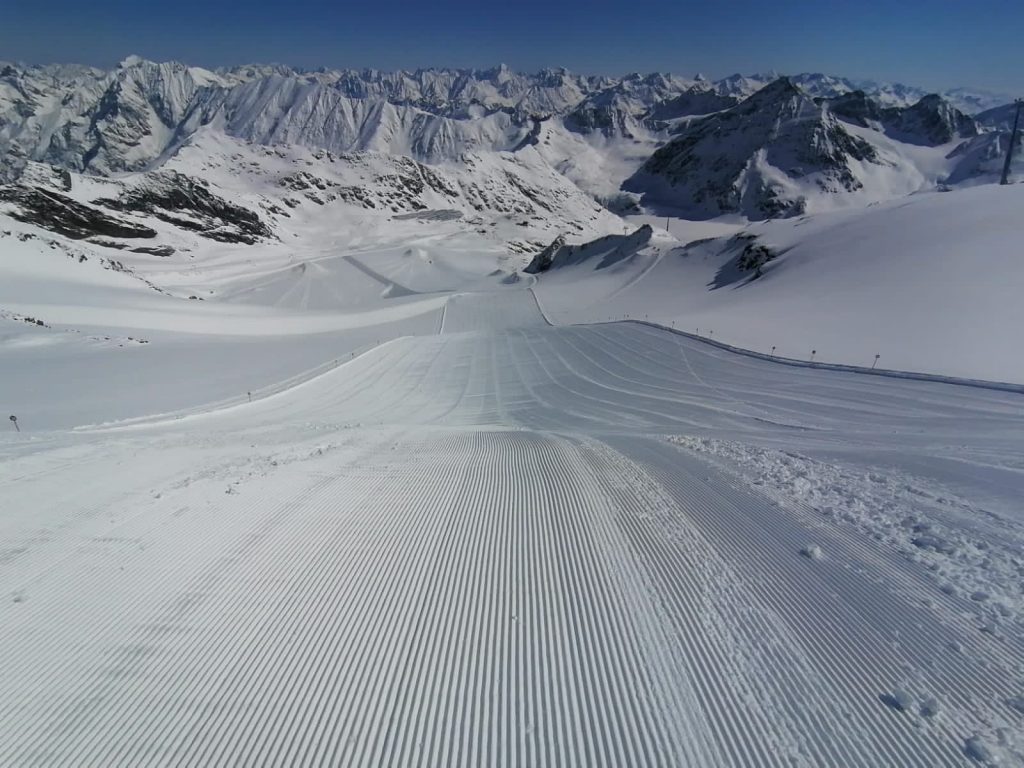
*** Updated 7th February, 2023 ***
Current Status: Open.
Austria Entry Requirements Info:
https://www.austria.info/en/service-and-facts/coronavirus-information/entry-regulations
Austria Centres Currently Open: 400
The 2022-23 Ski Season in Austria
The ski season saw fresh snowfall in late September after a long, hot summer. There were five glacier areas, all in Tirol, open at the start of October. The Kitzsteinhorn in Salzburgerland was the sixth to open on 7th October. The Dachstein Glacier is already open but says it will only operate for cross-country skiers this winter.
Kitzbuhel opened on 12th November thanks to snow farming.
Masks must still be worn on public transport in Austria unless a medical exemption certificate can be produced.
As of the start of 2023 everything is open with the main issue a lack of cold weather and snow rather than virus concerns.
That remained the case through Christmas and New Year.
(For information on Austria’s Summer 2022, Winter 21-22, Summer 2021, Winter 2020-21 Season and Summer 2020 seasons as well as operations in Spring 2020 at the start of the pandemic please scroll down)
Canada
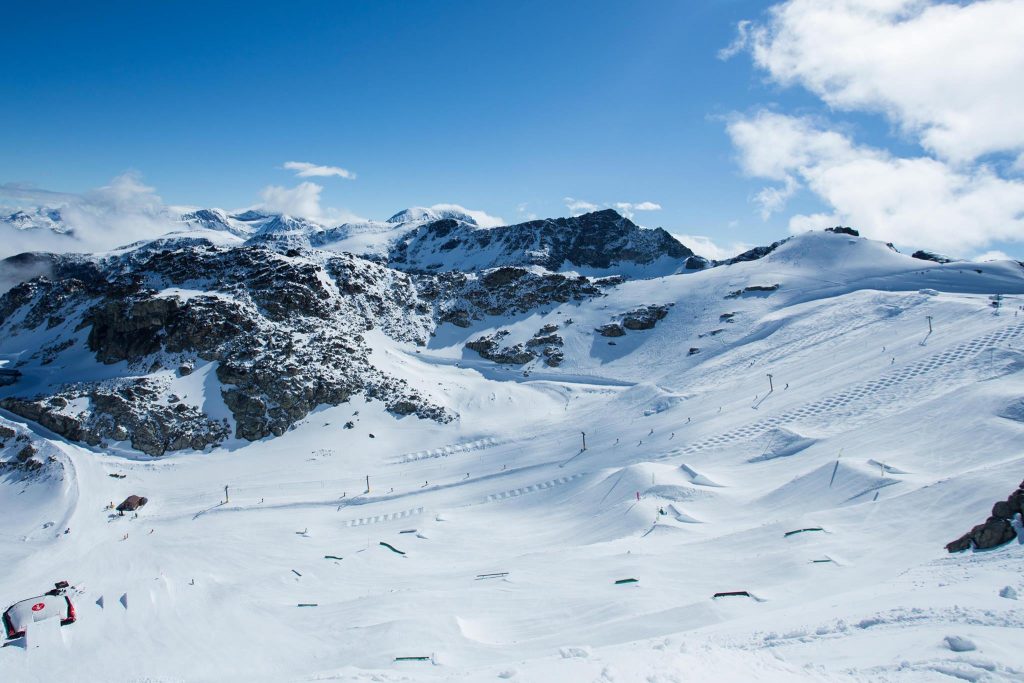
*** Updated on 7th February, 2023 ***
Operating status: Open.
Covid Border Restrictions: None.
Canada ski areas open: 200
Canada’s 22-23 Ski Season
At the start of October Canada announced that they have dropped all border restrictions on entry, to the delight of international skiers and boarders.
As of October 1, 2022, all Canadian COVID-19 restrictions have lifted, meaning this winter it’s easier than ever to book a ski trip to the Canadian Rockies. Border requirements including proof of vaccination, use of the ArriveCAN App, and any testing and quarantine/isolation requirements have ended for all travellers entering Canada whether by land, air or sea.
Lake Louise and Mt Norquay say they’ll aim to open on 4th October, the earliest known target date.
Heavy snowfall in late October led to Sunshine opening a week early on November 3rd. Lake Louise opened the next day.
Ski areas opened early in BC from 12th November and on the East Coast in Quebec a few days later.
As of the start of 2023 there have been no recent reports of the pandemic causing any operational issues, the main problems have been weather-related, very low temperatures and violent storms in the west, milder temperatures in the East.
(For information on Canada’s Summer 2021 season, Winter 2020-21 and 2021-22 seasons, Summers 2020 and 2021 seasons and operations in Spring 2020 at the start of the pandemic please scroll down)
Finland
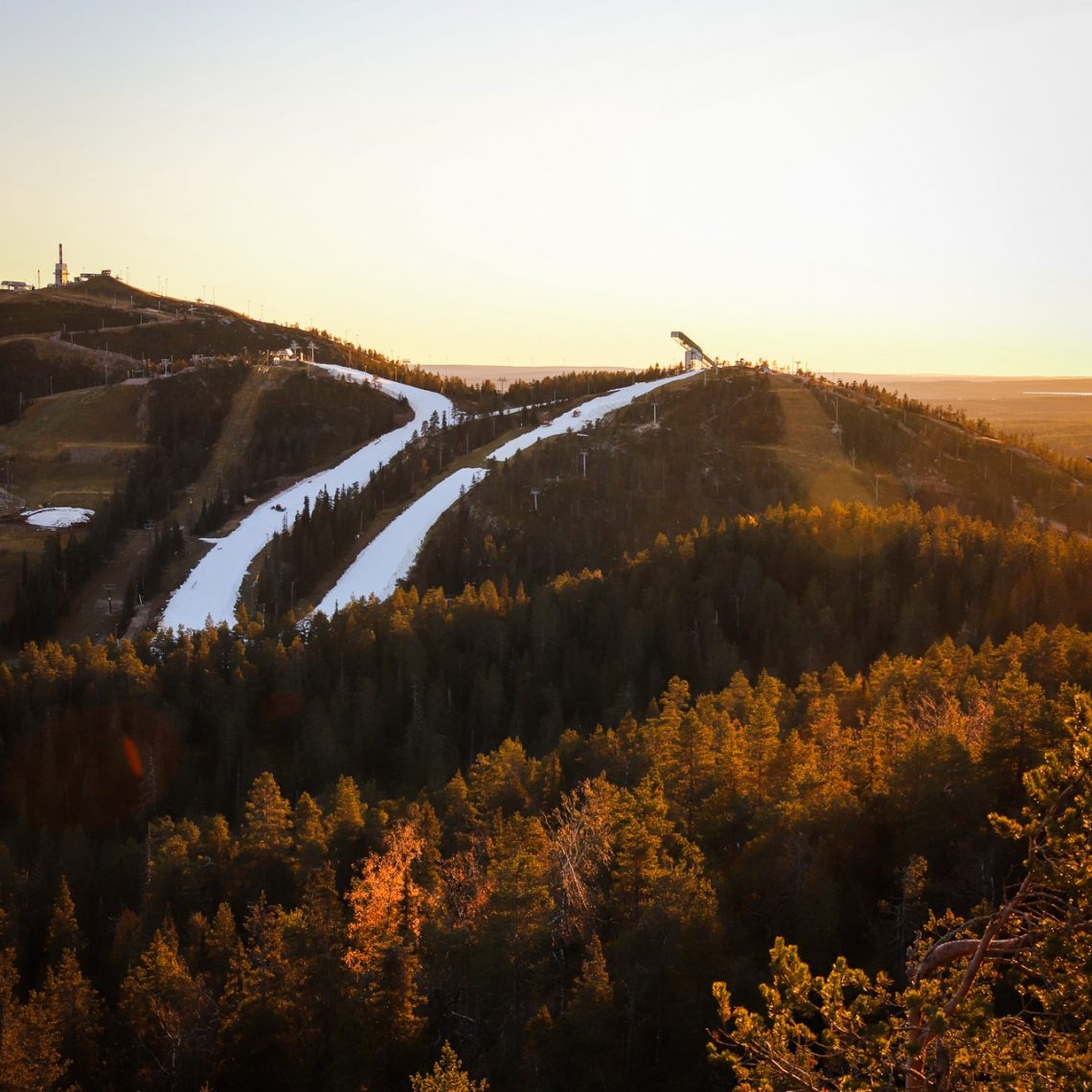
*** Updated 7th Febrary 2023 ***
Status: Open
Resorts Open: 100
Finland’s 2022 – 23 Ski Season
Finland’s 2022-23 season began on Friday, 7th October, with Levi and Ruka opening thanks to using snow farming and spreading last winter’s snow back out on the slopes.
The country has operated its ski areas without covid restrictions through winter 22-23.
(For information on Finland’s winter 2020-21 and 2021-22 seasons please scroll down)
France
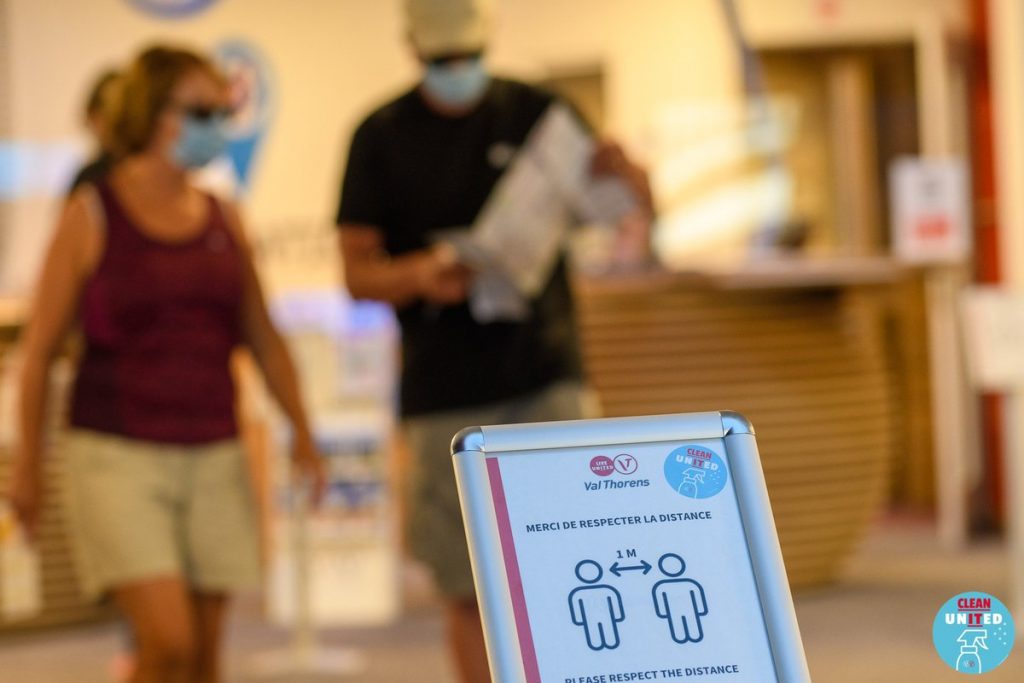
*** Updated on 7th February, 2023 ***
Current Status: Open.
France Entry Rules: https://www.diplomatie.gouv.fr/en/coming-to-france/coronavirus-advice-for-foreign-nationals-in-france/
France Ski Centres Currently Open: 300
The 2022 – 23 Ski Season In France
Tignes and Les 2 Alpes were due to open on October 15th. There has been some late September snowfall in the Alps.
By mid-October snowfall had not been adequate with Les 2 Alpes announcing it wouldn’t open until the main season began and Tignes delaying until adequate snowfall.
Tignes finally opened on 19th November with Val Thorens joining them after a week’s delay.
French resorts have operated fairly normally through the ski season.
(For information on France’s Summer 2022 season, Winter 2021-22 Season, Summer 2021 season, Winter 2020-21 season, Summer 2020 season and operations in Spring 2020 at the start of the pandemic please scroll down)
Italy
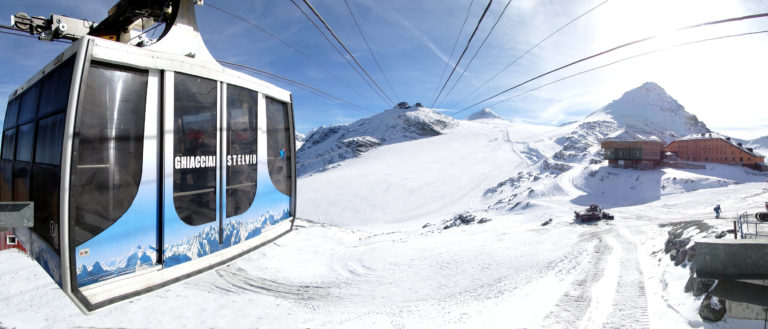
***Updated 7th February, 2023 ***
Current Status: Open.
Current advice on travel rules to enter Italy: http://www.italia.it/en/useful-info/covid-19-updates-information-for-tourists.html
Italy Ski Centres Currently Open: 250
Italy’s 2022 – 23 Ski Season
There were snowfalls on higher slopes in late September on the Italian alps and dolomites. The temporarily closed Passo Stelvio re-opened and Val Senales opened for its 22-23 season. On 1st October Cervinia re-opened access to Zermatt’s glacier ski area.
More ski areas began opening in late November with Cortina, Madonna di Campiglio and others skiable by the end of the month, along with the cross-border link from Zermatt skiing into Italy above Cervinia.
Italian ski areas remained open into the third winter since the pandemic, with everywhere open.
For information on Italy’s 2020, 2021 and 2022 and Summer ski seasons, (non) 20-21 and 21-22 winter seasons, and what happened in the first 6 months of the pandemic in Italy in 2020, please scroll down.
Japan
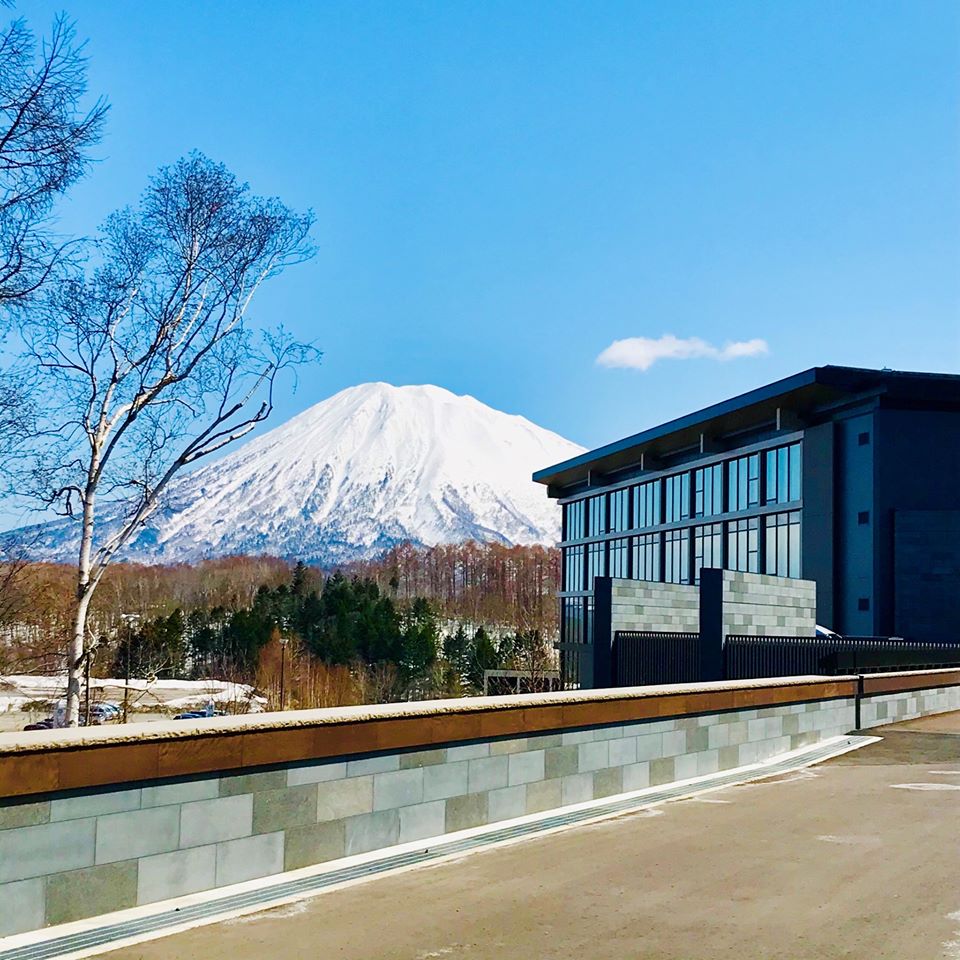
***Updated 7th February, 2023 ***
Current Status: Open
Japan information on travel:
www.japan.travel/en/coronavirus/
Japan Ski Centres Currently Operating: 450
The 22 – 23 Season in Japan
It was later confirmed the rules would be eased to allow individual entry from 1st October.
Japan’s 22-23 season began on 21st October and is the first open to international arrivals since early 2020. There was widespread snowfall as temperatures dropped over the following week.
Japan remained open through the winter, although with lots of covid caution continuing in day to day life in resort.
(For information on Japan’s winters of 2021 – 22 and 2020-21 Season and operations in Spring 2020 at the start of the pandemic please scroll down)
Norway
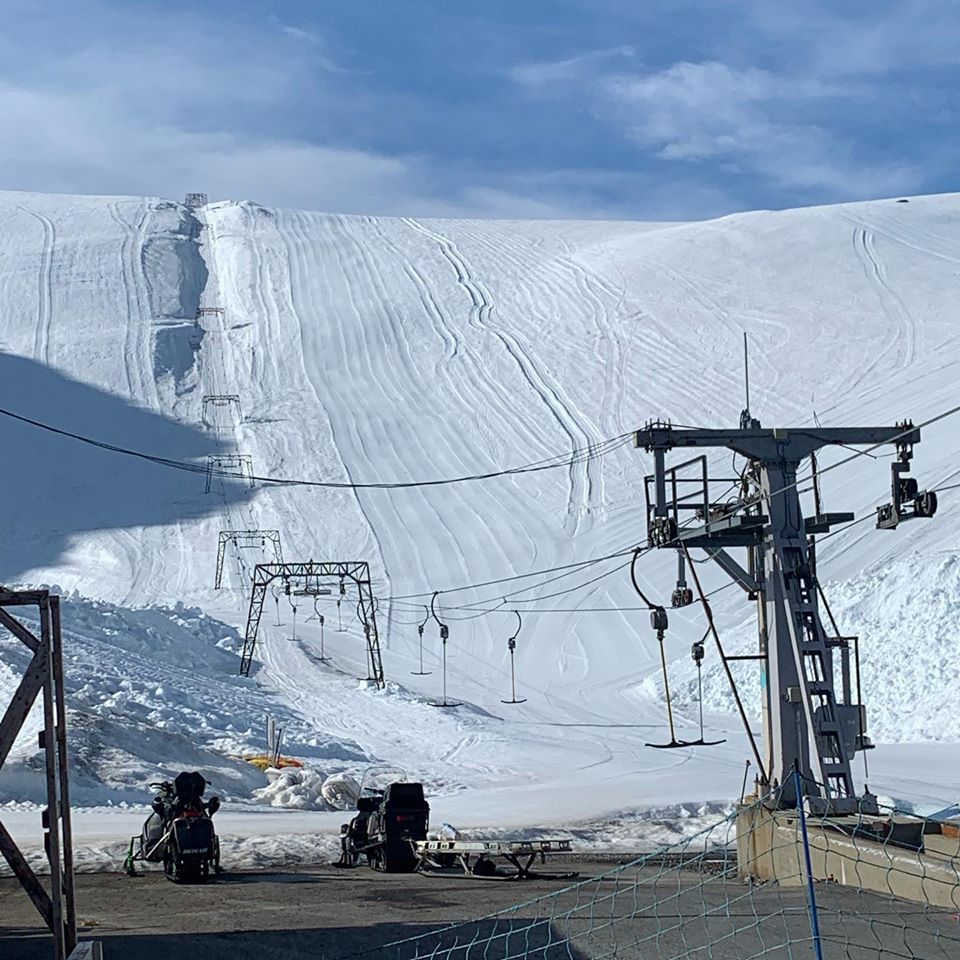
*** Updated 7th February, 2023 ***
Current status: Season Underway.
Norway Ski Centres Currently Open: 100
Norway’s 23 – 23 Ski Season
Temperatures began dropping and ski areas started opening in late November 2022, with the first big ski areas opening on the first weekend of December.
There are not believed to be any coronavirus restrictions in place at present and throughout the 22-23 season Norwegian ski areas have operated normally without restrictions.
Norway’s 2022 Summer Ski Season
Norway opened for summer skiing on 14th May with the Fonna and Galdhoppigen glaciers opening, Fonna two weeks later than expected due to lift issues, then foggy weather.
The country has removed all pandemic restrictions.
The country’s third summer ski area at Stryn opened at the start of June and all three centres stayed open through the month, reporting better conditions than the Alps having had better winter snowfall then a cooler spring, they claimed.
On 28th June Stryn said it expected to close again on 17th June after a seven week summer ski season, a little longer than recent years.
Stryn did close as forecast and Galdhoppigen also closed in the latter half of July but only on a temporary basis in its case ‘to preserve the snow’ It is believed to have reopened from July 29th.
Fonna announced it was closing early in mid-August due to summer thawing but it and Galdhopiggen remain open to ski race teams and the latter hopes to re-open to all in the autumn when conditions improve.
Fonna announced in late August it would close to teams too from the 4th.
Galdhopiggen re-opened to all on 17th September.
More centres started opening from the end of November.
For information on Norway’s Summer 2021 and 21-22 and 20-21 winter seasons, and what happened in the first 6 months of the pandemic in Norway in 2020, please scroll down.
Switzerland
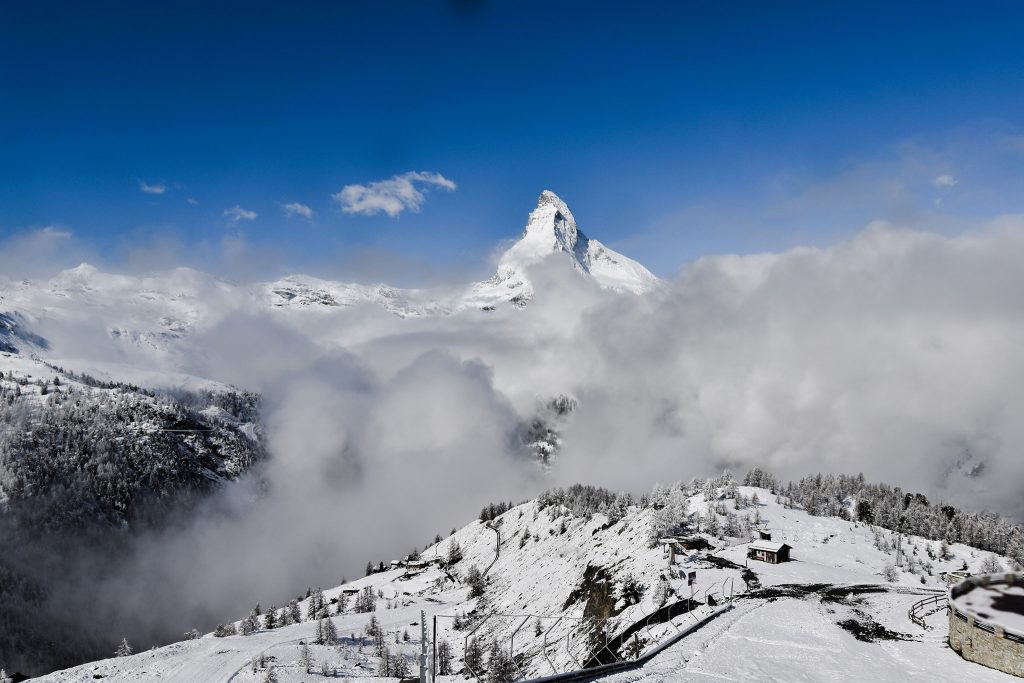
*** Updated 7th February, 2023 ***
Switzerland Current status: Open.
Current rules on Travel to Switzerland: Follow this link.
Switzerland Ski Centres Currently Open: 250
Switzerland’s 22-23 Ski Season
Switzerland’s ski season got underway in mid-September 2022 with Zermatt returning its 365 day opening following a seven-week break caused by the hot, dry summer.
Saas Fee, which had opened in mid-July but only to race teams due to limited terrain available for nearly three months, opened to the public on 8th October. Engelberg was third to open a week later.
Since the start of the main season, Swiss areas have been operating normally without any pandemic restrictions.
For information on Switzerland’s 20-21 and 21-22 winter seasons and Summer 2021 and 2022 seasons as well as what happened in the first 6 months of the pandemic in Switzerland in 2020, please scroll down.
USA
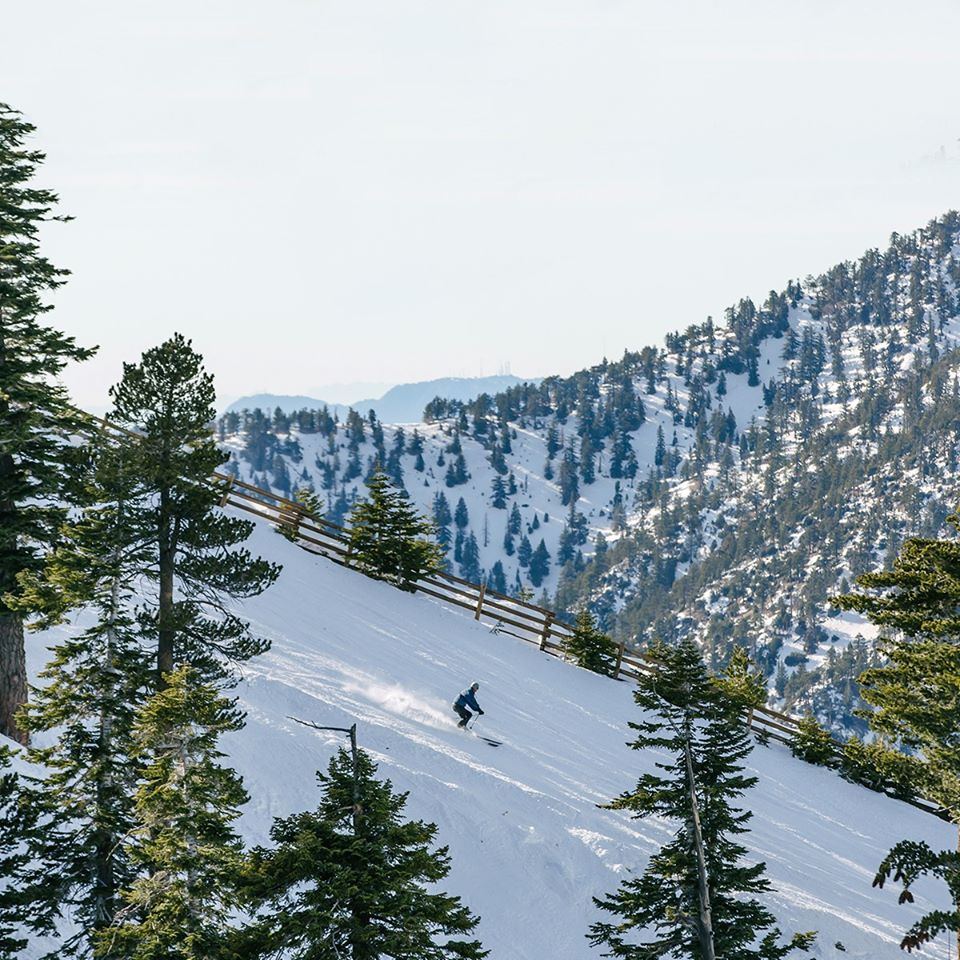
***Updated 7th February, 2023 ***
USA Current status: Open
Travel to the USA Current info:
https://www.cdc.gov/coronavirus/2019-ncov/travelers/noncitizens-US-air-travel.html
USA Ski Centres Currently Open: 350
US 2022 – 23 Ski Season
As of September 2022 no ski areas are open in the USA but a number have declared their intention to start snowmaking at the end of the month and open as soon as possible in October.
Most COVID operating rules have been dropped however the US is still not allowing access to non-US citizens that have not been vaccinated, even if they have a recent negative test result or evidence of recovery from a recent infection.
The first resorts to open included Wild Mountain in Minnesota on 18th October, it had also been first in North America to open in 2020.
Arapahoe Basin opened 23rd October and Keystone the following weekend.
The season continued normally through Christmas and new year which many areas adopting covid policies of online booking and limiting numbers they’d found worked better than pre-pandemic free for alls.
However as of the start of February, unvaccinated travel to the USA for non-citizens/residents remains banned.
For information on America’s 2021 summer season and 21-22 and 20-21 winter seasons, and what happened in the first 6 months of the pandemic in the US in 2020, please scroll down.
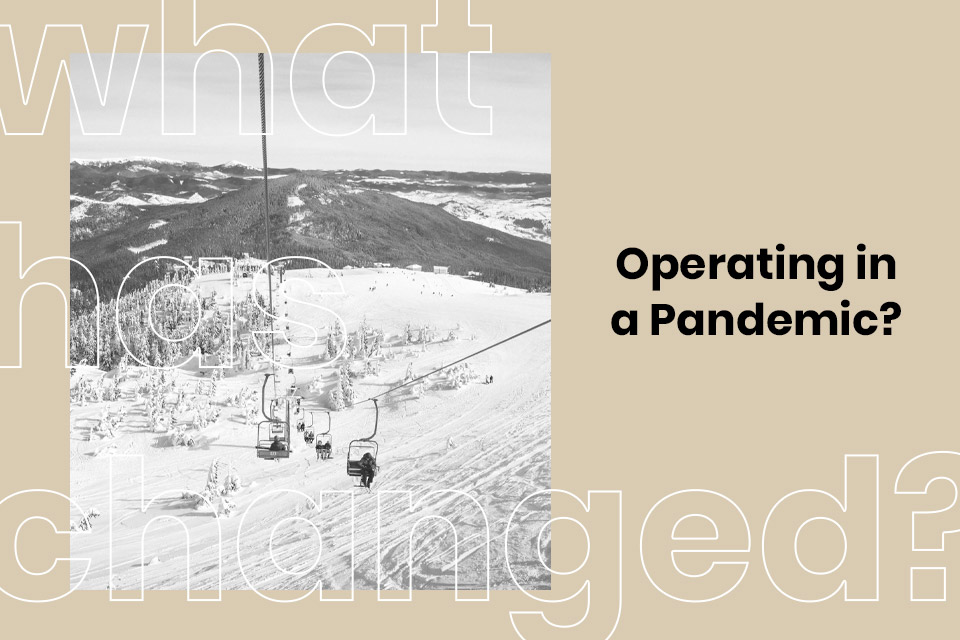
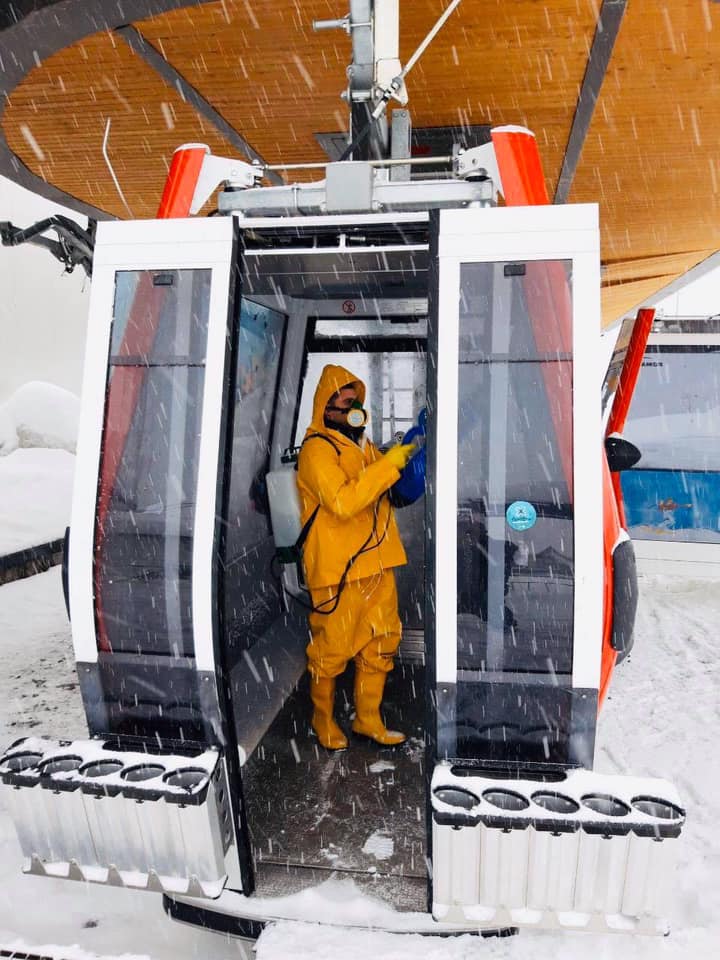
THE A-Z OF THE ‘NEW NORMAL’ IN 2020 – 22 ON THE WORLD’S SKI SLOPES…
Apres Ski
The apres ski scene was fairly non-existent in ski resorts around the world during the 2020 southern hemisphere ski season and 20-21 northern hemisphere winter season. Unofficial gatherings in some cases led to police action and fines. The clear exception was New Zealand where society was able to operate fairly normally. Northern Hemisphere areas that were open on 20-21 often had bars and restaurants closed, or only allowed them to open outdoor terrace areas.
Car Parking
For skiers arriving by car, some resorts are providing timed arrival slots which must be booked in advance to avoid gatherings of people at the base. Others are requiring cars, like people, to be socially distanced – including Caviahue in Argentina:

Early Closure Calls
Some ski areas, most notably in Argentina when areas re-opened there from late July, have introduced a policy of deciding the day before if an area will open the next day, based on the forecast rather than the actual weather on the day. The idea is to avoid the danger of a lot of people gathering waiting together at the bottom of what turn out to be closed, storm-bound slopes.
Eating and Drinking
There are different approaches being employed in different ski areas. However there are common themes. Screens to separate distanced tables are common, as are the options of food delivery services. Some are offering a counter takeaway service only and some only outdoor dining with tables spaced two metres or more apart and the same rules of social distancing we are getting used to with groups that are together anyway able to eat and sit together but separate groups and individuals well spaced out.
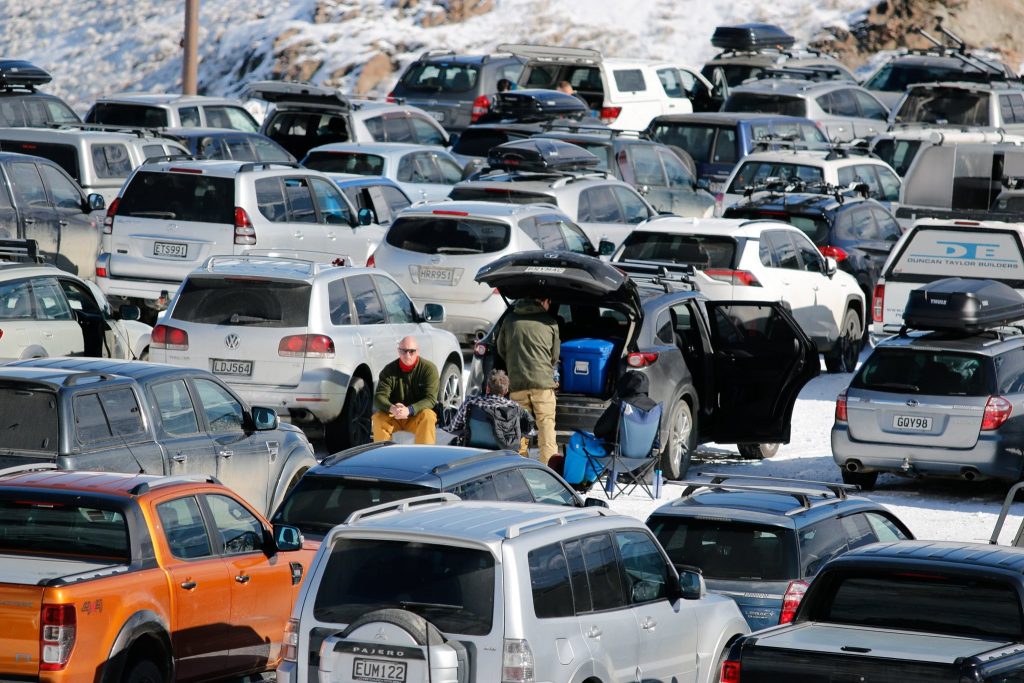
For ski areas that attract a lot of self-driving clientele they’re promoting a “your car is your base lodge” approach with skiers encouraged to bring their own food and drink to consume in their cars during breaks.s
Faster Lifts
A number of ski areas in Europe and North America have announced they’ll be running their lifts faster, where that’s an option, this winter, to minimise time on board. This is along with frequent cleaning, contact-less-access open windows and mask wearing. Italy’s Alta Badia and Jackson Hole in the US are among resorts announcing this.
Hygiene
Ski areas that are currently open are making a lot of efforts to clean And disinfect public areas including lifts regularly and continuously and hand sanitisers are being made widely available for visiting skiers.
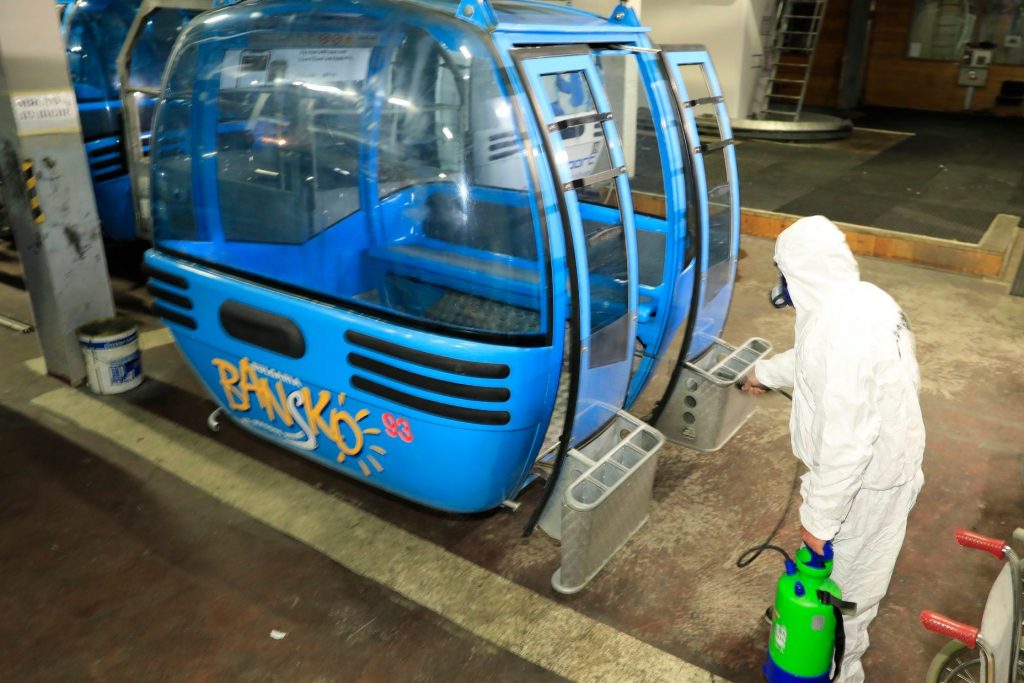
Lift Tickets
Resorts are doing all they can to minimise human contact in the ticket purchasing process. This typically means buying your pass online and adding credit to an electronic pass. If it’s a resort with a physical pass you’ll likely pay for online or on a site with a contactless card and collect it in a way that avoids human contact.
Limited Numbers
Some ski areas that have been operating in recent weeks and months have strictly limited the number of people allowed on site. Many require you to buy your lift pass and book your time on the slopes at least a day in advance, you can no longer just roll-up. Some have sold-out for several days in advance as a result. Reports from Australia indicated tickets at some resorts were snapped up for much of the season there. Some have also staggered arrival times at the base.
Masks and Gloves
Fortunately boarders and skiers and used to having their body’s covered to keep the cold and snow out, but most resorts now require gloves and masks to be worn at all times, particularly in indoor public spaces, in line with most governments around the world, not just when skiing downhill.
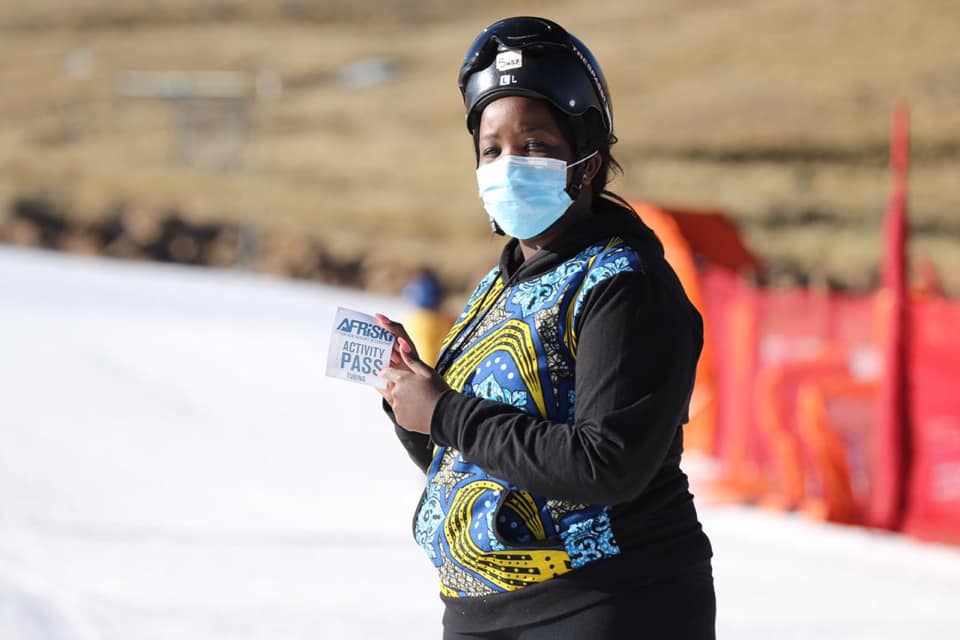
Queuing for the Lift
We should see an end to any scrums at the base of the lifts as social distancing measures are put in to place with spacings generally marked on the ground 6 feet/2 metres apart. It remains to be seen if resorts will offer extended opening times for lifts in peak periods in order to get enough people up the mountain.
Riding the Lift
Family groups and other groups that are already together are able to ride on chairs and in cabins together but otherwise, there’ll be social distancing with cable car/tram and gondola cabins as well as on chairlifts so the number of people getting in any individual cabin or on a chair will be dramatically reduced and face masks must be worn.
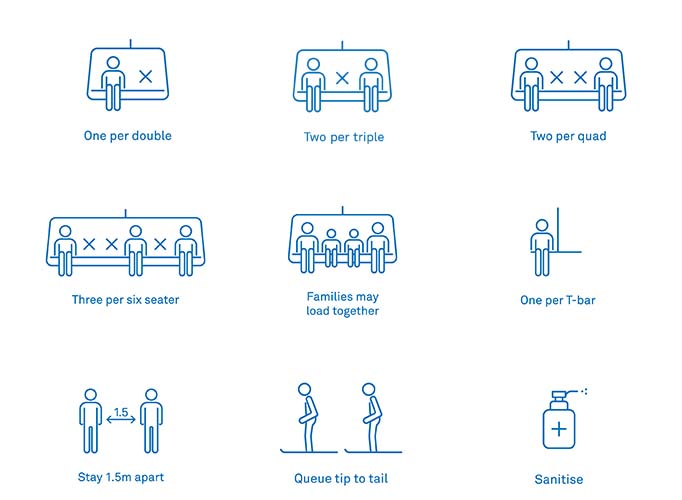
Ski Rentals
Some ski areas have re-opened but said that only those with their own equipment could visit and that rentals would not be available – another move to minimise the risk of virus spread.
Ski School
Some re-opened resorts aren’t offering group lessons, only private classes.
Temperature Checks
A large number of ski areas are now scanning foreheads for your body temperature as well as your lift pass to check its valid.
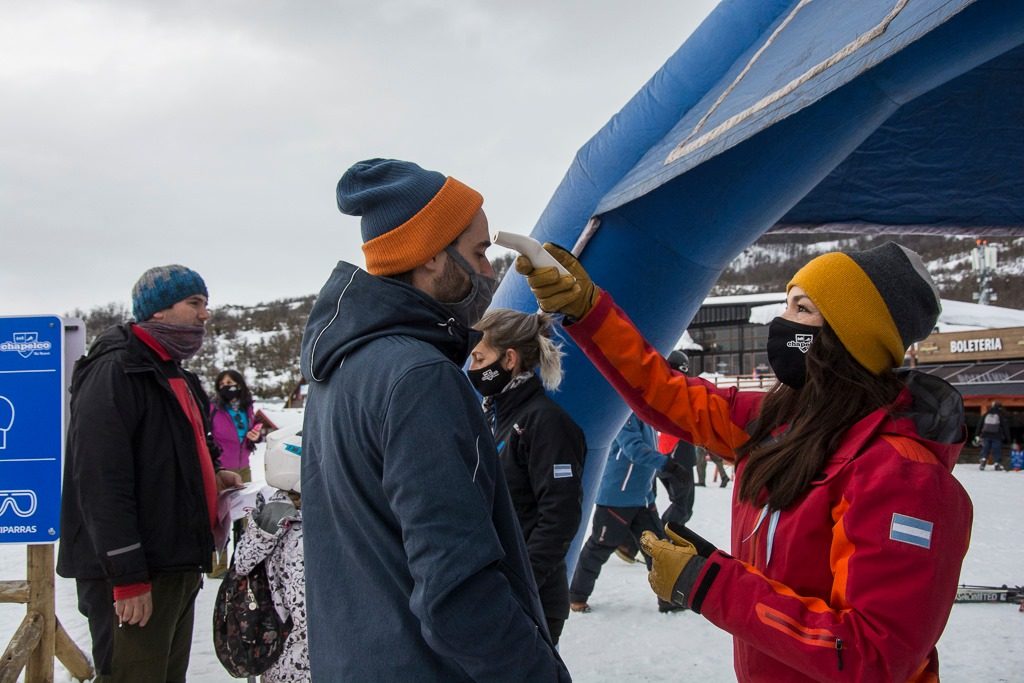
Toilets
In the early months of the pandemic a few smaller ski areas that have re-opened have said their toilets won’t be open in a move to reduce the risk of virus spread. More commonly others opened their toilets but with only one person allowed in at a time and social-distancing queuing outside, and of course lots of hand-sanitisers available.
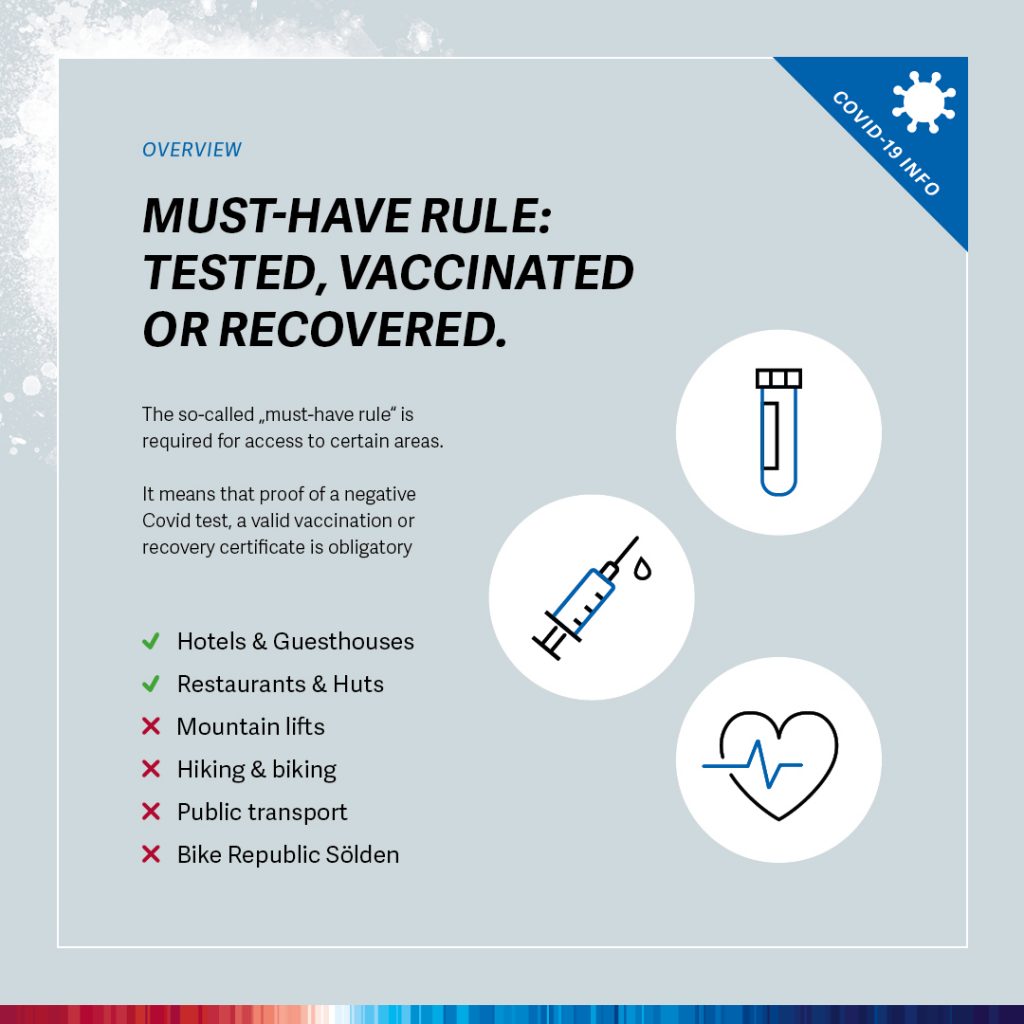
Vaccination Certification / Vaccine Passports
As the vaccines have begun to be rolled out some resorts have asked skiers to provide evidence of full vaccination as one of a number of pieces of evidence which can also include evidence of a recent negative test and/or resolved infection.
Virus Tests
With virus testing becoming easier, an increasing number of ski areas around the world are requesting skiers produce evidence of a negative test taken in the previous 24-48 hours, in order to ski. In some cases (Austria) it has become an official requirement with random checks on skiers to check they’ve got the test result. Some centres offer testing to skiers at the slopes.
Weekend Closures
A number of re-opened ski areas are closing midweek or at other times. Unusually in Chile when ski areas re-opened there the busiest open days at the weekend were ruled out in order to keep numbers on the slopes deliberately low.
Northern Hemisphere Ski Nations’ – Winters 19-20, 20-21, 21-22; summer ski season 2020 and 2021 and Southern Hemisphere Ski Nations’ – Winters 2020, 2021 and 2022 – Combined Archive Of What Happened in the Pandemic
Andorra
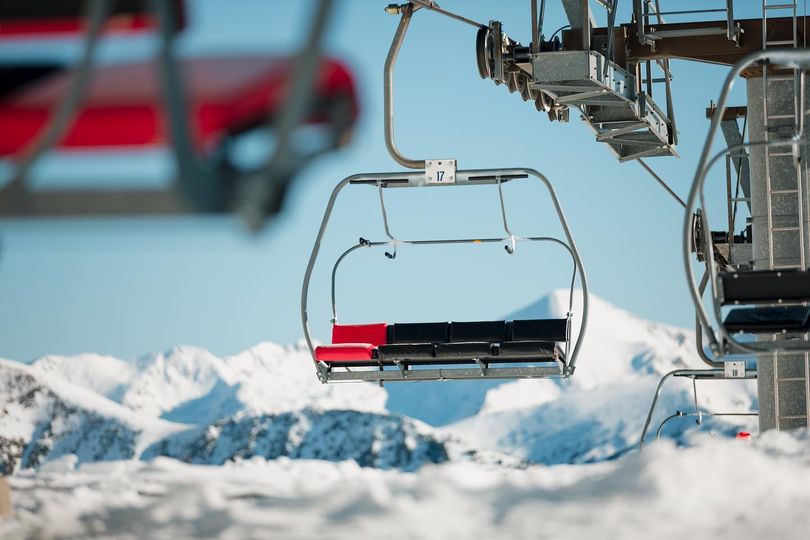
*** Updated 3rd May 2022 ***
Current status: Closed – End of Season.
Andorra Social Distancing Requirements: 1.5 Metres (60 Inches).
Andorra Ski Centres Currently Open: 0
Andorra’s 2021 – 22 Ski Season
Andorra’s ski areas got their first snowfall on higher slopes in late September, two months before resorts are expected to open at the end of November.
It was mostly dry and warm in October but more snow fell in early November and then heavy snow in the last 10 days of November gave a very positive picture for the start of the 21-22 season.
This began a few days earlier than expected on 30th November at Grandvalira. At the start of December it was announced that
Andorra required everyone over the age of 16 to have proof of vaccination, a negative test or a recovery certificate to access ski slopes.
As of the start of January Andorra has had one of the highest coronavirus infection rates in Europe but slopes remain open.
Brits can’t arrive via France at present due to being banned from travel through France but can enter via Spain.
Once travel re-opened through France in mid-January things gradually became more ‘normal’ and Andorra’s 2021-22 season continued through to late April as normal up to 2020.
Andorra’s 20-21 Season
Andorra kept its ski areas closed over Christmas and new year but allowed centres to open its ski areas for local skiers thon 2nd January. The opening weekend lifts ran free of charge in celebration.
The country said it expected few international guests during winter as it knew it would be difficult to visit.
The planned opening date had initially been set back to 19th December but on 3rd December it was announced ski areas wouldn’t open until January.
On 14th December it was then announced that Andorra’s ski areas were expected to open on January 3rd, 2021 but this wasn’t confirmed until a day before.
As of the start of April 2021 the country remained largely closed to international tourism. Those who could visit had to provide a negative test result on arrival.
Therefore few people could actually get to the open slopes and as a result only limited terrain was open, in order to stem operating losses, even though centres could probably be fully open if they had more business to justify it.
Snow cover was below average in spring and this combination meant centres closed soon after Easter Sunday.
Argentina
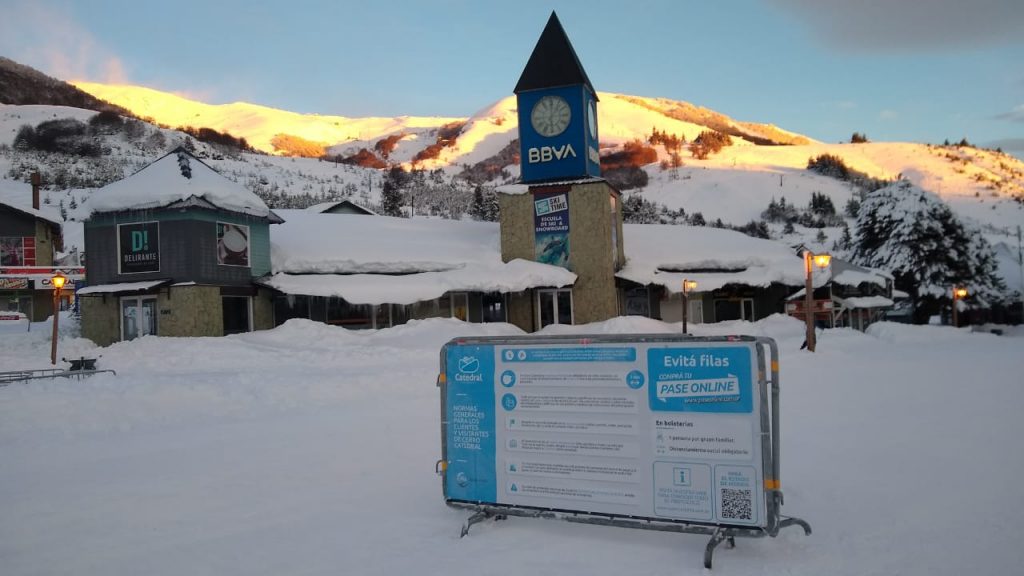
*** Updated 6 October 2022 ***
Current Status: All ski areas closed.
Argentina Coronavirus Operating Requirement:
Certificate of vaccination or having taken a negative test required. Mask must be worn indoors. Social Distancing 2 Metres (80 inches)
Argentina Centres Currently Open: 0
Argentina’s 2022 Ski Season
Argentina got record heavy early snowfall in late April – two months before the expected stat of the season. This allowed the country’s largest centre, Catedral, to have a record early opening in late April – for two days only.
It was possible to travel to Argentina this winter to ski from overseas for the first time since 2019. As of the start of June 2022 Argentina no longer requires proof of vaccine or COVID-19 tests. Travel to Argentina no longer requires proof of vaccine or a test. Medical travel insurance that includes hospitalisation, quarantine, and transportation coverage of COVID-19 is required.
The season began on 17th June and most of the country’s ski areas were open by the final weekend of the month. However snow cover declined in the latter half of June meaning most only had limited runs open. Snowfall picked up through the season to give one of the best on record. Resorts stayed open through to the start of September when they began closing as usual as temperatures warmed. All in all though a return to something closer to normality.
Argentina’s 2021 Second Pandemic Ski Season
Most ski areas in Argentina were able to open as usual in mid-late June. That did not happen in 2020 when most stayed close all winter and just a handful opened for the last month of the season from mid-August.
However at the time the position was unclear with less than a quarter of adult Argentinians vaccinated and infection levels rising again.
Unfortunately it was also the second successive winter when international leisure travel to Argentina is all but impossible. Early snowfall with a second fall around 9-10 June led to ski areas saying they’d be opening “soon”.
At the time South American experts Powderquest believed Las Lenas could be the first in the country to open on June 19th, it didn’t open in 2020 so this would have been the first skiing for some 21 months.
Chapelco: also had a tentative June 19th opening date with Cerro Bayo targeting June 21 and the continent’s largest resort Catedral Alta Patagonia (Bariloche) July 1st.
In the end no Argentinian ski areas had opened by June 20th however with most ski areas in the Andes saying they won’t open until at least the first week of July, some saying its due to inadequate snow cover.
Cerro Castor, the world’s most southerly full ski area did open for cross country skiing in late June and said the downhill ski season would start July 2nd.
There were still no ski areas open in Argentina for the last weekend of June but Caviahue said it planned to open on July 9th, the second area to confirm a date.
As of the end of June, expected opening dates weare: Catedral July 1st (according to some reports), La Hoya and Cerro Castor (July 2nd); Las Lenas, Caviahue, Chapelco and Cerro Bayo July 9th – most of these are now confirmed.
However Catedral did not open on July 1st posting only that “the season start gets nearer”).
By late-July most of the country’s ski areas had opened but many were reporting low snow cover and only have limited terrain open as a result. The continent’s largest centre, Catedral, had only beginner terrain open. Another major resort, Las Lenas, was still waiting more snow before opening.
As of mid-August Argentina’s La Hoya ski area has closed temporarily due to lack of snow cover. Several other ski areas in the country, including Las Lenas, were still yet to open this season for the same reason.
Heavy snowfall in the middle of August, at last, allowed centres to re-open or open more terrain if they were still open. Las Lenas remained closed however – although it groomed slopes and allowed sledging, but no lifts operated. By the start of September 2021, the final months of the ski season, most ski areas in Argentina, other than Las Lenas, were open and reporting excellent conditions.
Argentinian ski areas began closing for the season at the end of September with a few including leading area Catedral making it through to the start of October, unlike in 2020. All were believed closed by October 10th, 2021.
International leisure travel was allowed to resume to Argentina three weeks later on 1st November 2021 for the first time in more than 18 months. The past two season have been closed to travellers from outside South America but perhaps 2022 will mark the return?
What happened in Argentina’s 2020 ‘Pandemic Season’
Argentina had a strict lockdown in place from mid-March which appears to have limited the spread of the virus more effectively than in many other South American countries.
The lockdown was extended several times but was eased on a region-by-region basis from early August. About five Argentinian ski areas opened during August and September 2020, the last of these closing again for the season on 28th September.
Two more areas, Cerro Bayo and Cerro Castor announced they’d open to local skiers from Saturday, August 1st and Chapelco and other Argentinian ski areas have also now opened, Caviahue from 15th August.
Earlier in July when things began to ease slightly already at Cerro Castor down near Tierra del Fuego and the world’s most southerly developed ski area. It opening its resort base and ice rink to local people in the province and also allowed cross country skiing although until 1st August its lifts were not running and downhill slopes were closed.
Argentina’s ski-season would normally have begun in mid-June and usually runs to early October. Of the half-dozen ski areas that were open, centres began closing again for the end of the season from mid-September.
Cerro Castor closed on September 25th, Catedral on the 27th.
At the still closed ski areas in Argentina they were warning backcountry skiers during the winter and spring that they should not be hiking up to ski slopes in the Andes during the ongoing lockdown there. They warned there’d been no avalanche prevention measures and there are currently no rescue or medical staff on site whilst resorts were closed. As there had been a lot of snowfall, the avalanche danger was extreme.
Australia
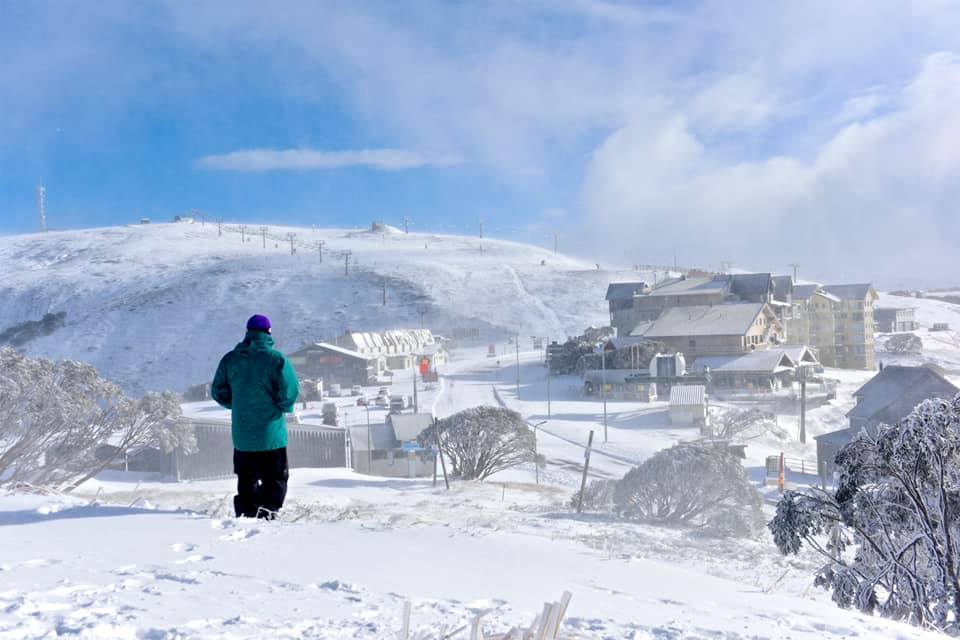
2020 was really a season like no other in Australia.
The country’s 2020 season got underway on 22nd June with Mt Baw Baw and Thredbo opening. This was a few weeks later than usual as Aussie ski areas normally open for the ski season around the first weekend of June, a national holiday weekend in the country. It lasted until 4th October when Perisher, the last area open, ended its season.
*** Updated 8th October 2021 ***
Current Status: Closed for season.
Australia Pandemic Operating Rules: Tickets Must Be bought Online in Advance, Social Distancing Requirement 1.5 Metres (5 Feet).
Certificate of having taken a recent negative test required. Mask must be worn indoors.
Australia Centres Currently Open: 0
The 2022 Ski Season in Australia
Australia’s ski season was due to start in June 2022 and for the first time since 2019 its hoped this will be a normal season, or closer to one, with eased pandemic restrictions and international arrivals possible again.
In early February Australia announced the reopening of its borders to vaccinated tourists and other visa holders from February 21st for the first time in almost two years, opening up the possibility of international skiers to return this winter after three seasons.
The country has had several pre-season snowfalls in April and May to raise anticipation levels further. Perisher began running more than 50 snowguns on May 19th.
There was heavy snowfall in late May and early June allowing five of the country’s centres to open a week earlier than expected, on 3rd June, and most of the other leading resorts did likewise, opening a week early on June 4th. Most are operating fairly normally but require masks be worn in some settings including on public transport.
The snowstorm continued for a week and became one of the biggest in the country’s history leading some resorts including Mt Buller to this was the best start to the season ever, for most others it was at least the second best. Ben Lomond in Tasmania opened a week early.
There was more snowfall but also some thawing in the latter half of June with ski areas in Tasmania closing again while bigger resorts opened more terrain.
Post-pandemic business was very strong as of the start of August with more snowfall and ski areas forced to turn around skiers as parking reached capacity at peak periods.
The season continued to be mostly excellent with all ski areas open into September and several posting 2m+ upper slope base depths at the start of spring, very healthy base depths. The season ended on 2nd October in Australia.
What Happened in Australia’s 2021 Season
Australia’s 2021 Ski Season Australia’s 2021 ski season began at most of the country’s ski areas on schedule on June 12th.
There was cold weather for snowmaking and some natural snowfalls in April and May 2021 ahead of the season.
Optimism was also high due to few virus cases, with some resorts reporting bookings the best in over a decade due to pent up demand after many missed out on winter 2020.
However on May 27th the state of Victoria went in to a 7 day lockdown after cases of the new Indian variant of the virus were found, heightening nerves.
This did end on schedule for all but capital Melbourne on 3rd June however.
On the 5th June it was announced that skiers and boarders in Melbourne are likely to miss the season start weekend due to lockdown and that government financial support approved for ski areas in Victoria.
From 8th June there were huge pre-season snowfalls in Australia perfectly timed for the start of the season at the weekend, with 60cm (2 feet) reported in the first few days. However Mt Baw Baw in Victoria said the precipitation there had unfortunately arrived as wet snow or rain causing damage and flooding so it would not be able to offer any snowsports for opening weekend. Most areas opened on schedule 12th June.
It was announced on 16th June that citizens of Melbourne needed to have had a negative virus test within the previous 72 hours to travel to ski centres once their current travel ban ended on 17th June.
Regional health officers say just one case making it to the mountains could create a “super spreader event.” On 25th June it was announced residents of Melbourne no longer need provide a negative virus test result to visit ski areas, but residents of some parts of Sydney now have a local lockdown due to an outbreak of coronavirus Delta variant cases.
There were then problems with virus cases in other cities, including Sydney, leading to local lockdowns impacting business for ski areas, but the ski areas themselves remained open.
Moving further into July more normal operations increasingly became the norm.
The quarantine-free travel bubble between New Zealand and the Australian province of Queensland re-opened on 12 July after Queensland recorded no new virus cases but remained closed with New South Wales due to virus rates in Sydney.
It was all change again within a few days though with Australia’s state of Victoria entering a new five-day lockdown (the state’s fifth lockdown) with ski areas closed to Tuesday July 21st, due to a pandemic spike.
The lockdowns continued to late July with Victoria’s extended to 28th July just as ski areas reported up to a metre of snowfall. Major cities in other states remained locked-down too.
But things were looking up at the start of August with Australian ski areas celebrating their best snow depth the start of August for 21 years, and more snow forecast.
Then on 5th August the state of Victoria, which currently has the southern hemisphere’s deepest fresh snow, announced another lockdown, believed to be its sixth, at short notice, starting today for 7 days and closing the state’s ski resorts again.
Things took yet another turn less than a week later when the state of New South Wales orders a full state lockdown for 7 days, temporarily closing the country’s largest ski area, Perisher, among others.
On 21st August Victoria announced its 8th lockdown, shutting ski areas there once again, until at least September 2nd. It’s believed to be the first time all major ski areas in Australia have been closed at the same time during the pandemic.
Small ski areas in Tasmania were now the only ones open in the country.
At the end of August the lockdown in Victoria was extended and is expected to continue until at least 23 September, very near the end of the season, when 70% of the population are expected to have had at least one vaccine dose. On 8th September it was announced ski areas in Victoria can re-open from Friday, 10th September.
On 16th September ski areas in New South Wales were also allowed to re-open.
On 30th September New South Wales announced a new 7 day lockdown leading to Perisher announcing it was closing early for the season. Most resorts had closed by 3rd October although Ben Lomond hoped to stay open later, however it later reported inadequate snow cover for skiing.
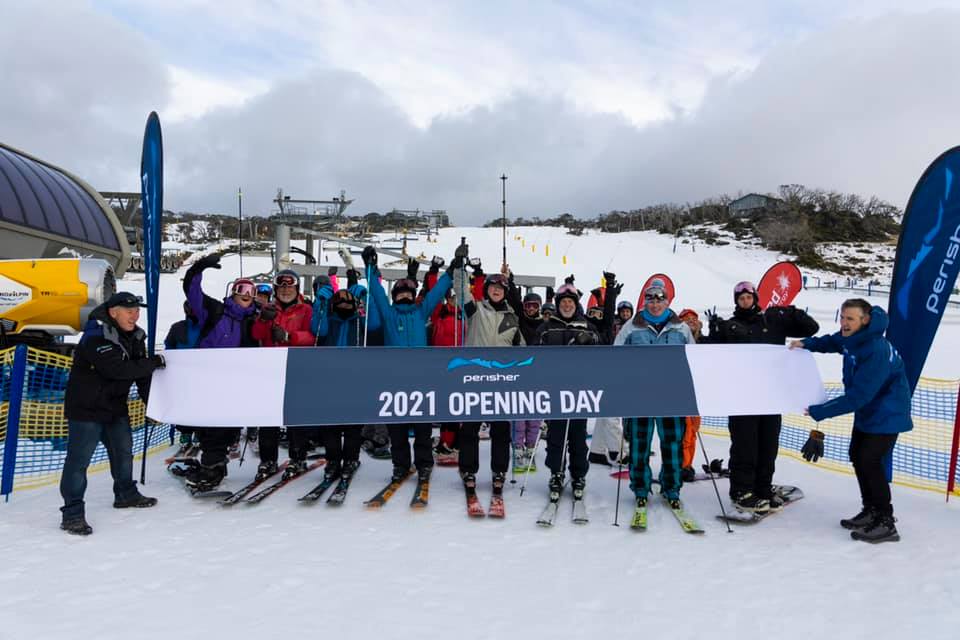
What Happened in Australia’s 2020 Ski Season?
In 2020 anticipation had been raised by huge autumn snowfalls at the start of May, with several smaller snowfalls and lowering temperatures afterwards. June was drier but the snow returned in early July. However overall it was one of the warmer winters.
n the last week of May the provinces of New South Wales and Victoria, where most of the country’s ski centres are, both announced centres could start their seasons from June 22nd as pandemic restrictions are eased.
The next areas to open were Mt Baw Baw and Perisher on the 24th with fellow Vail Resorts owned Falls Creek and Hotham initially saying they’d open on the 29th June but later delaying to 6th July due to limited early snow cover.
Charlotte Pass had company operated accommodation open from Thursday 25th June with the ski slopes open from Friday 26th June. So all of the country’s leading ski areas had opened by July 6th, other than Mt Selwyn which will remain closed during the season due to bushfire damage which destroyed lifts earlier in the year.
However from July 8th operations of ski areas in Victoria (Falls Creek, Hotham, Mt Baw Baw, Mt Buller) were in some doubt following a spike in cases around the city of Melbourne.
Residents from, areas of the city now in strict lockdown again who had bookings are being refunded payment and ski areas say they are reviewing operations. Falls Creek and Hotham initially closed again for at least 6 weeks to August 19th -about 6 weeks from the end of the season, but then decided to stay closed.
The state’s other two areas did stay open at that point though: Mt Baw Baw was opening weekends for snowsports and Mt Buller was open for much of July.
In an added twist, whilst operator Vail Resorts has closed the lifts at Falls Creek and Mt Hotham, the resorts themselves were still open, and other activities are available to people in Victoria, including back country skiing.
Pandemic-spread prevention measures meant the now-normal social-distancing and limited numbers on the mountain. Most areas operated at around 50% capacity and there was a 1.5 metre social distancing rule in place.
Thredbo initially put lift tickets on sale online on 10th June but had its site overloaded with more than 25,000 people trying to buy lift tickets in the first few hours they were on sale – so there was certainly demand.
There was another twist later in July as the pandemic in Victoria worsened and the state’s government reimposed restrictions meaning Mt Buller and Mt Baw Baw have had to close again.
This was reviewed on September 13th but Buller and Mt Baw Baw did not re-open, in part due to poor snow conditions after a warm winter.
Vail Resorts had already said Falls Creek and Mt Hotham won’t now re-open this winter though, whatever happened in mid-September.
In the meantime a short season began at Ben Lomond in Tasmania as there was finally adequate snow cover.
Thredbo ended its season on 22nd September citing poor snow conditions. It’s also worth remembering even before the virus was a known danger, one Australian area, Selwyn, had already ruled out opening in 2020 after it was destroyed by bush fires at the very start of the year.
Austria – The First Two Years of the Pandemic
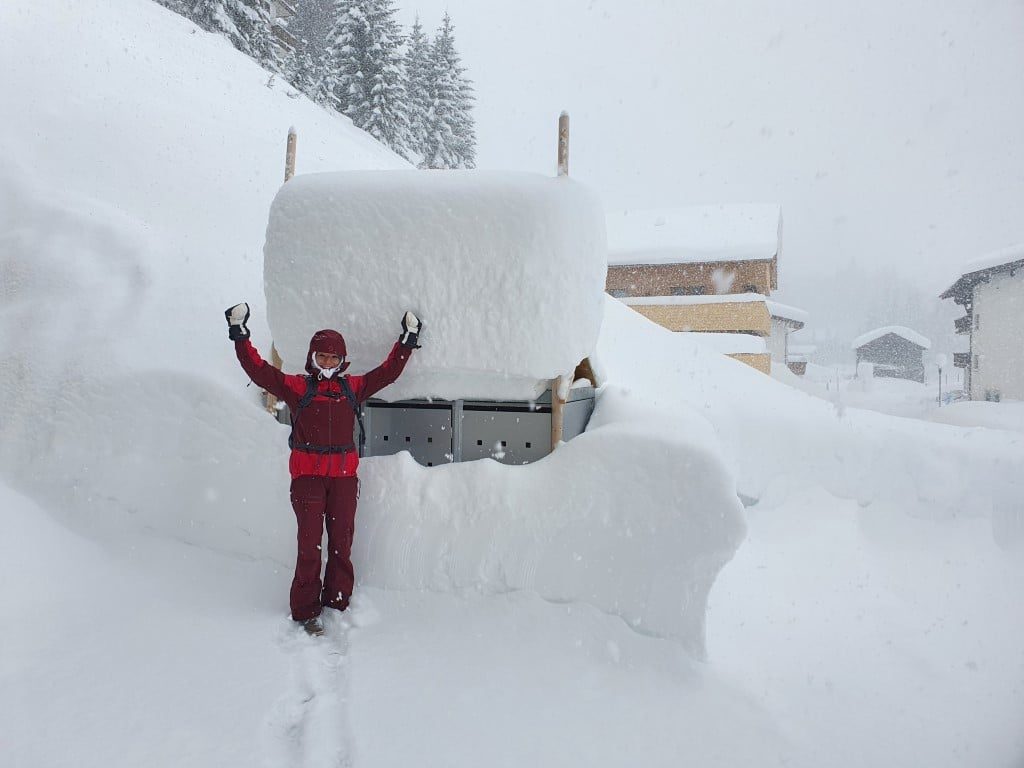
*** Updated 15th May, 2022 ***
Austria Social Distancing Requirement: 2 Metre (80 inches)
Austria Lifts Policy in 20-21: No limit on the number of people using lifts (eg 6 strangers can share a 6 seat gondola cabin), but everyone must wear masks. In most areas it must be a surgical quality mask and at many a recent virus test must have been carried out.
Austria’s Summer 2022 Ski Season
Austria returned to normal late spring and summer operations in 2022, with the Stubai and Kaunertal glaciers open to June, Kitzsteinhorn to July and Hintertux year round.
The Molltal glacier also resumed its more usual 11 month season, although it appeared to hint its ski lifts might not open straight away when it re-opens in mid-June. The Kaunertal and Stubai both closed a fortnight earlier than planned due to warm weather and the Molltal glacier announced it was not opening until September/October this year, rather than in May/June as usual.
June saw the Hintertux and Kitzsteinhorn glaciers operating in summer mode as normal, although reporting very high temperatures at times.
The Kitzsteinhorn closed a little earlier than expected leaving only Hintertux open at the start of July.
As of the start of August Hintertux was the only ski area open to the public in the Alps – the first time that has been the case. This continued through to the start of September with no fresh snowfall of note in August. Ski areas expected to open this month include the Kaunertal, Solden and Pitztal glaciers. It looks like they’ll need to rely on snow farming and/or all weather snowmaking.
There was some snowfall on the 16th-17th September however.
The 21-22 Season in Austria
Ski areas are open year-round in Austria. At the start of Autumn 2021 the Hintertux glacier was the only area open. It and other high glacier areas saw fresh snowfalls in late august and early autumn.
But Austria usually has a many ski areas open as the rest of the northern hemisphere combined by the end of September and Solden announced on 6th September it would open for the season three weeks earlier than expected, on Friday 10th September.
The Pitztal glacier said it would open a week earlier than planned, on the 17th and the Molltal and Stubai glaciers also planned to open mid-September but didn’t in the end. A sixth area, Kaunertal, did open as planned on the 25th.
On 7th September Austrian Health Minister Wolfgang Mückstein submitted a proposal to restrict nightclubs and apres ski venues only to those who have been vaccinated from October.
There was not much snowfall in September and the Stubai glacier delayed opening in to October which only happens one year in five.
The Molltal glacier also delayed re-opening. However a big snowfall in early October let to the Kitzsteinhorn and Stubai glaciers opening for the season on the 9th/8th October respectively and the Molltal announced it was re-opening on the 14th.
The Austrian government announced access to ski slopes in Austria this winter will be impacted by the level of COVID infections in the country’s intensive care wards. All will have access but if the numbers go above 400 people in ICU with COVID stricter PCR testing will be required from unvaccinated/not recently recovered skiers.
The same rules will apply for apres ski venues which will not allow unvaccinated people in if Austria’s ICU occupation rate goes above 300
people.
Solden staged the opening World Cup races of the 21-22 season on the 23rd/24th October, the first with fans allowed since March last year.
By the start of November nine areas were open including Kitzbuhel, using farmed snow from last season. The country saw big snowfalls of up to 60cm (2′) to start November.
On November 8th Austria tightened restrictions as cases surge so that only fully vaccinated skiers or those who have recovered from an infection can ski. Having a negative test result only is not currently enough. This new rule is in place for one month initially.
On November 18th Austria’s Salzburgerland province announced it was going in to a 4 week full lockdown from Monday 22nd November, closing ski slopes until Christmas week.
On 19th November Austria announced a 20 day lockdown from 22 Nov to 12 Dec to try to cut pandemic infection numbers. Ski resorts to close but the 20 days will be reviewed after 10 days.
On 23rd November it was announced it is allowed for ski areas to stay open to locals if they wish, but hotels and hospitality must close until December 12th. Around 6 areas have stated open.
At the start of December most Austrian areas say they would open for the season as normal in the coming weeks even if tourism remains closed.
The number of areas open in Austria jumped to nearly 50 over the weekend of 4/5 December with Ischgl opening for the first time since winter 2019-20 with the most terrain open in the Alps, over 120km.
The Austrian government said an announcement would be made on Dec 9th about ending or otherwise of the lockdown on December 12th.
Austria announced on December 8th that ski areas could re-open tourism from this weekend after a 20 day lockdown successfully halved coronavirus cases. Different provinces are making individual decisions.
Tirol ski areas could re-open from Sunday, Salzburg from a week on Friday (17th). Only vaccinated and recovered people could leave lockdown though.
On 22nd December the Austrian Government said arrivals from Denmark, Norway and the UK must be double-jabbed and had booster to avoid quarantine on arrival. All must take PCR tests too.
On 20th January it was announced that Austria has eased restrictions placed on arrivals from the, Denmark and a dozen other countries so restrictions are slightly less onerous and the same as they are to visit Austria from most other European nations again from Monday.
On 26th January Austria announced it was tightening the requirements for vaccination for arrivals from 1st February. Those triple jabbed are able to enter for up to 9 months after their booster but those only double jabbed can only enter Austria up to 6 months after their second jab. An infection recovery counts the same as a jab.
Austria then announced from 5 March the current COVID 19 measures there would be largely lifted. This means no capacity limits, no general curfew and reopening of the nightime economy.
Masks will then only be compulsory in essential shops (supermarket, post office, banks, pharmacies, etc.) and public transport. In all other places, there is still a recommendation to wear an FFP2 mask in closed rooms.
On 21 February it was further announced COVID 19 travel measures will be largely lifted in Austria over the coming weeks, the country’s government announced.
This means that travelling to Austria gradually became less complicated from 5 March at the latest. From 19 February gradual relaxations came into force in all major settings where the 2G rule (vaccinated or recovered) had applied.
From then the 3G rule (vaccinated or recovered or tested) applied in cable cars, on bus trips, in hotels and restaurants, in spa and gyms as well as at events. The midnight curfew and the ban on night-time catering did remain in place, and the general requirement to wear a mask indoors also remains in place.
As of 22 February, the entry regulations to Austria are also being relaxed with a general 3G rule now applying to all countries and no testing required.
From 5th March, all measures were largely be dropped with no entry regulations for entering Austria, and no curfew. Masks were only be required in ‘vital businesses’ (supermarket, post office, banks, pharmacies, etc.) and public transport although in all other places, there is still a recommendation to wear an FFP2 mask in enclosed spaces.
Most ski areas made it through the their traditional April or May closing dates. Ischgl reported 21-22 season business was down 25% on pre-pandemic levels but says with the start of the season lost due to lockdown this is a better result than they hoped.
Austria in Summer 2021
For the start of May it is glacier ski areas open including Hintertux, the Kitzsteinhorn and the Pitztal, the latter staying open later in spring than usual.
It was announced on 23rd April that the country’s hospitality industry could re-open from 19th May. The Kaunertal glacier announced it would re-open from 15th May and the Molltal Glacier said it would from 22nd May, after both had been closed all winter due to pandemic operating restrictions.
The Stubai glacier initially said it would open in to June, then cut that back to a May 2nd closing day, but most recently switched back to offering Friday-Sunday operating to mid-May.
When hospitality re-opened in the end there were seven glaciers open at the end of may as the Stubai further extended its season, along with Pitztal; the Dachstein, Kaunertal and Molltal glaciers re-opened and the Hintertux and Kitzsteinhorn stayed open. June 6th saw the Kaunertal, Stubai and Pitztal glaciers close for the season.
Austria announced on 17th June that it is easing its pandemic restrictions removing the requirement for social distancing and the need to wear medical grade FFP2 masks in most situations from the beginning of July. However more basic face masks must still be worn.
In July Hintertux, Molltal and Kitzsteinhorn glaciers were open for downhill skiing and the Dachstein also open, with ever fewer pandemic restrictions in place and international travel within much of Europe increasingly possible. Kitzsteinhorn closed at the end of the month and the Molltal Glacier announced it was temporarily closing from August 2nd due to the snow cover melting from its glacial ice.
As of the start of September only the Hintertux glacier is open for skiing and boarding in Austria. It and other areas above 2,500 metres have been reporting repeated snowstorms over recent weeks. More Austrian resorts including Kaunertal and Pitztal plan to open later this month and Molltal to re-open.
Winter 20-21 In Austria
Austrian ski areas were planning for fairly normal operation for winter 2020-21 with centres saying they’ll open as normal and no limits beyond normal limits on the numbers who can use individual lifts or access the mountain.
However on 31st October the Austrian president announced a November lockdown which means the nine (mostly glacier) areas that had opened already had to close again. This was later (on December 2nd) extended through December with ski areas able to open from December 24th.
However initially this was for locals only and with a full medical standard face mask required. Most Austrian ski areas don’t usually open until December anyway so there were not great concerns in November although aa few like Obergurgl, Obertauern and Ischgl which open in November had to delay doing so.
Hotels and restaurants were initially closed until 7th January, 2021 but this date was later extended to January 18th then January 24th. Re-opening for winter tourism is now tied to a return to lower levels of infection rates.
Hundreds of Austrian ski areas did open to locals from 24th December, with new, more stringent pandemic operating restrictions including the requirement to wear surgical standard face masks (not just Buffs) and limit numbers on lifts. A few big names including Ischgl and Saalbach delayed opening as they said they had logistical issues or costs were too high compared to likely income.
Many other areas have struggled to stay open with some closing again reporting few skiers able to visit and mounting losses as as result. On 17th January the Austrian government have announced the hard lockdown there would be extended a further three weeks until at least 8 February 2021.
At that point they hope there will be small loosenings of restrictions but hotels and restaurants are expected to remain closed until at least the end of February. Ski areas will remain open to local people.
On 2nd February the Austrian government announced restrictions would be gradually eased if virus rates continue to decline, however delayed a decision on restarting tourism for a further two weeks. Tirol saw a jump in cases in early February leading to concerns about another lockdown, but that was averted. Resorts initially had to deny reports that a negative COVID test was now required to get on the slopes, which wasn’t true ….until 15th February when that rule was brought in.
It led a number of resorts including Solden and St Anton to decide to close until restrictions ease. As of the start of March Austrian resorts remained open to local skiers but it has been announced that hotels won’t open and tourism restart until at least Easter. St Anton and Solden have re-opened, however the Skiwelt region has announced it is ending its season early. A number of ski areas are offering on site virus testing.
On 3rd March Ischgl announced it wouldn’t now open at all this winter.
In Mid-March Austria announced plans to gradually re-open its society and tourism attractions. First up will be a pilot opening of restaurants, cultural and sports facilities from next 15 March just in the province of Vorarlberg, home to ski areas including St Anton. If that goes well outdoor restaurants will be allowed to reopen from 27th March. If infections do not increase, “The goal is to open culture, hotels and gastronomy in April,” Austria’s chancellor Kurz said, warning, “But no one can predict the infection pattern.”
At the start of April most Austrian ski areas were open through the Easter weekend but many then closed.
What Happening in Austria in the Autumn Before Its Second Lockdown
Normally about half- the ski areas open in Europe until the winter starts are in Austria with glaciers opening in September and October and that was the case this year too.
In mid-November the Austrian Chancellor extended the country’s lockdown to December 6th and there are now concerns that a pan-EU move to delay all ski areas opening until January may come in to force.
Earlier in the autumn warm weather slowed the rate of autumn glacier openings but the Pitztal glacier opened on 19 September, joining year-round Hintertux, with the Kaunertal and Solden glaciers opening a week later and more joining them from early October with heavy snowfall up high helping a lot and giving great conditions for early autumn.
Hochkar opened briefly in October due to the snow (first without a glacier) then Kitzbuhel used snow farming to open from 24th October.
What happened in Austria during the first 6 months of the pandemic?
Austria was one of the first major ski nations to ease their lockdown. They announced in April that ski touring could resume on May 1st although then asked people not to go ski touring due to their potential medical need at a time of pandemic, and high avalanche risk.
They then said ski lifts could re-open from May 29th and initially three of the country’s glacier ski areas: Hintertux, Kaunertal, Kitzsteinhorn re-opened on that date.
The Molltal glacier also began its (usually) 11 month ski season on 6th June. This is a few weeks earlier than the Molltal’s usual ski season opening date which is in the later half of June most years – one of the world’s longest. We say “usually” because on August 16th this year the Molltal glacier ended its summer ski season.
The Kitzsteinhorn announced on 27th May that their area would include a small terrain park. The Dachstein glacier has also been open again since May 29th – but will not offer snowsports until the autumn.
The Kaunertal had a short re-opening though, running for only 9 days to the scheduled end of its 19-20 season, June 7th.
Bulgaria
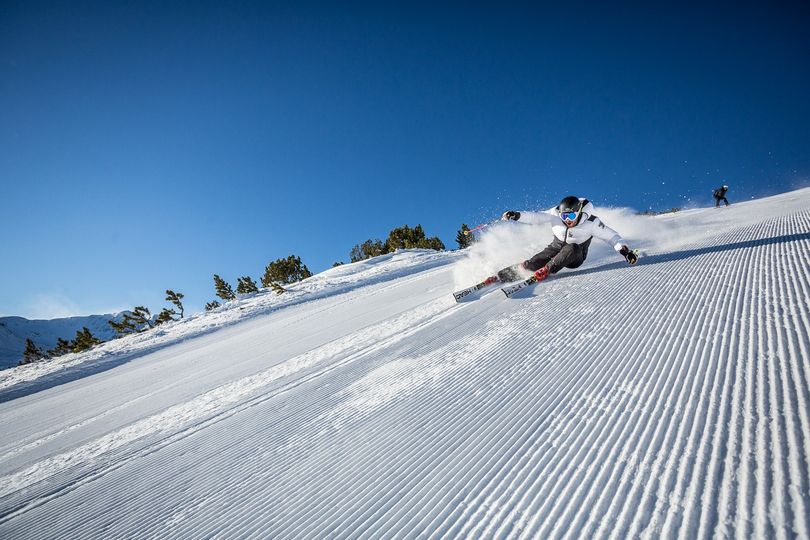
*** Updated 23 April 2021 ***
Current situation: All Bulgarian ski areas closed – end of season.
Bulgaria social distancing requirement: 1.5 metres.Bulgarian ski areas currently open: 0
Bulgaria’s 21-22 Ski Season
Bulgaria’s ski season begins in late autumn. There was already snowfall on mountain tops in October. Much of November was warm and dry but temperatures dropped and snowmaking systems fired up at the end of the month.
Early December saw more snow with the first centres opening on December 11th.
On 4th January, 2022, Bulgaria became the latest country to require a negative PCR test taken prior to arrival from its red list countries which currently include most European nations.
On 30th January Bulgaria announced a lifting of restrictions on red list countries effective from 1st February.
The 20-21 Season in Bulgaria
Ski areas there reported weather was cold enough for snowmaking in late November and that they hoped to open in December.
However the country’s health ministry was also reported to be looking in to resorts opening. The tourism minister said on 26th November the country rejected calls from France, Germany and Italy to close all EU ski slopes until January 10th and expected ski areas to open shortly before Christmas.
On 14th December Bansko announced they would open for the season on Thursday, 17th December and most of the rest of the country’s other ski areas opened by the end of the year and have so far stayed open.
Bulgarian ski areas remained open through January and ski holidays here are still possible from some countries but the country did introduce a requirement that new arrivals had a negative virus test within 72 hours of arriving in the country from late January.
On 24th February Bulgaria’s PM announced restaurants could reopen from 1st March, nightclubs from 1st April.
Having dramatically eased restrictions at the start of March, the country saw a spike in virus cases by the middle of the month and entered a new 10 day lockdown with restaurants and most shops closed from 22nd March.
No visitors from the UK will be allowed until after the end of the ski season as the country tries to avoid exposure to the English variant of the virus. However no leisure travel from England to Bulgaria is allowed until at least late May anyway.
All Bulgarian ski areas closed mid-April although Borovets re-opened some slopes for a bonus weekend at the end of the month.
Canada
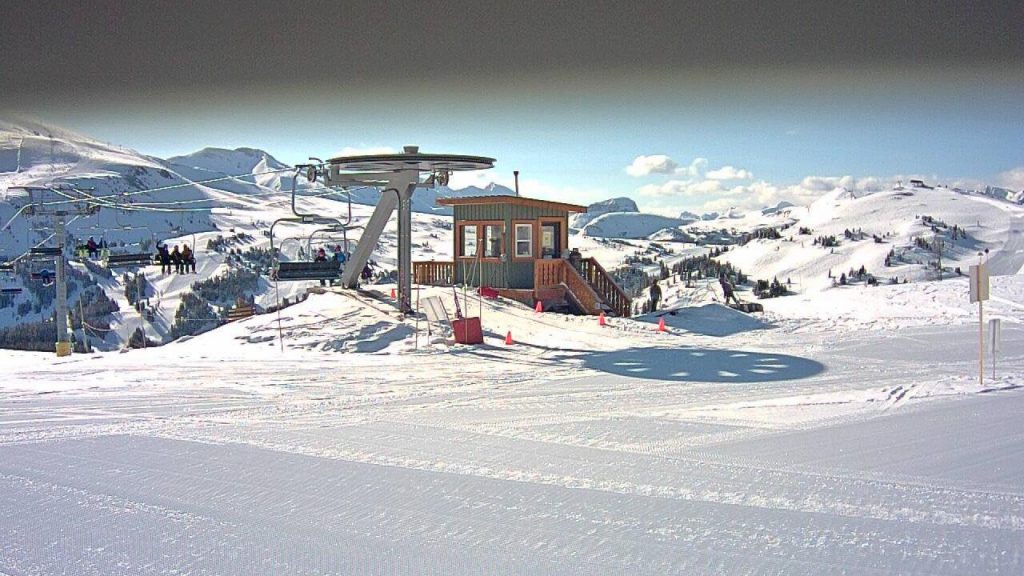
***Updated 6th October 2022 ***
Canada Entry Requirements Current Info:
https://travel.gc.ca/travel-covid/travel-restrictions/covid-vaccinated-travellers-entering-canada
Canada Social Distancing Requirement At height of Panemic: 2 Metres (80 inches)
Canada’s Summer Skiing and Boarding in 2022
Summer skiing and snowboarding is possible again on the Blackcomb glacier above Whistler in BC from this weekend. It’s the first time that the glacier has operated in late spring/early summer for snow sports since 2019.
It was possible for it to operate during the pandemic and other facilities in Whistler were open, leading to fears summer skiing and boarding were being dropped altogether until this year’s re-opening was announced. The centre is due to operate for just over a month, to mid-July.
However there is a change from before with the glacier exclusively reserved for private ‘summer camp’ ski and boarding schools’ use, not public access. “Ski and Snowboard ability level must be advanced to expert, no exceptions. Skiers/Riders must be able to ride on T-bars, there is no chairlift on the glacier. No singles on T-bars during busy periods, which is most periods.
Conditions may vary throughout the day, so be prepared. Bring sunscreen, goggles, sunglasses, gloves and a jacket as the weather changes quickly in the alpine,”
Whistler.com advises campers. Mt Washington on Vancouver island re-opened unexpectedly on 18-19 June for those two days only to celebrate Father’s day. It was their first June opening since 2011.
There was fresh snowfall in Western Canada in late June leading Sunshine near Banff to announce it would re-opening its slopes for the week around Canada Day on 1st July for the first time since 1991. The Blackcomb glacier ended its summer ski season for campers in mid-July.
Apex resort was evacuated due to a wildfire threat in early August. Canada re-introduced random testing at four of its international airports in late July – those used mostly by skiers in Alberta, BC, Ontario and Quebec.
The UK’s largest tour op said this has led to a dip in sales for ski holidays in 22-23. Canada’s snowboard team were reported to be training at Thredbo in Australia in August/September. Snowfall was reported in Alberta and BC in mid September.
Canada’s 21-22 Season
On 23rd July, 2021 the Government of Canada announced that the Canada-US border will re-open to fully vaccinated US travellers on August 9, 2021 and intends to further re-open to all fully vaccinated travellers from other international countries on September 7, 2021 for recreational travel.
Canada’s 2021 – 22 Season Canada began re-opening international borders in late summer 2021 but the process has been hampered by growing case numbers. However the country’s borders did re-open to international travellers after 18 months on 7th September. Snow was reported falling up high in the Canadian Rockies from late August. At the same time BC region tightened coronavirus opening restrictions. requiring mask wearing indoors for children down to 12 years of age.
Lake Louise initially named the earliest target opening date of 29th October but have since moved that back to November 5th. Snowfall has been increasing and falling to lower levels as temperatures drop through October. Ski areas are reporting issues securing adequate staff for the season due to delays in international work visas.
A number of Canadian resorts including Fernie, Kicking Horse, Kimberley, Nakiska, Norquay announced at the start of November that only fully vaccinated people will be able to use their ski slopes this winter.
This was inline with public health guidelines in Alberta and BC which allow them to operate at capacity if everyone is vaccinated. This move began to be adopted by resorts across the country with centres in Quebec in the East also announced everyone has to be fully vaccinated to ski there.
Banff ski areas Lake Louise and Mt Norquay were first in the country to open on 5th November. On 7 Nov several BC resorts including Revelstoke and Grouse mountain said all skiers must be fully vaccinated to get on slopes, but Whistler and Big White say they won’t at their resorts.
The first ski areas opened in BC (Cypress, Sun Peaks) on 20th November, and the first in Quebec (Sommet St Sauveur) too.
At the start of December Canadian ski resorts in Alberta and Eastern BC were posting the most terrain open anywhere in the world.
It was also seeing the most snowfall in North America. Canada introduced a requirement for arrivals to have a recent negative virus test as well as being fully vaccinated in response to the omicron variant at the start of December.
This caused some confusion with some arrivals required to quarantine at an airport hotel until they got a clear PCR test, others allowed to proceed to their resort hotel before needing to do so.
In late February Canada announced that from Monday 28th February fully vaccinated travellers will no longer be subject to mandatory arrival testing. Instead, all fully vaccinated travellers arriving (from any country) will be subject to the random arrival testing program which has been in place since
Canada re-opened its borders back in August. However travellers who get selected for the random arrival testing will no longer have to quarantine while awaiting their test results.
What Happened in Canada’s 20-21 Ski Season?
Western Canada’s ski centres saw cold temperatures and heavy snowfall in October 2020 leading Mt Norquay at Banff to announce its earliest ever opening and be the first in the country and second in North America to open for 20-21 on Saturday 24 October.
Lake Louise was the second Canadian area to open, a week earlier than planned and also its earliest ever opening date, on 29th October. Nakiska had planned to open on the 30th October but switched to 6th November and eventually opened on the 7th. Sunshine opened on the 9th and Panorama has opened to ski racers for trainers but not at that point to the general public.
Next to open around the weekend of 13-15 November were Marmot Basin in Alberta, the fifth in the province, and Cypress Mountain in BC, the first in the country’s far west. More areas including Big White and Sun Peaks opened soon after.
In the East of the country Mont Sainte Sauveur was the first area to open, on 30th October, following cold weather for snowmaking there. It began night skiing on the 6th November.
A warm spell followed which delayed other eastern areas opening, but it’s now cooler again. Canadian ski centres are operating with pandemic restrictions in place, stricter than in Europe including fewer people on the mountain, on lifts, social-distancing and the rest.
Pandemic restrictions were intensified in December with (among other measures across the country) non-essential travel bans in provinces including BC leading to prosecutions of skiers travelling to resorts from cities.
On 15th December a cluster of 60 confirmed coronavirus cases was uncovered at Big White ski area. This later grew to well over 100, although cases were reported to be in isolation and the ski areas remained open, and a smaller cluster was uncovered at Nakiska.
At the end of December Ontario became the first region in North America to announce ski areas must close during their latest lockdown in January. Rising rates and tough restrictions have lead to fears that Quebec would also close its ski areas but to date that has not happened.
In early February Ontario’s government said they hoped to open resorts imminently and did so in the middle of that month. As of the start of April most Canadian ski areas were fully open and operating successfully under pandemic protocols.
Most Canadian areas had closed, largely as normal for the springtime end-of-season by mid-April. Whistler, it transpired, had over 200 cases of the Brazil variant with BC as a whole having the highest number found anywhere outside Brazil.
Some ski areas including those around Banff and Jasper in Alberta as well as Sauveur in Quebec are still open in to May, with Sunshine the only centre still open after May 2nd.
What Happened in Canada During the First 6 Months of the Pandemic
Most of Canada’s ski areas would normally have closed by the time the country eased lockdown in June. Just one, Whistler Blackcomb, normally offers glacier skiing through to early July in a normal year.
Mont St Sauveur in Quebec has opened a summer terrain park in recent years using snow left from the previous winter and they confirmed on May 20th that they had snow left in 2020 and would open the snowpark if Quebec’s lockdown is eased in time. However in the end that did not seem to happen.
At the start of March Ski resorts in Ontario began easing restrictions as the province has removed the need to prove skiers are vaccinated to be allowed on the slopes.
Capacity restrictions are also being removed. However masks continue to be required at all times, whether indoors, in lift lines or while on the lift as well as in restaurants and social distancing is still required except with family groups.
On 11th March it was announced that ski areas in BC no longer have to require that skiers wear masks at indoors.
On 1st April Canada announced fully vaccinated skiers and boarders can now travel there without needing to take a covid test. By the start of May just a handful of ski areas remained open, most others having ended their seasons normally.
Chile
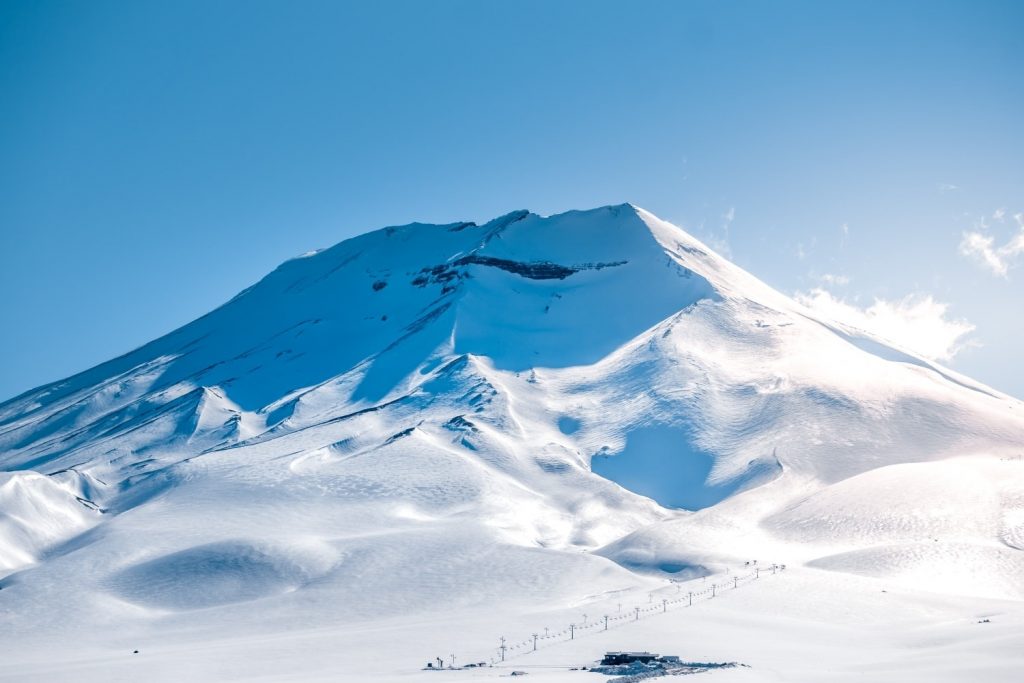
*** Last Updated 16 October, 20220 ***
Current Status: Most ski areas closed for season, some still open.
Chile’s pandemic operating requirements: Certificate of having taken a negative test required. Mask must be worn. 2 Metres (6.6 Feet)
Number of ski areas currently open: 0
The 2022 Ski season in Chile
Chile announced in February that international tourism will be possible this coming ski season for the first time since 2019.
Excitement levels rose further with good pre-season snowfalls in late April.
Late May and then early-June saw more good snowfalls for Chile, raising hopes for a good start to the 2022 season.
Ski areas began opening from 17th June with Portillo opening a week early on the 18th. Up to 90cm (three feet) of snow was reported lying.
Most of the rest of Chile’s ski areas had opened by the end of the month.
Some covid restrictions remain in place in Chile including mask wearing indoors where social distancing of more than a metre is not possible and contactless payment by card where possible.
However overall ski areas reported a good 2022 season as a whole, with above average snowfalls/cover for much of the season.
Ski areas started closing in early September with Portillo one of the first of the big name resorts in the southern hemisphere to do so on 18th September.
The last areas open in Chile closed for the season a month later on 16 October 2022.
The 2021 Ski Season in Chile
Chile’s ski season was due to begin in mid-June. The earliest known opening date announced was June 19th. Ski areas were more optimistic that this winter would be different to 2020 when few areas opened at all and those that did only for a month from August at the end of the season.
This year however Chile was one of the world’s 5 leading nations for vaccine roll-out with most of the population vaccinated. However some areas were still subject to local lockdowns which could keep individual areas closed.
Indeed on 7th June El Colorado announced that the country’s Phase 1 (Total Quarantine) has been decreed for its local area so it could not open as hoped, but would do as soon as conditions allow.
On June 8th specialists PowderQuest reported Portillo had delayed opening to July 17th (later extended to at least July 31st, then August 14th) with Corralco the only centre to name a possible opening date at that point, delayed from June 18th to June 25th due to inadequate snow cover.
By June 20th though no areas had opened and most ski areas in the Andes were now saying they wouldn’t open until at least the first week of July, some saying its due to inadequate snow cover, others local lockdowns.
One of these, Valle Nevado said it couldn’t open due to a local pandemic lockdown in its area. As of the final weekend of June there were still no ski areas open in Chile, but some areas did open, starting South America’s ski season, in the final days of the month.
Corralco, El Colorado and Valle Nevado opened on June 29th and 30th. Mosty other areas o[pen in the first 10 days of July with Nevados de Chillan opening (beginner terrain only) on July 1 and la Parva July 5th.
For Valle Nevado and Nevados de Chillan this was their first opening for two years. Portillo remained closed. On 25th July Portillo announced it would stay closed to at least August 14th as the country delays re-opening international borders, which it had been hoped might happen at the start of August.
The first half of August saw warm, dry weather leading more resorts to temporarily close due to lack of snow cover, awaiting a big snowfall.
That snowfall did arrive, finally, in the last week or so of August allowing centres to re-open. Surprisingly Portillo also opened, to locals only, after saying it wouldn’t open at all this winter.
Ski areas began ending their seasons in mid-September and by the last weekend of September most had closed, the last on October 10th.
International leisure travel was allowed to resume to Chile on 1st November 2021 for the first time in more than 18 months. The past two season have been closed to travellers from outside South America but perhaps 2022 will mark the return?
Chile’s 2020 Ski season
Chile’s season usually starts in mid-June but the country has been is a strict lockdown since the autumn which only began to be slightly eased in mid-August.
The last of the three ski areas that re-opened there in late summer ended its season on 11th October 2020. There were signs from the start of August that ski areas might be allowed to open and resorts have been stressing they have so much snow they might be able to stay open until November – if they did get the chance to open.
Some started opening to non-skiing day visitors although lifts and runs remained closed, then on the 11th August the government announced some areas could open with restrictions.
La Parva was the first to say it would do so, to season pass holders only, from the 18th August, El Colorado followed on the 19th. A third, Corralco, opened on 29th August, Others said the remainder of the ski season was so limited and their costs to open so high with all the COVID related restrictions it was not worth them opening for the remainder of the 2020 season.
Ski areas were only open to local people with season passes or similar, and unusually they were not allowed to open at weekends. Other measures at resorts that have reopened including cutting hill capacity by up to 70%, only one person per chairlift seat, limits on numbers in mountain restaurants and so on.
In the end only the three areas opened in Chile in 2020. La Parva was the first of the three to end its season, on 25 September, followed by El Colorado on the 4th October and finally Corralco on the 11th October.
Earlier in the Pandemic in Chile
The initial three month state-of-emergency began in mid-March but in mid-June the government announced a further three month extension to mid-September, the end of the ski season.
The country has unfortunately been one of the hardest hit in South America and the entire world by the virus – in terms of known infections. Portillo said in mid-June that it has proactively set is planned opening date back about a month to July 18th and was offering 100% refund guarantee or free re-booking for 2021 for those who want to reserve a place in the hope that they would be able to open then.
However on June 23rd it announced it had suspended its opening date indefinitely” – until it had “better news” on being able to open.
In May Chile’s Asociacion de Centros de Ski de Chile, an association of 12 of the country’s resorts, put together proposal on the safe operation of ski lifts and other facilities during the pandemic.
It organised a Webinar with senior tourism staff from the Chilean government in late July – stressing that it had a plan to operate ski areas safely in terms of the pandemic, and the need for skiing for good physical and mental well-being, as well as economic reasons.
China
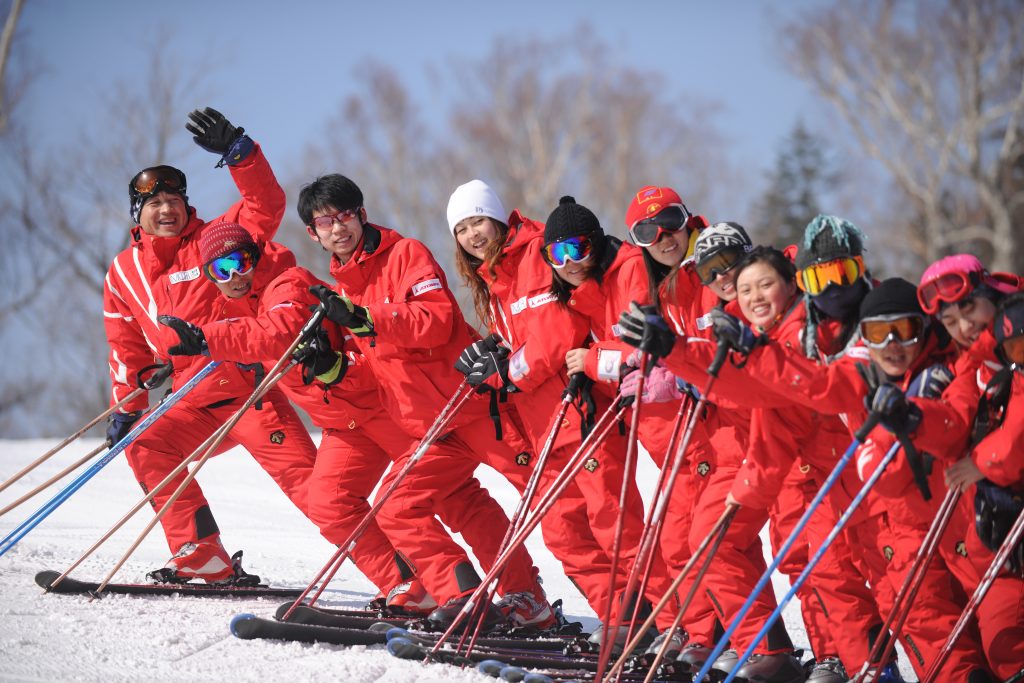
*** Updated 17th May, 2022 ***
Current status: Closed – End of season.
China Social Distancing Requirement: 1 Metre (40 inches)
China Ski Centres Currently Open: 0
The 2021 – 22 Olympic Ski Season in China
The Keketuohai International Ski Resort in Altay prefecture in Northwest China’s Xinjiang Uygur autonomous region was the first to open in the country for the 21-22 ski season, on 1st October, following a heavy snowfall.
It’s believed to be the first ski area in Asia to open for the 21-22 season – Winter Olympic season in China – and means ski areas are currently operating on four continents. Conditions for opening day were foggy. It’s four months until China hosts the 2022 Winter Olympics.
Some Western Political figures are calling for a boycott of the games due to the treatment of the Uighur Muslim ethnic group in the Xinjiang region as reported by Amnesty International and others.
Altay Prefecture also claims to be the place where skiing may have first been practiced 10,000 years ago, finding cave paintings which appear to depict skiers there. On 23rd October China’s Wanlong ski centre opened for the 21-22 ski season which is due to see it host the snowboarding parallel slalom at the 2022 Winter Olympics and Paralympics next February.
Heavy snowfall was reported in early November, allowing more centres to open with three months to go to the start of the Olympics. China’s borders however remain closed. The snowfall around 8th-9th November was the heaviest for 75 years in some regions of the Northeast.
Ski areas continued to open through November and December although borders stayed closed. In mid-December it was announced that ski areas hosting Olympic competitions in February and Paralympic events in March would close for three months from the start of the new year.
What Happened in China in the 2020-21 Ski season?
With the Winter Olympics only a year away, China is getting ever more excited about winter sports and keen to out the virus behind them. Several of the country’s leading ski areas including Wanlong and Thaiwoo opened first runs using snowmaking in late October.
Another area was reported to have opened in late September. Most ski areas were reported to have opened across the country’s ski regions by the end of 2020, all with pandemic-spread prevention measures in place.
January 2021 was thankfully very different to the mass lockdown and resort closures of January 2020 therefore with no reports of any ski areas being required to close.
Ski areas continued to operate through February and March without any major incidents reported internationally. As of the start of April most ski areas in China were closed due to springtime weather thawing snow cover.
Some of the more snowsure continued to operate in to May however. Unfortunately though test events ahead of the 2022 Winter Olympics due to be staged in February 2021 had to be cancelled due to international travel restrictions, as they were in 2020, so it appears the Olympics will arrive without international test events having been staged – a first for a Winter Olympics in the modern era.
What Happened in China During Winter – Spring 2020
China was where it all began of course and the country’s ski areas were closed and the country largely in lockdown from mid-January to mid-March.
It also became the first country where ski areas re-opened in the latter half of March, but with numerous pandemic-re-emergence-prevention measures in place.
Czech Republic
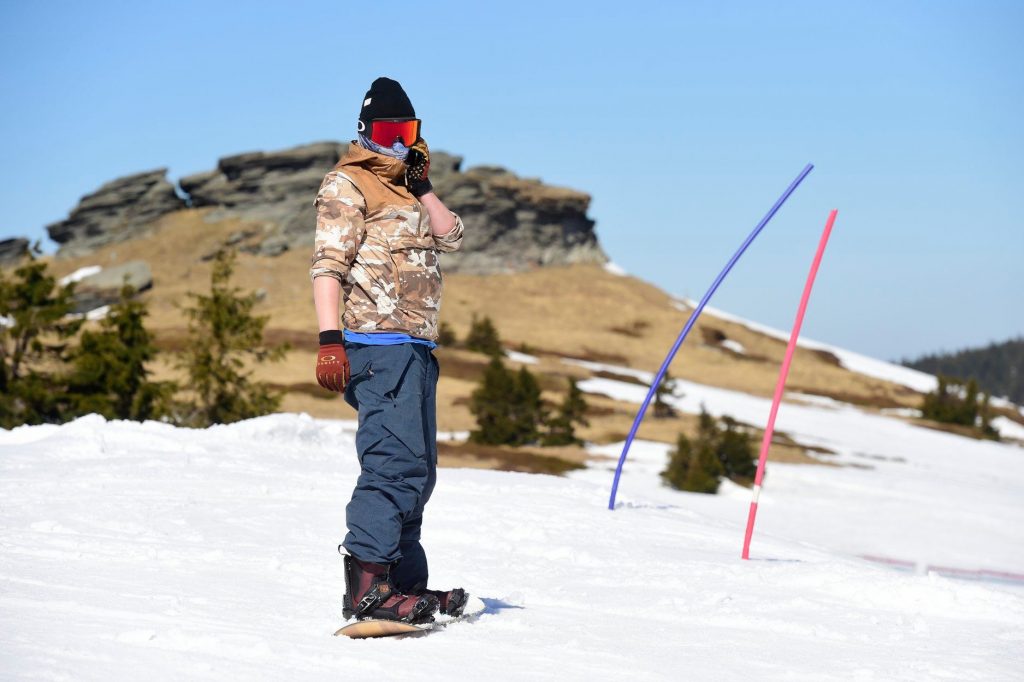
*** Updated 30th April, 2021 ***
Current Status: Closed due to pandemic / end of season
Czech Republic Social Distancing Requirements: 2m (6.6 Feet).
Face masks are no longer required outdoors as they were initially, but are still mandatory on indoor transport and in indoor public spaces where 2-metre distancing cannot be maintained.
Czech Republic Ski Centres Currently Open: 0
The 20-21 Season in the Czech Republic
The situation regarding resorts opening was unclear in the Czech Republic until December 14th. The country’s leading resort of Spindleruv Mlyn said at the start of December that they would open on December 18th but then on December 9th, the Czech Government said they could not yet make a decision on when the country’s resorts could open, saying it was “too soon” Resorts said that position was “frustrating”.
However on December 14th Spindleruv Mlyn confirmed they would be opening on the 18th as hoped. This was short-lived though, and ski slopes were closed by government order until January 10th, although it appeared ski lifts could still operate for sightseers, just not skiers. It was reported on 8th January that it was unlikely ski areas would open on the 10th due to pandemic infection rates.
Ski areas did not re-open and on 26th January the government announced the country’s state of emergency would continue to at least February 14th.
The country’s ski area operators association say they’re safe to open and must open by January 29th to be able to do so viably this winter.
On 29th January the government further tightened restrictions, continuing ski area closures, and did not give a proposed end date to the current position.
Ski areas said they hoped to open again around 13th February but that was rejected by the government.
As of March restrictions in the Czech Republic intensified due to high infection rates and ski areas remained closed. That situation has continued through April when most Czech ski areas would be closed anyway due to the arrival of spring.
How Did Czech Ski Areas Behave During The First 6 Months of the Pandemic?
The Czech Republic was one of the first countries in the world to ease its pandemic to an extent that some ski areas could re-open only about a month or so after lockdown began, by the latter part of April.
Most Czech areas had already ended their ski seasons by then anyway but one, Praded, re-opened slopes for a short time.
Finland
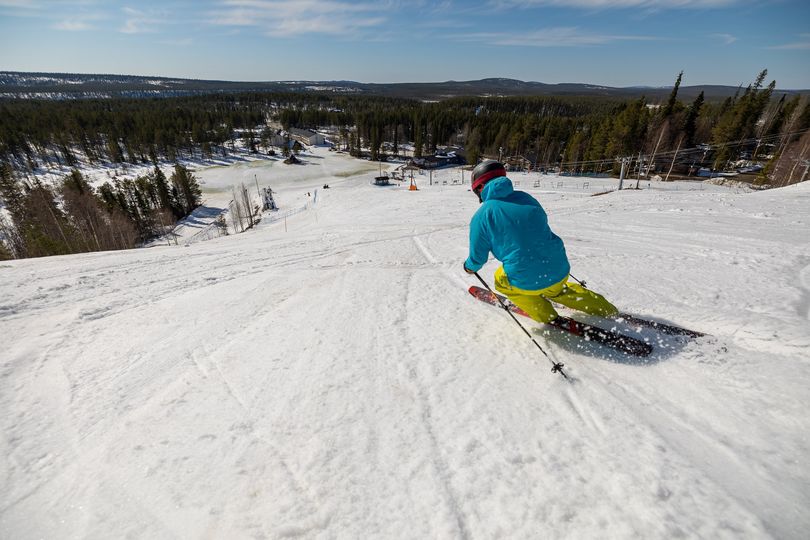
*** Updated on May 19th, 2021 ***
Current status: All areas closed – end of season.
Finland Social Distancing Requirement: 2 Metre (80 inches).
Finland Centres Currently Open: 0
The 2021 – 22 Ski Season in Finland
Levi and Ruka ski areas both opened for their 21-22 ski seasons on 8th October using snow farming – snow saved from last spring under cover. 1-2km runs are open and the resorts will be hoping weather will be cold enough by then for fresh snowmaking on top and some natural snowfall.
This started to become reality from around 20th October when natural snow cover covered ski areas. Levi hosted World Cup races on 20-21 November and other resorts including Pyha and Ruka opened for the season.
Conditions continued to be good through November with plenty of early snowfall in Lapland and more centres opening. This continued through December.
The remainder of the winter increasingly returned to a more normal, pre–pandemic type, one, with Ruka and Levi the last centres to close in May, Ruka reporting all time record business.
The 20-21 Season in Finland
The 2020-21 ski season started in Finland at 9.30am on Friday 2nd October, 2020 when two of its largest resorts – Levi and Ruka – re-opened after six months closure. They used snow-farming, saving snow from the previous winter through the summer then spreading it back out on the slopes to create a few runs as it gets colder again in the Autumn to open and were among the first ski areas without glaciers to open in Europe for the new season in this way. A warm spell in November followed but it turned colder later in the month and Levi hosted World Cup racing as usual on 21st/22nd November. Finland has also so far managed to suppress the second wave of the pandemic there more successfully than many other countries in Europe. Most of the country’s ski areas opened in the first half of December and as of February were remaining open with pandemic-spread prevention measures in place. Cases have been increasing though and at the end of February the government announced stricter lockdown rules, however ski areas have so far been allowed to stay open, stressing the need to abide by pandemic operating protocols. A number of Finnish ski areas, including Levi and Ruka, stayed open to early May.
What Happened in Finland In The Spring 2020 Pandemic?
Finland was one of the last countries in Europe to decide to close ski areas as the pandemic took hold in March, closing the last in early April. Several centres here use snow farming, preserving last season’s snow under cover through the warmer months then spreading it back out on the slopes in early autumn when things cool down, to open early.
Levi and Ruka aim to open in early October.
France
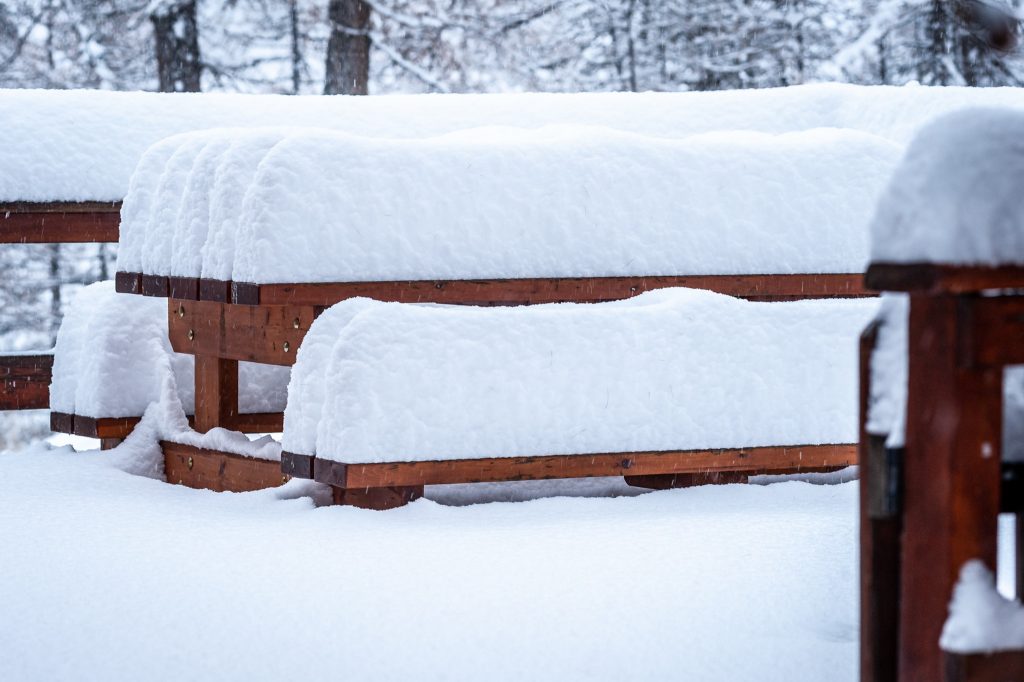
*** Updated May 22, 2022 ***
The 2022 Summer Ski Season in France
Les 2 Alpes was the first area to open for summer skiing in France on 28th May and it was due to be , followed by Val d’Isere and Tignes in June.
Les 2 Alpes opened as planned but Val d’Isere announced lack of winter snowfall and a warm spring meant snow wasn’t good for it to open this summer.
Tignes said it would open as planned from 18 June but warned it was so hot and there’d been below average snowfall last winter so advised people did not buy ski passes more than two days in advance.
It did seem to open but from the 23rd on reported all runs closed each day and only a 15cm (six inch) base so it is unclear whether it will be able to re-open in July. Tignes appeared to stay closed through the weekend then re-open on June 27th but eventually decided it had to close within two weeks of opening, on July 1st.
Les 2 Alpes closed for the season on 10th July not quite halfway through its planned summerski season due to melting of glacier snow cover. In late summer Tignes and Les 2 Alpes announced plans to open in early October, depending on snow cover. The first snowfall on high peaks was announced on 17th September.
The 21-22 Ski Season in France
France begun its 2021-22 ski season, hoping that this year it will happen.
Les 2 Alpes and Tignes were again the first two areas to open for the season, in October, offering glacier skiing. Tignes aims to stay open to next May, Les 2 Alpes has an initial 2 week opening before re-opening for the main season in winter.
Tignes was, as usual, the first in the country to open for the season on October 16th. On 2nd October the French government confirmed that ski areas will be open with ski lifts running this winter.
They say the country’s ‘Pass Sanitaire’ vaccination passport will not be needed to get on a ski lift. Les 2 Alpes was open for two weeks to 7th November.
It benefitted from the best snowfall in France for a month in early November. It reported 20,000 people took to the slopes over the two weeks showing strong demand.
On 6th November the French government said masks must be worn in lift queues but need not be once on open lifts this season. They also said if COVID infections hit 200 per 100,000 people then the French Health pass will be required to board lifts.
Montgenevre, Val Thorens and Porte Puymorens (first in Pyrenees) opened on 20th November, the first season start since 2019. Increasing pandemic cases led to tightening of rules with the health pass required to access lifts and masks to be worn on outdoor as well as indoor lifts but at the start of December everything remained open with more centres opening.
Around 40 French areas opened over the weekend of 4/5 December, as heavy snow fell, for many for the first time for skiing since March 2020.
More snow fell over the following week leading to conditions being reported as the best for early season this century.
On 16th December France announced leisure travel from the UK would be halted due to the surging omicron variant in Great Britain.
On 18th December France’s Prime minister announced that omicron was surging across France as it is in the UK. At the end of December 2021 France toughened rules on public areas but kept ski areas open.
The country re-opened its border to British tourists on 13th January, 2022. In late January France brought in a much discussed law that proof of vaccination is required to enter restaurants, ride long distance trains and in many other situations including at ski resorts.
In early February France eased restrictions so facemasks no longer need to be worn in major towns outdoors.
The numbers that can gather in venues has also been lifted and further relaxations in mid-February will allow nightclubs to re-open. On 4th March France became the latest of the big four Alpine ski nations to announce it is easing pandemic operating restrictions. The country is suspending the need to present a Covid-19 vaccine pass – proving vaccination or recovery from the virus – from March 14th.
In addition face masks will also no longer be needed indoors from March 14th, except on public transport, which includes gondola, cable car and funicular cabins.
France announced on 31st March that non-vaccinated people can now enter the country for a ‘non-essential reason’ …like a ski trip. They must have a recent negative test result though.
The season ended on 9th May with Tignes and Val Thorens the last areas to close, by then there was no longer any need to use a health pass, wear a mask or socially distance.
The 2021 Summer Ski Season in France
On 10th April 2021 Les 2 Alpes and Tignes announced they hoped to open their glaciers for summer skiing and boarding from 18th June (les 2 Alpes also opening the previous two weekends), if permitted to by then.
A few weeks later Les 2 Alpes brought forward the date they hope to start daily summer skiing to the end of May. Val d’Isere also confirmed plans for a four week summerski season in June and July.
In early May it was confirmed French ski lifts could operate again from mid-May for summer use. Les 2 Alpes confirmed they would open for the season from 29th May, with Val d’Isere and Tignes from mid-June.
In the event the first lift-accessed skiing in France in 2021 was actually on 23rd-24th May for two days only at La Clusaz after the French government relaxed restrictions. 1000 lucky pass holders were allowed to ski and board for free in celebration on the slopes of Balme where the snow had survived. Ticket booking systems crashed and the allocation instantly sold out when put on sale.
Les 2 Alpes opened on schedule with plans in place to minimise over-crowding to board the lift up to the glacier – the Jandri Express – eacvh morning. Between 6.30am and 7.10am, only pros and their coaches will be able to get on (and they have a specific time during these 40 minutes). From 7.10am to 7.20am, skiers who have booked private lessons, followed by ski clubs from 7.20am. And anyone else will be able to get on the Jandri Express from 8.00am.
On 7 June there was a surprise announcement that Avoriaz planned to offer skiing for three days when it began summer operations from Friday June 11th. It said was loads of snow left. Limited tickets went on sale online from 8.30am Wednesday.
Tignes opened for summer skiing on June 19th and closed on August 1st, Val d’Isere ended their summer ski season on July 11th. This left Les 2 Alpes as the only French are open in August.
Les 2 Alpes closed in mid-August, several weeks earlier than hoped, as all snow cover had melted from its glacier.
The Non 20-21 Ski Season in France
However on 28th October President Macron announced a new lockdown from 30th October to 1st December to try to quall rising virus numbers so ski areas have unfortunately closed again (Les 2 Alpes had been due to close again through November anyway after its 2-week October opening).
On 24th November as the lockdown was nearing its end President Macron announced that the country’s ski areas would probably not be allowed to re-open for Christmas and New Year but he hoped would be able to open in January and said a final decision on that would be made by 4th December.
On 26th November the French Prime minister appeared to confirm that ski areas should be closed until January. The country is working with Germany and Italy to try to create an all-EU ban on ski areas opening until January 10th.
On December 11th the Reuters news agency said French Government sources said they were looking at January 7th as the season start day.
Most French resorts have now said they plan to open for visitors at Christmas even if they could not run the ski lifts. There was growing anger in the French Alps with protests and petitions for people unable to work due to the restrictions.
On 9th December it was announced that the group which represents French ski resorts, Domaines Skiables de France, is suing the French government over its plans to shut down ski areas over Christmas and New Year
Some reports indicated French resorts will open on January 11th, others January 20th, but it was officially announced on December 11th that January 7th 2021 was the agreed date with the French government.
On update on January 20th confirmed that opening in mid or now even late February was “highly improbable”
Concerns have been raised about people hiking up to ski runs at closed resorts when they may not have been made avalanche safe during the closed period. Les 2 Alpes in France groomed two blue pistes, the longest with 750 metres of vertical, for ski tourers to use.
Other resorts did similar and many opened children’s nursery slopes, but business is dramatically down. The French Government closed borders to non-EU nationals and confirmed on 1st February that ski areas would not be allowed to open until at least March.
Earlier on that day around 100 ski area workers blocked access to the Frejus Tunnel between France and Italy protesting against resulting hardship. As of the start of April there has been no direct update from the French government on their plans for ski areas.
The country continued to be hit hard by the virus with restaurants closed so reopening ski areas looked increasingly unlikely and in the end wasd not permitted until late May when most had already closed.
French Glacier Ski Centre operations in Summer 2020
All three remaining French glacier ski areas re-opened in June for their summer ski seasons. Resorts are expected to begin autumn operations on the glacier at Tignes from 10th October.
Lifts also ran again at some resorts resorts like Chamonix, with temperature checks for users, to access high altitude ski touring terrain.
Staff in the three French glacier ski areas that open for summer skiing, Les 2 Alpes, Tignes and Val d’Isere, were able to go back in to work since May 11th to prepare for the easing of the French lockdown.
Initially resorts focused on French visitors but borders re-opened across the EU through June and then with some other countries. Val d’Isere was open to July 11, Tignes to August 2nd and Les 2 Alpes to 30 August.
Originally the centre had thought it too would initially only open for race team training initially then for the general public later in the month but it is now open for both with a maximum of 500 tickets a day in the first week to recreational skiers and boarders then 600 from week two.
A month in to operations a spokesperson for the centre said,
“It has all gone really well, helped by fabulous snow conditions. Social distancing for the lift, wearing masks on the lift, and booking online with numbers limited is working very smoothly.”
France had one of the strictest lockdowns in Europe with the nation coming together to stop the spread of the virus. Many initiatives were reported including ski instructors turning their talents to stitching old ski jackets into face masks; Michelin starred ski area chefs working to supply food to frontline medical staff, and French ski gear manufacturers switching to PPE manufacture.
Germany
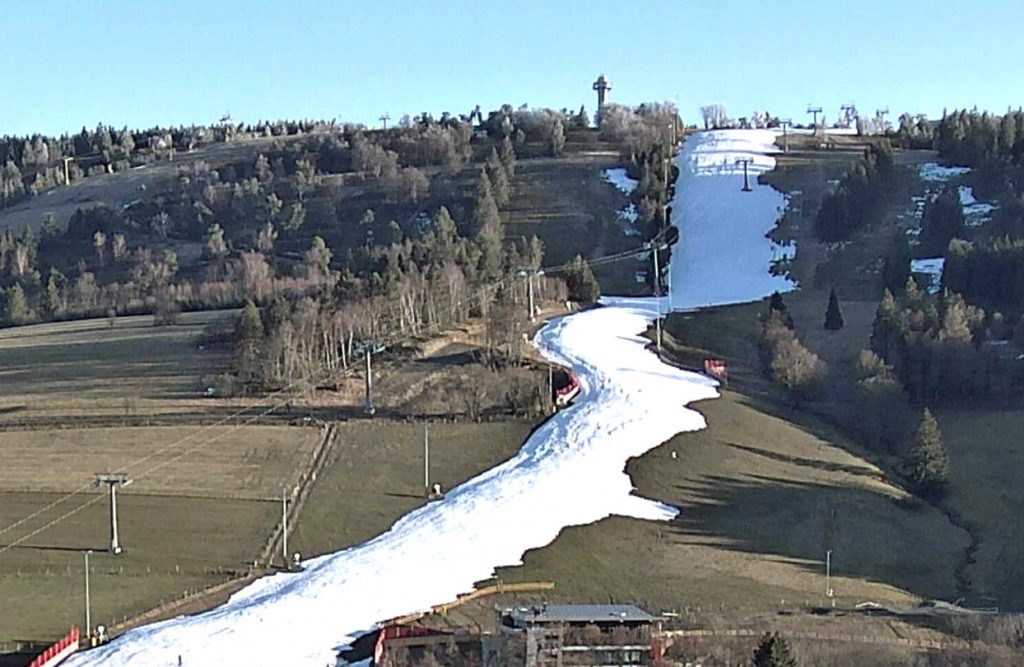
*** Updated May 20th, 2022 ***
Current Status: All ski areas closed again due to pandemic restrictions. All would be closed anyway now due to end of season.
Germany Social Distancing Requirement: 1.5 Metres (5 Feet)
Number of German Ski areas open: 0
Germany’s 21-22 Ski Season
German resorts are nervously awaiting the start of the 21-22 season, which will be the first for almost all in almost two years after ski areas were closed last winter.
Nerves are high at the start of November, with the Zugspitze glacier due to open mid-month but cases rising. On 4 November it was announced only those vaccinated or recovered from a recent infection, not the unvaccinated who tested negative, could access the slopes at the start of winter.
With increasing pressure on Germany with continuing cases rising the Zugspitze did open for its first season since 19-20 on November 19th. On 23rd November it was announced skiers at the Zugspitze Glacier would need a negative virus test from the past 24 hours as well as proof they have been vaccinated or recently recovered from the virus to be able to ski.
At the start of December it remained a tense picture with lockdown fears but so far ski areas are open and more opening after late November snowfalls.
German ski areas started opening en masse, many for the first time since March 2020, from December 4/5, with more joining them on successive weekends through the month. Germany’s ski areas have stayed open in to the New Year despite rising infection rates.
The government had said Brits entering the country would need to quarantine for a fortnight to try to keep cases of the Omicron variant down but as that failed said Brits could re-enter the country from Jan 3rd without such strict restrictions.
The country reported record infection levels at the start of February but ski areas stayed open.
Germany eased its COVID restrictions from 23rd March. You no longer need proof of vaccination, recovery or testing to go skiing or boarding. However FFP2 masks were still required in all closed cabins, trains and buildings and 3G proof (vaccinated or recovered) to access indoor gastronomy.
The Zugspitze glacier was the last area still open for the season in Germany at the start of May, closing at the end of the ski day on the 1st.
Germany In the Mostly Non Ski Season of 2020-21
Germany was due to start its 2020-21 season in mid-November at the Zugspitze glacier, which reported great autumn conditions after lots of October snowfall.
However the country’s second lockdown, later extended to December 20th stopped that. Bavaria, and later the German Chancellor, led efforts coordinated with France and Italy to close ski slopes across the EU in to January and it now looks like German slopes were closed to at least January 10th, 2021.
German ski areas said the order was unfair as they are not the sort of resorts with lively apres ski and have pandemic spread prevention measures in place.
On January 7th it was announced Germany has further delayed its opening date for ski resorts. The Zugspitze Glacier said then they still hoped it would be able to open by February. The centre, the country’s highest, said they might then extend the ski season if snow conditions allow in spring.
On January 20th German leaders extended the lockdown there until 14 February at the earliest and surgical or higher protection masks will now be required in shops and public transport.
The lockdown was extended again on 12th February to 7th March and ski areas remained closed.
On 15 March ski areas in the German region of Bavaria, home to most of the country’s larger resorts, said they won’t now be opening this season, even if they are eventually allowed to by the regional government.
Hopes of ski slope re-opening were raised slightly a fortnight ago when ski areas in several other German regions, including Willingen and Winterberg, were allowed to re-open.
It seemed unlikely Bavarian ski areas would be allowed to open though as Bavaria’s government was a leader in the move, back in December, to try to close all European ski areas at the start of the season.
That policy was agreed with France, Italy and the rest of Germany, as well as, partially, Andorra and Austria, but ignored by Switzerland, Scandinavian ski areas and there was a 50/50 split in Eastern European ski nations.
Germany’s ski lift operators association said collectively Bavarian ski areas lost around €90 million through their closure between November and March with thousands of worked laid off and the closures impacting many more people in the wider region.
Government compensation, they say, is completely inadequate due to qualification restrictions and the fact that it is based on last season’s income, which had been very poor, rather than average income.
In late April it was announced the small area that had opened should close again due to new pandemic measures by the Federal government.
The Zugspitze glacier ski area, Germany’s highest, had earlier held out hope it might re-open later in spring as it has good snow conditions later in the season than most of the other German ski areas.
Italy
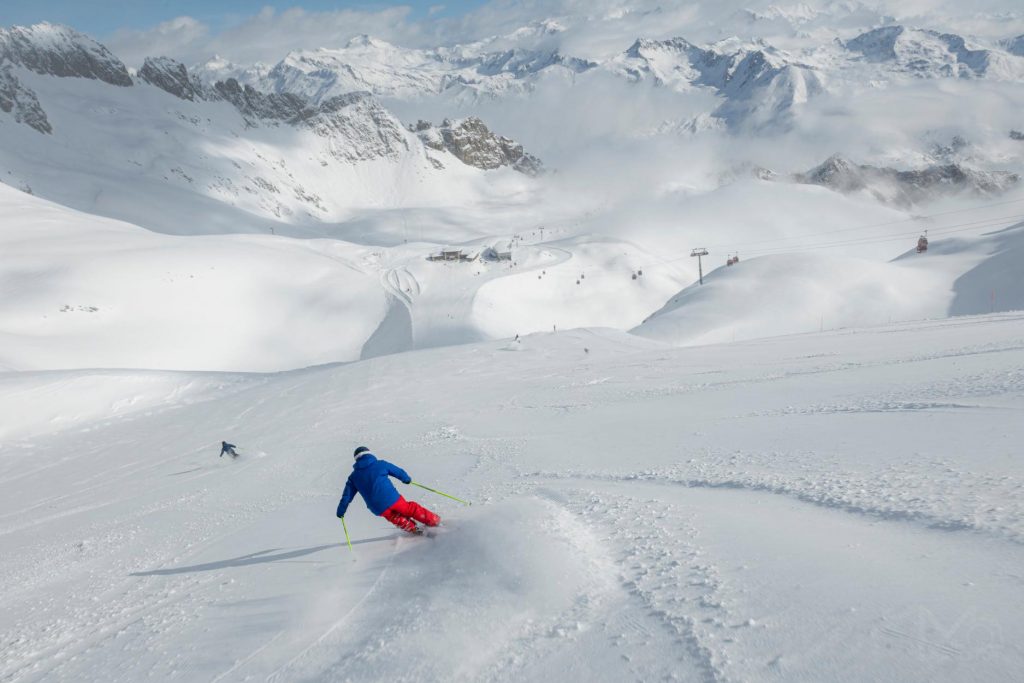
Italy’s 2022 Summer Ski Season
Passo Stelvio announced it planned to open for the season on May 28th. Cervinia said it would re-open in June for summer skiing. Passo Stelvio opened as planned at the end of May with good conditions.
Cervinia opened at the end of May, a month afterwards, reporting challenging snow conditions due to a hot spring after below average winter snow accumulation.
The poor snow cover appears to means that only runs on the Swiss side of the border, which are open anyway as part of Zermatt’s year-round glacier area, are open at present.
Passo Stelvio temporarily shut down its operations in late July due to hot weather melting snow cover from the runs. Zermatt then followed suit, ending years of being open year-round, for the same reason. So there’s currently no skiing from Cervinia either.
This situation continued into September, when Val Senales aimed to open for its 22-23 autumn-winter season. finally opening with very thin cover on 16th September but there was snowfall within 24 hours improving conditions. Snowfall was reported in both the Italian Alps and Dolomites.
Passo Stelvio reopened on 20th September.
Italy’s 21-22 Ski Season
Several Italian ski areas were open in summer after the country’s government allowed re-opening in the spring. At the start of September Cervinia and Passo Stelvio were open.
A third area, Val Senales, opened from mid-September when Cervinia closed for a month until re-opening in mid-October.
In late September Italy announced ski area opening rules from winter 21-22 including all resort staff must be fully vaccinated and wear surgical standard masks. Open air lifts can run at full capacity, enclosed lifts at 80%. Other pandemic mitigation rules must be in place.
Skiers aged 12 and over must carry the new ‘green pass’ to show they have been fully vaccinated, or recently tested negative, or recently recovered from an infection.
There was heavy snowfall in Italy on 5th-6th October boosting glacier base depths by 25cm or so. Cervinia re-opened on October 16th, with ticket sales online only after the bad PR it received a year ago when their appeared to be non socially-distanced queues for physical lift ticket purchases. Sulden was the next area to open in Italy in late October.
On 7 November Cortina opened its first lift of the season, the Col Gallina chair and Madonnas di Campiglio announced it was opening early on 20th November.
It did so with a sell out first weekend. Some areas including Bormio held back end of November opening due to lack of adequate snow cover but more areas including Dolomiti Superski did open as more snow fell as we entered December.
On 5th December Italy had the most areas open of any country in Europe (60+), most opening for skiing for the first time since March 2020. Val Gardena, with 178km of slopes open, had the most terrain open in the world at that point. Resorts continued to open and were virtually all open for the week up to Christmas.
From 10 January 2022 skiers in Italy aged 12 and over need a Covid Certificate, that attests that you are vaccinated or recovered (Super Green Pass), to access all lifts, skilifts and gondolas etc meaning only people who have been vaccinated or recovered from Covid-19 will then be allowed to access lifts.
The Super Green Pass is also needed to enter huts, bars and restaurants. The Aosta Valley was the latest Italian region to be classified under the country’s orange risk level on 17th January 2022. This means limits on the numbers allowed on the slopes. Cervinia warns that tickets should be purchased online in advance to ensure validity, although season pass holders and similar have a guaranteed space on the lifts.
On 1st April Italy stopped requiring people to have a COVID digital pass to buy lift passes. By the start of May most Italian ski areas had completed their seasons as planned with the Presena Glacier the last to close on 15th May.
Italy’s Summer 2021 Season
The Italian government allowed Italian ski areas to re-open after 22nd May, 2021 – some 7 months after they were first ordered to close. Passo Tonale re-opened for the 22nd/23rd only then Cervinia re-opened some summer skiing.
Madesimo also re-opened for weekends at the end of May and in the first half of June. The border between Switzerland and Italy re-opened on 12th June allowing cross-border skiing to resume between Zermatt and Cervinia.
Passo Stelvio had hoped to re-open June 12th but had that delayed whilst awaiting official approval from Rome of its lift maintenance at the start of the month.
This was still reported to be the case at the start of July although lifts can apparently operate for people staying in hotels by the slopes.
By the middle of the month the certification had arrived and the centre re-opened to all. Cervinia and Passo Stelvio kept operating through July and August with Cervinia to mid-September.
Italy’s Non 20-21 Ski Season
Italy’s ski season was gathering pace in October with four areas open and great conditions thanks to early autumn snowfall by the end of the month.
Initially two of the four areas stayed open (Sulden and Val Senales) to all however, apparently as Italian regions take a different approach to the national advice. Val Senales confirmed on 28 October it plans to stay open, but then on 4th November announced from 8th November it would only be open to race teams Sulden said the same. A third, Cervinia, closed for three days but then re-opened to race teams only from 29th October. The fourth, Passo Stelvio, had been due to close anyway from November 1st, due to its June-October season ending anyway.
Towards the end of November Italy’s Prime minister advised Italians not to go on their traditional Christmas ski holiday and joined with France and Germany in seeking a ban on ski areas opening across the eu until January 10th, 2021.
This decision led to strong objections from ski resorts and region. The hoped-for opening dates keep changing but currently Italian resorts hope to open from January 7th, 2021.
This date was then extended to January 18th in early January but as of January 12th uncertainty continued as to whether Italian ski areas will be able to re-open then.
The country’s regions are currently being divided in to colour coded levels according to pandemic levels with Veneto and Lombardy in orange (the middle rating) for now, and South Tyrol in the highest, red.
It was suggested at the time maximum capacity at re-opened ski areas would be 30-40% of the norm. Ski areas questioned whether people living in the lowest infection areas (yellow) will be allowed to travel to them and whether they will be able to cover their operating costs. Some said it would be better to delay and ‘open well’ for the last few months of the season than ‘open badly’ on the 18th.
On January 15th the Italian Government announced ski areas would now not be able to open at least February 15th due to the pandemic. On January 22nd Italian ski areas began to say they were increasingly confident that the 15th February date would actually happen this time as a government agency had finally approved their pandemic operating procedures – which it had not done ahead of the earlier date.
Other government groups had also given the go ahead for the February 15th opening.
On 4th February Italy announced ski areas in the country’s ‘yellow zones’ on 15th February under the country’s new tiered system will be able to re-open slopes and lifts. Most of the country’s ski areas were then in yellow zones. However South Tyrol was then in the orange tier on Italy’s pandemic measure so it appeared it would not be able to reopen its ski centres when (it appeared) most of the rest of the country would be able to.
On Thursday 11th February the country’s ski areas began announcing planned season opening dates from the start of the following week.
However it was announced on the 12th that the Trentino region is also to move up to the orange tier from Monday, the day ski areas would have been allowed to open there. So resorts including so resorts including Val di Fassa, San Pellegrino, San Martino di Castrozza and Val di Fiemme would remain closed along with ski areas in South Tyrol, also in the orange tier.
Late on Sunday 14th February, just before ski areas were due to reopen on the 15th, the Italian government announced a further extension to the closure of ski areas to at least March 5th.
On Tuesday 2nd March the Italian government announced ski areas would not be able to open until at least Easter, ruling out any opening this season for many.
Bormio and the Dolomiti Superski region were among Italian resorts t announce in the following days that they would not now be opening at all this season whatever the next decision in April was.
However on March 23rd Cervinia confirmed it would re-open in April if permitted to.
The situation continued through April with all centres remaining closed until after the end of the season for most. Some did re-open when finally permitted to after 22nd May 2021 however
Side note: Late on December 16th 2020 the Saslong lift company in Italy, which runs some of the lifts in Val Gardena including the famous World Cup race course about to be hosting it’s annual races, announced it won’t open this season (although the races were still held).
Bormio and the Dolomiti Superski region were among Italian resorts t announce in the following days that they would not now be opening at all this season whatever the next decision in April was. However on March 23rd Cervinia confirmed it would re-open in April if permitted to.The situation continued through April with all centres remaining closed until after the end of the season for most. Some did re-open when finally permitted to after 22nd May 2021 however. Side note: Late on December 16th 2020 the Saslong lift company in Italy, which runs some of the lifts in Val Gardena including the famous World Cup race course about to be hosting it’s annual races, announced it won’t open this season (although the races were still held).
Italian Ski resort Operating In First 6 Months of Pandemic in 2020
Italy, one of the worst affected countries in Europe from the virus, had a strict lockdown for nearly two months, which was then progressively eased since May 4th allowing for an ever increasing amount of outdoor activity.
The Stelvio Summer Ski Centre in Italy, the country’s only remaining summer-only destination, reopened for Italian national team athletes at the start of June and then re-opened to all skiers and boarders from 13th June – it’s due to stay open to the end of October, all being well.
A second glacier area, Val Senales, opened on September 18th for its 2020-21 season. Besides the Italian squads, racing superstars Petra Vlhova from Slovakia and upcoming star Alice Robinson from New Zealand, were training at Stelvio back in June.
There were however reports of several virus cases in the Italian team based there in late June.
Access to a second summer ski area, accessed from Cervinia but located on the Swiss side of the border above Zermatt, re-opened with summer skiing from 20th June, earlier than previously hoped.
In an interesting twist from the pandemic prevention measures, there are different social distancing requirements on each side of the border – 1 metre (40 inches) in Italy but 1,5 meets (5 feet) in Switzerland.
However the resort reports all is fine with skiers sticking to the rules on each side. third Italian area that formerly operated through summer, Val Senales said on 5th May they were concerned there was “fake news” that they might re-open this spring/summer and said they definitely will not be and are prepping the area for their usual September season start.
Japan
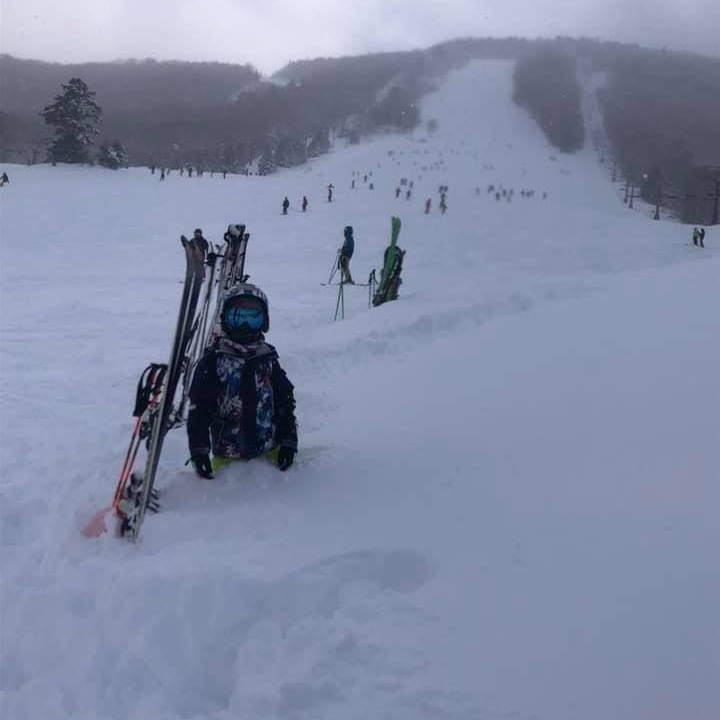
***Updated 17 October, 2022 ***
The 21 – 22 Season in Japan
Mount Fuji received its first snowfall of the season in early September, 25 days earlier than average and 21 days earlier than 2021 …which some have optimistically interpreted as meaning it could be another deep snow season this winter.
Things did start to look promising through October with increasing snowfall; on the country’s slopes.
More centres opened in early November using snow farming. Japan’s international borders remain closed as of the start of November however.
More centres opened through the month although only limited terrain. SnowJapan.com reported Furano delayed its plan to open on 20th November due to inadequate snow cover. Heavy snowfall began in the last week of November however and more resorts began opening.
At the same time though Japan tightened its border controls, which already excluded tourism visitors, in response to the omicron variant. December saw more positive signs with snow arriving and more centres open with case numbers low, however international borders remain closed.
At the start of January 2022 ski businesses in Japanese international resorts like Niseko reported business down up to 80% due to the country’s ongoing border closure due to COVID 19. As of the end of January Japan says its borders will stay closed until at least the end of February.
It is currently posting the world’s deepest snowpack.
Rumours of borders re-opening appeared to be quashed by ski businesses in Japan in late February who said they think it won’t now happen until the season is over. After two winters of pandemic lockdowns the South China Morning Post reported in early March that tourism revenues down 85% in Japan and a number of ski areas filing for bankruptcy.
Tourism is now not expected to be permitted to resume until after the ski season ends. Japan’s season played out as usual with larger centres staying open to May. However international borders remain closed and pandemic operating rules remained in place.
The Gassan ski area has been open through June and to the start of July as usual, eventually closing on the final Sunday of the month.
The 20 – 21 Ski season in Japan
The first ski resort opened a run for 20-21, using entirely machine-made snow, in late October 2020.
The ski season then kind of got underway in Japan with at least two areas opening runs made fro
m entirely all-weather snow machine snow – so it was a case of a ribbon of snow over grass and leaves down the slope. SnowJapan.com reported that Snow Park Yeti – known as Fujiyama Snow Resort Yeti last year and other names before that – was the first in the country to open on Friday 30th October.
Larger ski resorts began opening when natural snow arrived in late November and early December with Appi, Hunter Mountain and Rusutsu among the first to start their seasons.
In response to Covid-19, Hokkaido Prefecture launched the ‘New Hokkaido Style’ campaign, encouraging new lifestyle habits and business customs as part of a ‘new normal’. In resorts, protective screens at desks, sanitation of high-touch areas, provision of hand sanitiser, floor stickers for social distancing, daily health checks for employees and temperature and travel history checks for guests are just a handful of the industry-wide approaches that have already been incorporated. Rusutsu resort in Hokkaido is operating reduced capacity on its airport transfer buses in order to better assure social distancing and gondolas are being disinfected between each ride.
Kiroro resort has introduced digital menus in its restaurants, as well as implementing a strict guided seating process led by restaurant staff members.
Temperatures warmed and virus cases increased in mid-November throwing doubts on the start of the country’s main season at the end of November and start of December but resorts did start opening pretty much on schedule.
The First 6 Months of the Pandemic in Japan
Japanese ski areas kept operating through the initial stages of the pandemic in February and until late-April, in the cases of resorts that usually stay open to the start of May.
However, a second, worse, wave on the pandemic in mid-April caused all to close by April 24th.
The country lifted its state of emergency again in late May and the lone summer ski area Gassan opened again, ending its season at the end of July. Initially that was for local skiers in Yamagata Prefecture only, and at one point skiers had to present ID to show they had not travelled from outside the area when buying tickets, but eventually it was open to all once more.
Lesotho
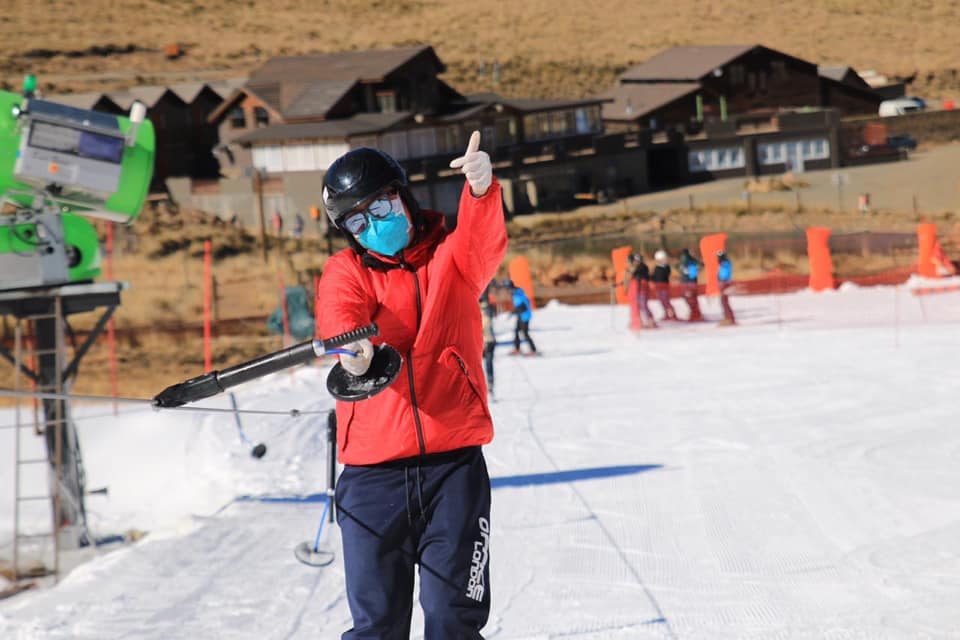
*** Updated October 18th, 2022 ***
Lesotho Current Status: Season over uintiul 2022.
Lesotho Pandemic Operating: Social distancing requirement 1.8 Metres (6 Feet). Proof of negative virus test result from previous 3 days required to enter country.
Lesotho Ski Areas Open: 0
Lesotho’s 2022 Ski Season
Lesotho managed to operate throughout the 2020 and 2021 pandemic years and appears to be on course to open as normal for three months from June to august inclusive in 2022. The country reported pre-season snowfalls in April. Lesotho say all vaccinated travellers can enter the kingdom when the ski season starts from 9th June. Unvaccinated visitors, including children aged 1 and over, must show a negative PCR test result. It announced it planned to open for the season on 4th June, one of the first in the southern hemisphere and opened as scheduled, in the event the second to open for 2022 after Perisher in Australia a few hours before. Heavy snowfall improved conditions in the final week of June and much of July and August were good. The resort announced it would end its season September 1st but in the end did so on August 30th reporting warmer than expected temperatures and a fast thaw. (For information on Lesotho’s 2020 and 2021 seasons in the pandemic please scroll down)
Leotho’s 2021 Ski Season
Lesotho’s sole ski area Afriski is open having started its 2021 ski season on June 11th. It was hoping for a better season in terms of visitors than 2020 as the border with South Africa, where many of its skiers arrive from, was re-opened, having been closed in winter 2020.
By the end of June the centre’s main slope was fully open. Afriski used snowmaking to stay open through July and August although it was boosted by a big snowfall on August 15th-16th – a fortnight before the end of the season.
It closed on schedule at the end of August with snowfall on its final weekend.
Lesotho’s 2020 Ski Season
Lesotho has one small ski area, Afriski, which was originally due to open for the season at the start of June. Afriski later announced that now that Lesotho has fully re-opened its economy, it would open for its 2020 season on 18th June.
It was the first ski area in the southern hemisphere to open for its 2020 season. In the end it operated all winter with Lesotho-only skiers as the South African border did not open.
The resort closed for the season on it’s normal closing date: 30th August.
In a statement about their opening plans in May 2020, Afriski’s team said, “The big unknown unfortunately rests on the SA governments decision on when to ease travel restrictions. Fortunately, the Lesotho government has taken a far more progressive, yet responsible, stance relating to the re-opening of their hospitality and food and beverage sector. Despite this uncertainty we have decided to take a leap of faith.”
“This will further ensure great snow production and the best skiing conditions possible,” the statement said.
The centre’s statement also confirms virus-safety is the new priority and therefore their prime focus is on being a COVID safe and ready destination.
The same Health and Safety standards applied to companies were applied at the resort through the season including temperature checks for staff and guests in combination with the required personal and company PPE standards which will soon become the norm everywhere.
Other practical measures such as adjusted seating plan and mealtimes at the Sky Restaurant together with improved take away and delivery offering from Sky and Gondola are some of the measures were put in place.
Commenting on whether skiers should book to visit the resort before their season began the statement concluded,
“Our hope is that you do indeed say Yes! It is of course a risk but it is equally a vote of confidence and a step in the right direction to reclaim the world that we once knew. The resort, and indeed the entire tourism ecosystem, now depends on the faith of every single guest willing to contribute and support their favourite holiday destinations through this crazy period on planet earth.”
“In the end hospitality is about people and it’s a great injustice that an entire army of individuals dedicated to social cohesion are being forced toward the abyss of extinction due to an alien in town called social distancing. We hope our guests see their holiday booking as a vote of confidence for the continuation of travel and hospitality.”
Afriski said they were granted a care and maintenance concession enabling them to keep their team on the mountain during the lockdown period to complete critical projects ahead of the coming ski season.
These included the completion of a new high-altitude dam which will gravity feed a 40,000m3 water reserve into the resort’s snowmaking network which will add 50% more snowmaking capacity to their already extensive system.
New Zealand
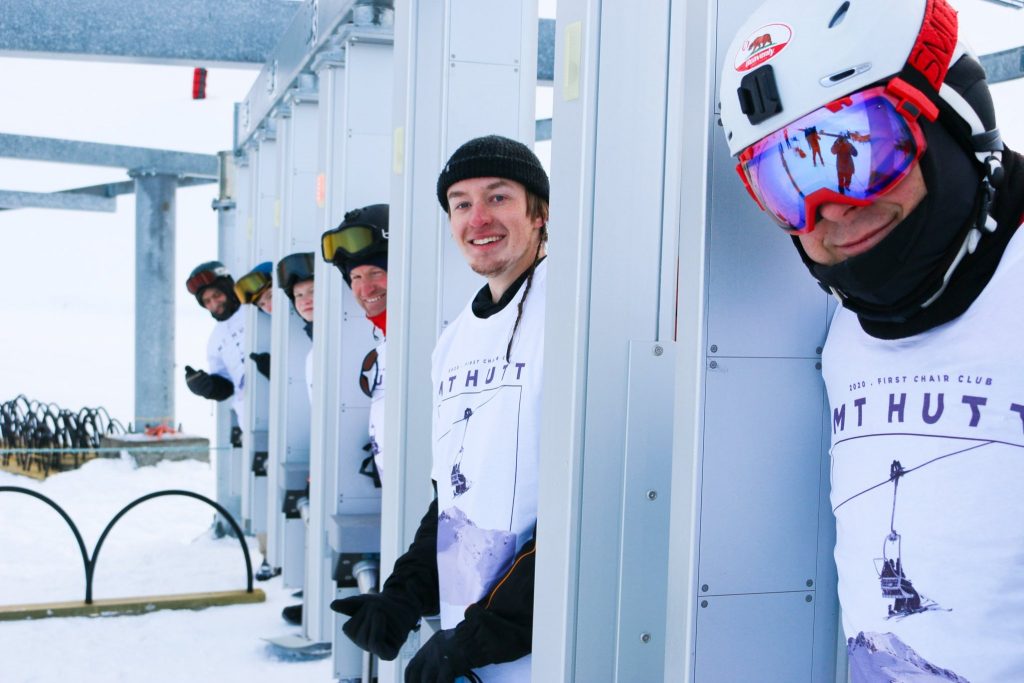
***Updated October 23, 2022 ***
Current status: All centres closed due to end of season.
Pandemic Restrictions: Usually ski areas in New Zealand operating at relatively normal, pre-pandemic status, due to successful suppression of the virus. However at level 2 social distancing, mask wearing and other restrictions are in place.
Centres currently open: 0
The 2022 Ski Season in New Zealand
Ski areas in New Zealand reported pre-season snowfall from early April on. The country began allowing tourists in from selected countries from May 1st, 2022 and plans to expand the offer through the coming year to include more countries.
After a rather warm first three weeks of May New Zealand saw cold weather snow snowfall as the season start neared. Some New Zealand ski areas report bookings from Australian skiers running higher than in 2019 – the last pre-pandemic season.
Happy Valley at Whakapapa on Mt Ruapehu on the North Island was expected to be the first ski area in the southern hemisphere to open for 2022 by a few hours but in the end it delayed opened due to bad weather.
A major storm with blizzard conditions which hit the country in the second week of June forced Mt Hutt to delay opening by a week to 17th June, but with a metre of snowfall and drifts up to 3 metres it meant when centres could open early season conditions were excellent.
New Zealand’s COVID-19 Minister Ayesha Verrall announced in mid-June that the country’s pre-departure testing regime would be axed for all arrivals as of Tuesday, June 21, just in time for the peak July ski period.
The latter weeks of June saw more areas open but also some temporarilly close due to rain storms and/or avalanche danger. At the start of July Porters ski area said they had to delay opening due to a bout of covid impacting staff but did open soon after. New Zealand fully re-opened its borders in late July.
Ski areas on the North Island have reported the worst season of this century for snow cover with very little able to open.
The first area on the South Island closed for the season in late August blaming warm, wet conditions. Cardona and The Remarkables closed on 16th October leaving Mt Hutt and Whakapapa the only ski areas still open in the country and in the southern hemisphere.
The 2021 Ski Season in New Zealand
New Zealand has been held up as an example of how to handle the pandemic well, with few infections there.
In autumn 2020 ski areas started announcing plans for the coming winter. They hope for more normal operations than 2020 when operations were limited by fewer people being able to get on the slopes.
In early April it was announced Australians would be able to visit quarantine-free, seen as a major boost for many ski areas.
This was temporarily suspended for the state of Victoria in Australia in early June due to the Indian variant of the pandemic causing a mini-lockdown there.
Ski areas in New Zealand are due to start their season on June 5th with a beginners and snow play area, Happy Valley, at Whakapapa on Mt Ruapehu opening. Mt Hutt expects to open all lifts from May 11th after a major snowstorm deposited extensive snowcover at the very end of May.
However in the event the small club field of Hanmer Springs was first in the country, and indeed the southern hemisphere, to open for the 2021 season on Thursday 3rd June.
Cardrona announced on 8th June that it would delay its planned 12th June opening by a week due to warm weather and inadequate snow cover. This was delayed again with little improvement by the 19th but it did open on the 21st with limited terrain after things finally turned colder.
Treble Cone also delayed their planned opening from June 26th to the following week. The Remarkables, by contrast, opened a few days earlier than planned, although again with only some beginner terrain open.
By the start of July the weather had turned colder and most areas had opened. The quarantine-free travel bubble between New Zealand and the Australian province of Queensland re-opened on 12 July after Queensland recorded no new virus cases in recent days but remained closed with New South Wales due to virus rates in Sydney.
At the end of the month the TransTasman quarantine -free travel bubble with Australia was closed for at least 8 weeks by New Zealand again due to Delta virus cases in Australia, ruling out much of the rest of the ski season. Some NZ ski areas warned this might make it difficult for them to turn a profit with Mt Hutt saying 60% of its August bookings had been Aussies, and might lead to “tough decisions” on opening dates.
The first half of August brought more cold weather and more snow to the mountains of New Zealand, greatly improving conditions and increasing the amount of terrain open. However the weather was wild at times with one area reporting 200kph (125 mph) winds damaging lifts at one point.
The lockdown was later extended by 4 days to 24th August, then by three more days to 27th August. The extensions continued but began to ease in early September as a lower level lockdown (down from 4 to 3) allowed resort workers back to work.
Then on Sept 6th it was announced ski areas could re-open with social distancing at level 2 from 8th September. Most ski areas remained open for at least three weeks after this and some in to October.
Mt Hutt and the ski areas on Mt Ruapehu planned to stay open to at least late October. Cardrona and The Remarkables said likewise.
The Remarkables closed on the 17th leaving Cardrona and Mt Hutt on The South Island and Turoa and Whakapapa on Mt Ruapehu on the North Island still open, the only centres still open in the southern hemisphere.
These four closed on the 24th or 25th October ending the country’s and the southern hemisphere’s 2020 season.
New Zealand’s 2020 Ski Season
New Zealand was perhaps the only country in the world to have a relatively normal season in terms of operating without the need for masks or social distancing in 2020 after March, other than a period from early August to early September when restrictions were reintroduced.
Seven centres had opened by the end of June however – the most open in the world at that point. The first boarder seen there in 2020, possibly for the entire southern hemisphere, is pictured above at Coronet Peak on May 5th.
New Zealand moved to a loosened ‘level 3’ lockdown in May 2020 which meant ski centres were among bodies that could start to see staff back on the mountains, preparing for the start of the June or July seasons.
The further loosened Level 2 was reached on May 14th meaning most areas say they aim to open on schedule with all now increasingly usual anti-virus-spread measures in place.
Things continued in that happy ‘old normal’ vein’ for two almost two months when, after no new cases for 102 days, four people tested positive in Auckland, leading the NZ government to re-introduce Level 2 on 12th August, the first time the country’s ski areas had to act with social distancing and other anti-COVID measures.
These were eased again back to Level 1 on 22nd Sepember, just as ski areas began closing for the season. Way back before the start of the season Mt Ruapehu had previously announced the southern hemisphere’s earliest opening date, May 30th, for its Happy Valley snow play and learning area at Whakapapa which has all weather snowmaking.
This was postponed to July 1st however. In the event therefore Mt Hutt was the first full ski area to open, on June 12th (a week after its originally given June 5th).
It also became the first ski area in the world to open with no social-distancing or other requirements (at the time and for the first two months of the season) for more than three months.
Most ski areas in the country had closed by mid-October but two centres on Mt Ruapehu on the country’s North Island planned to stay open to mid-November snow permitting.
Norway
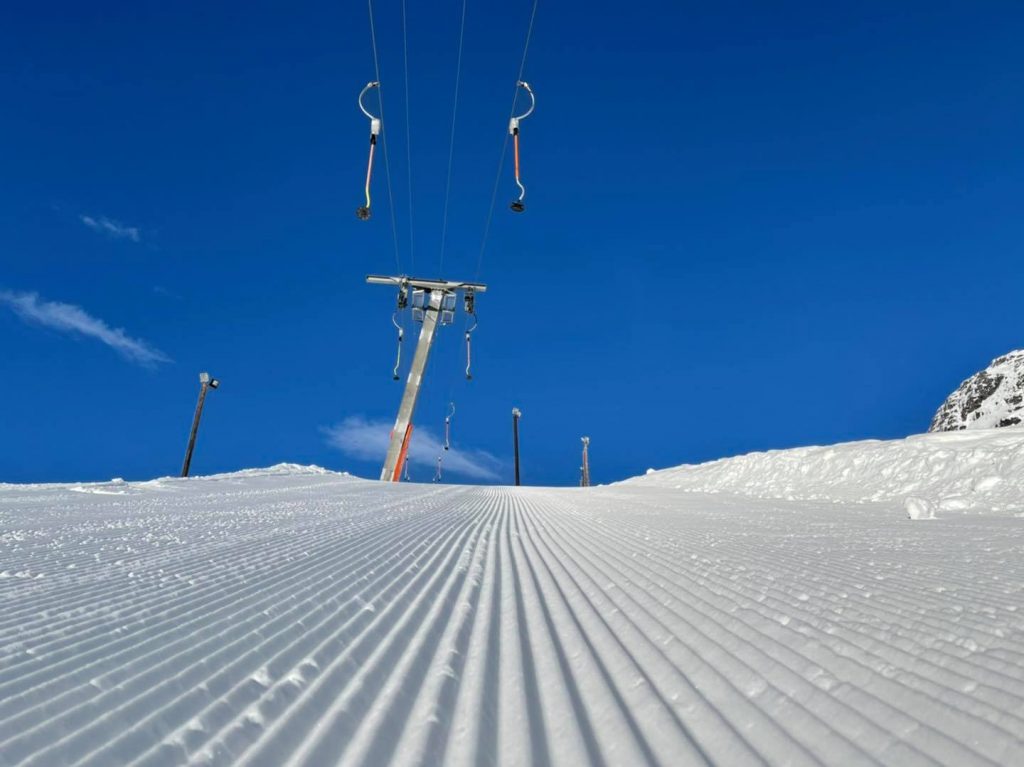
*** Updated 18th October 2022 ***
Norwegian ski areas operating status: Glacier area open.
Norway Social Distancing Requirements: Norway ended almost all pandemic restrictions including social distancing in September 2021.
Norwegian centres currently open: 1
Norway’s Winter 21-22 Ski Season
Norway’s Galdhopiggen ski centre re-opened in early October and stayed open to mid-November, extending its planned closing date by a fortnight.
As it closed on the weekend of 13/14 November, Kvitfjell was the first centre to open for the winter. The latter half of November was a little warmer a drier than most ski areas would like but things did improve in the final week with very low temps and snow leading to resorts beginning to open for the season.
In December restrictions were tightened slightly but all centres opened for the season. In mid-January Norway further tightened restrictions reintroducing mask-wearing outside in crowded places and 1 metre social distancing among other measures.
However on 26th January Norway announced it had fully reopened its borders allowing everyone in with no need to quarantine unless you were not vaccinated.
All Norwegian ski areas stayed open to the season end in April or May.
The Fonna glacier was supposed to open for the season on May 1st but was missing a lift part so the country was left without a ski area open for the first fortnight of the month.
Norway’s 20 – 21 Ski Season and Summer Skiing 2021
Norway perhaps had the shortest closed period of any of the world’s ski areas in spring 2020 and has had ski areas open almost constantly since late April.
In November 2020 the general view was that the country was handling the second wave of the pandemic fairly well and that most ski areas should be able to re-open subject to the approval of their local health authorities. Geilo was one of the first larger ski areas in the country to re-open, on 5th December, with most others joining it within the next week.
Most of the rest of the ski areas in the country had opened by Christmas. Norway has strict border controls with long self-quarantine requirements for anyone entering the country and as of January had lower virus rates than most European countries.
Ski areas sold out of limited availability tickets in advance at weekends and holidays with Voss saying the only way to get a lift pass after they sold out for a day was to book resort accommodation which comes with a lift ticket included.
Incoming travel restrictions blocking virtually all international arrivals in February led to some international ski competitions being cancelled but ski areas have so far stayed open.
As of April most of Norway’s ski centres were fully open however many closed through the month as they normally would at the end of the season. All winter areas closed by early May but the country’s three glacier areas confirmed opened as usual from mid-May.
For Stryn though the season is very short, ending on 20th June and blaming wind and rain damage for “the snow going at a record rate.”
Galdhopiggen tried to re-open through September, eventually doing so on 2nd October.
What Happened in Norway During The First 6 Months of the Pandemic
Norway was one of the first countries in Europe to ease its lockdown, in late April, allowing smaller ski areas to re-open, if agreed by local government and health bodies and social distancing and other measures in place. About a dozen areas re-opened and some got another 4-6 weeks of the season in before closing in late-May as the snow melted.
However three glaciers ski areas stayed open until early August. The third glacier to open, Stryn, opening for is season on 12th June but was the first to close in August.
Fonna glacier area had had so much snow this winter and spring the main issue for them has been clearing snow, more than the pandemic, but they eventually opened after more than a month of digging out the access road with snow lying up to 15 metres/50 feet deep and also operating with social distancing and all other anti-virus-spread measures in place.
Poland

*** Updated 24 March, 2021***
What Happened in Poland in the 2020-21 Ski Season?
Poland said in early December that its ski slopes will reopen this season – but only for local residents and during the school holidays, with resort hotels and restaurants remaining closed. Białka Tatrzańska was one of the first of the country’s ski centres to open, on December 5th.
The government subsequently closed resorts but in early January several leading centres said they would open anyway in defiance of the government order.
On 28th January Poland’s government extended the closure of ski resorts to February 14th, whilst allowing shopping malls to re-open, causing some anger. Most Polish ski areas eventually re-opened from February 12th having already opened for sports clubs. Large crowds were reported at the leading resort of Zakopane.
Ski areas were still open in the first half of March however virus cases continued to rise with the new English variant sweeping the country and resorts were closed again from March 20th.
What Happened in Poland in Spring 2020 at the Start of the Pandemic
Poland relaxed its lockdown and allowed mountain areas to re-open lifts at the start of May, one of the first countries in Europe to do so. However the season is ended there now anyway.
Scotland
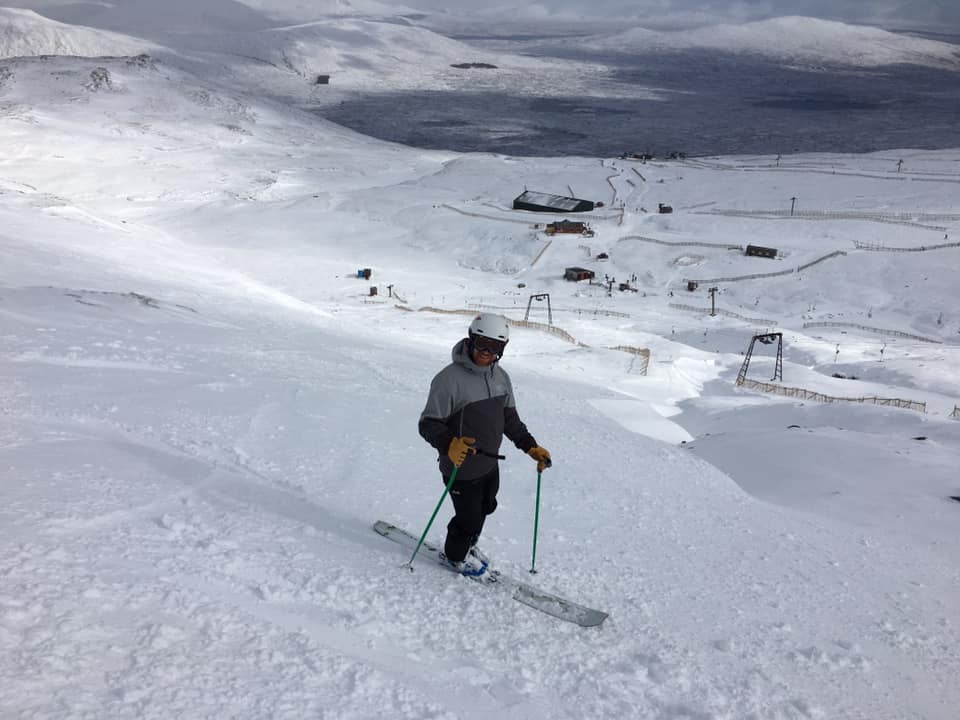
*** Updated 5th May, 2022 ***
Current Status: All ski centres closed.
Social Distancing Requirements in Scotland: 2 Metres, Mask worn in lift queues and indoors.
Scottish ski centres currently operational: 0
Scotland’s 21-22 Season
It was a mostly warm autumn but some snow on higher slopes by early November. This thawed again but snow returned later in the month and temperatures got much lower.
Glencoe began using its all-weather snowmaking machine in late November with the aim of opening its toboggan run in early December. Four of Scotland’s centres opened with natural snow cover on the 11th/12th December but were then closed as very warm weather arrived.
They re-opened on the 17th/18th with limited terrain available thanks to their all-weather snowmaking machines. Centres stayed open, with very limited terrain open due to warm weather, through Christmas and New Year and despite tougher restrictions on facilities like restaurants operating introduced in Scotland due to the omicron wave of the pandemic.
The snow cover improved in mid-February allowing resorts to run at capacity.
Scotland’s government announced on 22nd February it would no longer be a legal requirement to wear a mask indoors from 21st March although still recommended.
However as COVID cases soared mask-wearing was requited to mid-April. Ski areas started closing for lack of snow in late March after more very warm weather.
What Happened in Scotland’s 20-21 Non-Ski Season
Most of Scotland’s ski areas opened for the season on December 19th, although limited terrain was available with snow made by all weathers snowmaking machines and inadequate natural snow cover to create runs.
However Nevis Range ski area says it is shutting down operations until the trading situation is better, having made substantial losses during the pandemic. It hopes to re-open in the New Year if snow conditions and trading possibilities improve sufficiently.
On opening day most Scottish ski areas were in the low tier 1 for the pandemic, except Glenshee in tier 3 and The Lecht on the border of tiers 1 and 3. This meant only limited areas were legally able to visit. Then on December 19th the Scottish First Minister announced all would be moving in to the country’s highest tier 4, despite low case numbers in their locations, in part of a national drive to suppress the virus from December 26th.
At that point the ski areas reacted in different ways.
Glencoe, Glenshee and The Lecht stayed open to local skiers only; Cairngorm closed. Things changed once more at the start of January when Scotland went in to a stricter lockdown and the three open areas were told to close completely. So only ski tourers got out on the snow.
On 2 February the Scottish Government announced restrictions would continue through February. It announced £3m in support for ski areas. A number of ski tourers have been fined after found breaking travel restrictions to go to the mountains.
On 23 February the Scottish Government announced plans to re-open the economy which appeared to allow ski centres there to potentially re-open, possibly to locally-based skiers only initially, at the end of April, should they have snow remaining and be in a position to do so.
Ski areas expressed disappointment that golf courses and tennis courts are allowed to open, but ski slopes not.
As of the start of April the managers of two Scottish centres, Cairngorm and
Glencoe, have indicated they may re-open to skiers for a short period when permitted to from April 26th, 2021Cairngorm later said it would not open any runs and on 23rd April Glencoe said they would be unable to open any runs either so no Scottish ski areas could open runs when allowed to re-open on the 26th April.
What Happened in Scotland at the start of the Global Pandemic
Some long-time observers of Scotland’s challenging winters for ski area operators pointed to the irony that conditions from late-March and though April would have been the best in recent years for several of the country’s ski areas.
On the West Coast, in particular, the snow was lying deep, the weather has been much less windy than usual and the weather service reported April was the sunniest in the country since records began.
Re-opening ski slopes didn’t happen though as Britain eased its lockdown, and Glencoe had a virtual version of its famous midsummer snowsports day in late June.
Slovak Republic
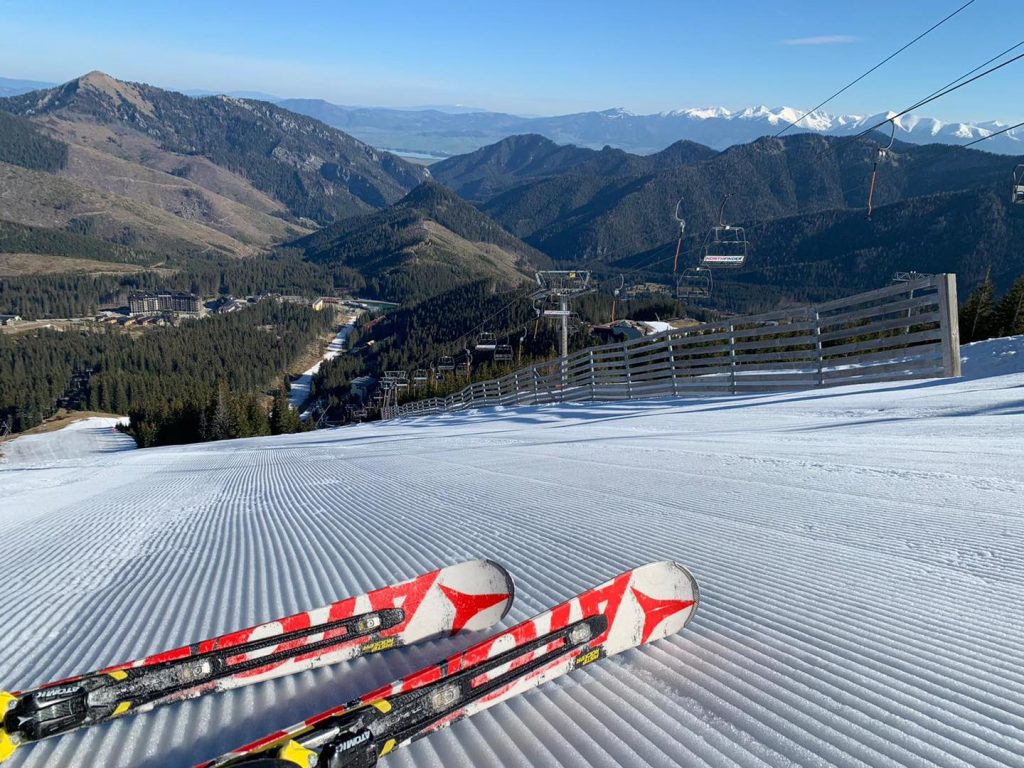
***Updated 2 April, 2021 ***
Current status: Ski areas closed due to end of season.
Social Distancing Requirement in the Slovak Republic: 2 Metres (6.7 feet)
Ski Centres Currently open in the Slovak Republic: 0
Slovakia’s 2020-21 Ski Season
Slovakia’s leading ski area of Jasna opened for the season on 5th December, although with tickets limited to season pass holders initially. 8 lifts were running serving 7 slopes and a total of 9km of runs.
Slovakia’s ski resorts usually start opening in December. November conditions have not been ideal for a pre-season base build up with little natural snowfall and temperatures often too warm for snowmaking.
Ski areas in Slovenia operated up to January 12th, 2021 when the government announced ski areas would be closed for three weeks to try to slow pandemic spread.
Ski areas were initially closed to at least February 7th, but this date was constantly put back, as the pandemic continued at quite high infection levels in Slovakia in to spring.
Eventually ski areas were allowed to open in late April after most would naturally have ended their seasons anyway. Several, including Jasna and Tatranska Lomnica, did stay open for much of May though.
What happened in the Slovak Republic in the first 6 Months of the Pandemic?
The Slovak Republic became the first major ski country to re-open a major mountain resort complete with large chairlifts, gondolas, funitel and cable-car lifts on May 1st 2020.
Slovenia
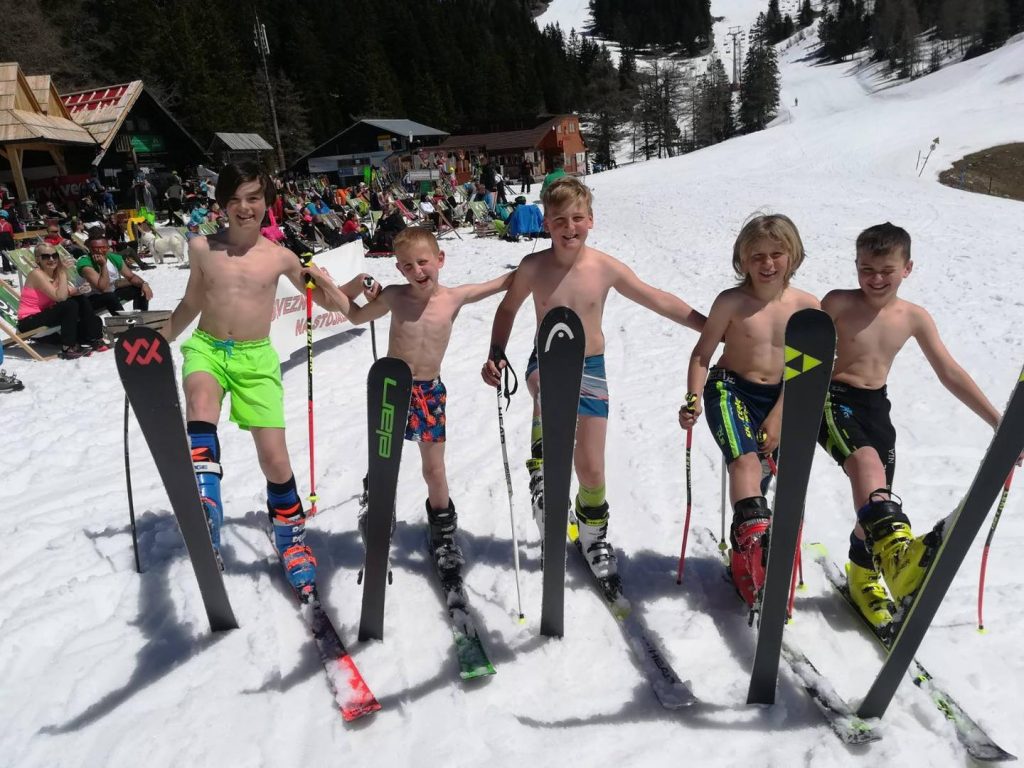
***Updated 28 June, 2021 ***
Current status: Closed due to normal end of season.
Slovenia Social Distancing Requirement: 1.5 Metres (5 Feet)
Ski Resorts open in Slovenia: 0
Slovenia’s 2020-21 Ski Season
Slovenian ski areas tend to start opening in December. It has been rather warm and dry in November but Kranjska Gora said towards the end of the month it hoped to open soon.
Snow conditions did improve in early December and resorts were allowed to open, although only to local people with travel between municipalities banned.
Kranjska Gora opened first on Thursday 10th December followed by Pohorje above Maribor and at Krvavec on Saturday 12th, only for locals, with apres ski banned.
Shortly before Christmas the government shut down ski areas until 1st January and fined one stayed open, Krvavec, 4,400 euros. This closure was then extended. Kope was the last are open in the country, to January 8th, but reported it had to shut down then due to government restrictions.
Ski resorts were allowed to re-open for skiers only in most areas of the country under a new-tiered system from 23rd January.
The majority remained open through February and into March. However a new lockdown with ski areas closed was announced from 1st to 10th April.
Ski areas in Slovenia were then allowed to re-open under new ‘red level’ restrictions following the latest lockdown there. A number, including Krvavec and Kanin – Sella Nevea/Bovec said they intended to stay open to early May.
At the start of June 2021 Kanin remained open, re-opening Friday to Sundays, and said they’d stay open in this was so long as the snow lasted. It finally closed in late June.
What Happened in Slovenia in the first 6 Months of the Pandemic
Kanin ski area announced it was re-opening due to good conditions up high from 14th May.
The Slovenian national squad were training there and organised the first national competitions anywhere since lockdown began. The centre closed again on 31st May.
South Africa
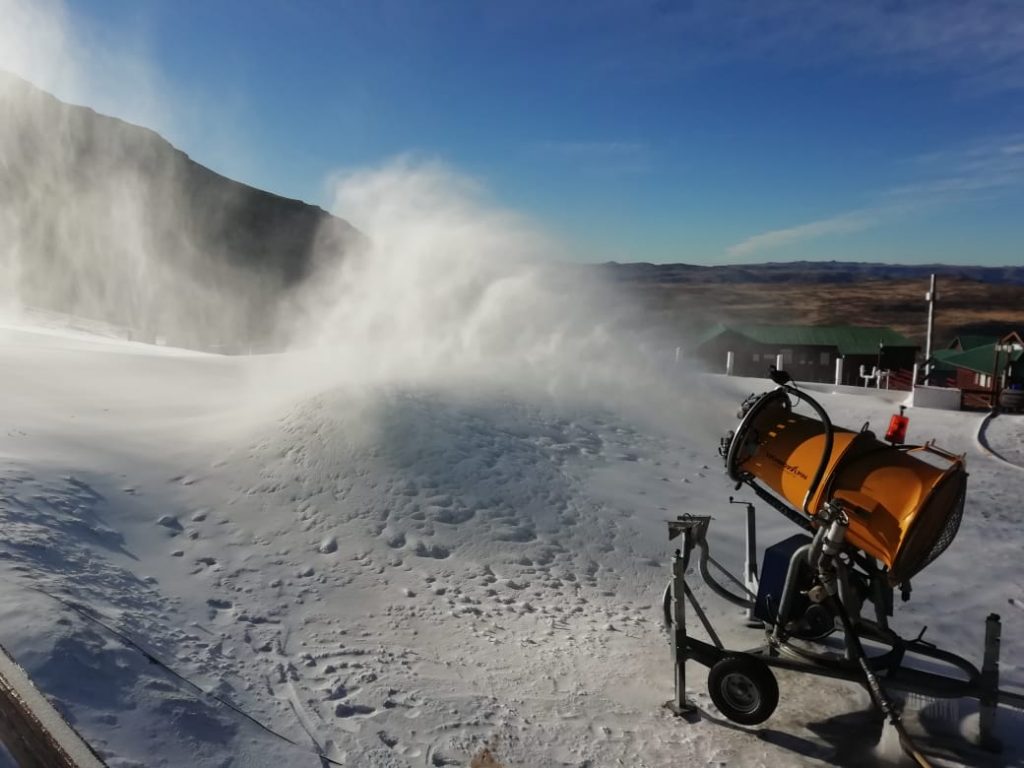
*** Updated 18th October 2022 ***
South Africa Current status: Normal season over – ski area closed.
South Africa Social Distancing Requirement: 1.5 Metres (5 Feet)
South African Ski Areas Open: 0
South Africa’s 2022 (Non) Ski Season
Tiffindell, South Africa’s only ski area closed in 2020 during the first year of the pandemic and did so again in 2021. This season it appears it could re-open (due to eased pandemic restrictions) but there is no sign that it will.
The centre is not responding to enquiries or publishing updates but in a response in a thread to a query on its opening someone who appeared to be from the centre said not in 2022 but hopefully in 2023.
South Africa’s 2021 (Non) Ski Season
South Africa was unique among the six southern hemisphere ski nations in not having any ski season at all in 2020 with the one commercial ski area there unable to open.
It was unclear what the position was at the start of the 2021 season. Normally the centre would open in late May or early June but it was not clear if its allowed to do so, or is able to if allowed.
The resort’s management were reported by one source to be “considering opening” indicating they could if they wanted to and thought it financially prudent to try.
In the meantime one difference from winter 2020 is that South African could (at last report) cross the border to ski at Lesotho’s Afriski ski area.
As of mid-August there was still no sign of Tiffindell opening, although there had been natural snowfall and cold weather and there was still no update or any sign of life from the centre at the natural season end in early September 2021.
The 2020 (non) Ski Season in South Africa
South Africa had had the highest number of coronavirus cases in Africa, as of the start of May, but decided to start easing its lockdown after five weeks at the end of April due to what was perceived as wider harm being caused by the restrictions.
The easing of restrictions allows for some limited outdoor activity but only for a few hours a day. At the beginning of June South Africa moved to lockdown alert Level 3.
Under this level, all hotels and establishments could operate only if they were providing accommodation for people travelling for business.
According to the regulations at the time, no accommodation establishments or attractions were allowed to open for leisure purposes. Restrictions were eased further but at the end of June it was reported that tourism would not be allowed to restart until September.
That was further bad news for the country’s one small ski area, Tiffindell, which was due to open for is 2020 season in early June and has been snowmaking and seen some natural snowfall too.
In the end though it was unable to open for 2020 making South Africa the first and only country in the world where no ski area opened for an entire season due to the virus.
Operations remained on hold and with the season normally running to the end of August in the end there was no 2020 ski season in South Africa – the first country where this happened.
Spain
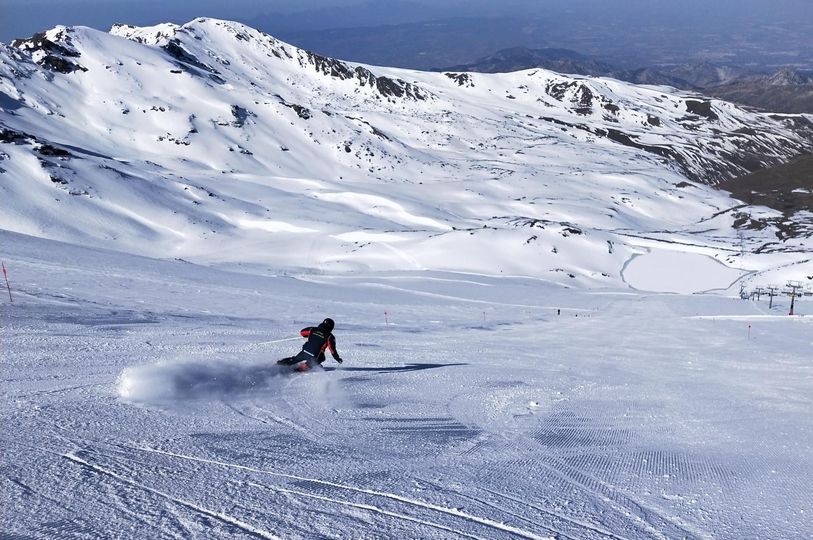
*** Updated 18th April, 2021 ***
Spain Social Distancing Requirements: 1.5 Metres (60 Inches).
Spain’s 21-22 Season
There has been some pre-season snowfall and snowmaking got underway in early November on Spanish slopes.
Several of the region’s major resorts opened around the 27th November but some like Massella were hinting a fortnight before that they’d try to go earlier, reporting on a combination of natural snow and snowmaking building up enough to fill in runs and get the groomers out.
The region’s highest area, Sierra Nevada, posted video on Nov 15 of ski clubs in training on its pre-season snow cover.
There was a good snowfall in the final week of November with Masella the first in the country to open on November 26th and most other leading resorts opening through the weekend, with great joy after most were forced to stay closed or greatly limit operations last season.
At the start of December Baqueira Beret, with over 70km of slopes open, was posting the most terrain open in Europe. By the 4th both it and Formigal had over 100km of slopes skiable.
All of Spain’s ski areas were open by mid-December posting excellent conditions for Christmas and New Year after a very heavy snowfall in the first half of December. The season played out as normal with the first spring skiing since 2019.
All resorts had closed by 24th April.
Spain’s 20-21 Ski Season.
Ski areas in Spain appear were allowed to open by the government there in December, against the wishes of their EU neighbour nations to the east, however many Spanish ski areas won’t open for now for various logistical reasons, many virus related.
One of the country’s largest, Baqueira Beret, said they planned to open for the season on Thursday 10th December. Another, Masella, on the 9th. Both have had to delay but said on December 11th they’ll open from the 14th. Most remain only open to skiers living in the local region and some areas haven’t opened at all.
Valle Laciana-Leitariegos ski area was the first in the country to open, to locals only, on 10th December, the first in the country to do so.
With ski areas closed in Andorra and France over Christmas and New Year Spanish resorts were the only ones open in the Pyrenees. The French Prime Minister announced border patrols to try to intercept French skiers heading to Spain or Switzerland.
Leading ski area Sierra Nevada which was due to open on 27th November said it wouldn’t open until virus conditions improved, and did so in mid-December. On 16 Jan it was announced Sierra Nevada had been allowed to stay open, to local skiers only, after Andalucia brought in tougher new pandemic restrictions. It had previously been feared the resort would have to close. There are now fears the reduced revenue will not cover operating costs.
The Spanish government had said they hoped “tourism will resume by the spring” and say it is a priority. As the season continues, with travel still severely limited in Spain few people can actually get to the open slopes and as a result only limited terrain is open, in order to stem operating losses, even though centres could probably be fully open if they had more business to justify it.
Formigal hoped to open December 23rd but said on the 19th that it would not be open for Christmas after all. It remained closed into February, eventually announcing it would not open at all winter.
On 15th February Sierra Nevada which had closed to all but locals re-opened it’s slopes to all residents of the surrounding Andalucía region providing they live is a district with less than 500 COVID infections per 100,000 people. As of March the situation of limited slope openings at a limited number of Spanish resorts to locally-based skiers only continues.
However some restrictions have eased in Spain from 15th March, with people able to travel further to reach the slopes. As a result some of the country’s open ski areas are hoping for a little more business and are therefore opening a little more terrain. Masella is one, increasing its open terrain to 41 runs totalling 52km (33 miles) of slopes served by 9 ski lifts.
Of the limited number of resorts to open, ski areas began closing – in many cases a few weeks earlier than usual from Easter Sunday at the start of April, with all ski areas in the Pyrenees closed by 11th April. The last in the country to close was Sierra Nevada on the 18th April.
Sweden
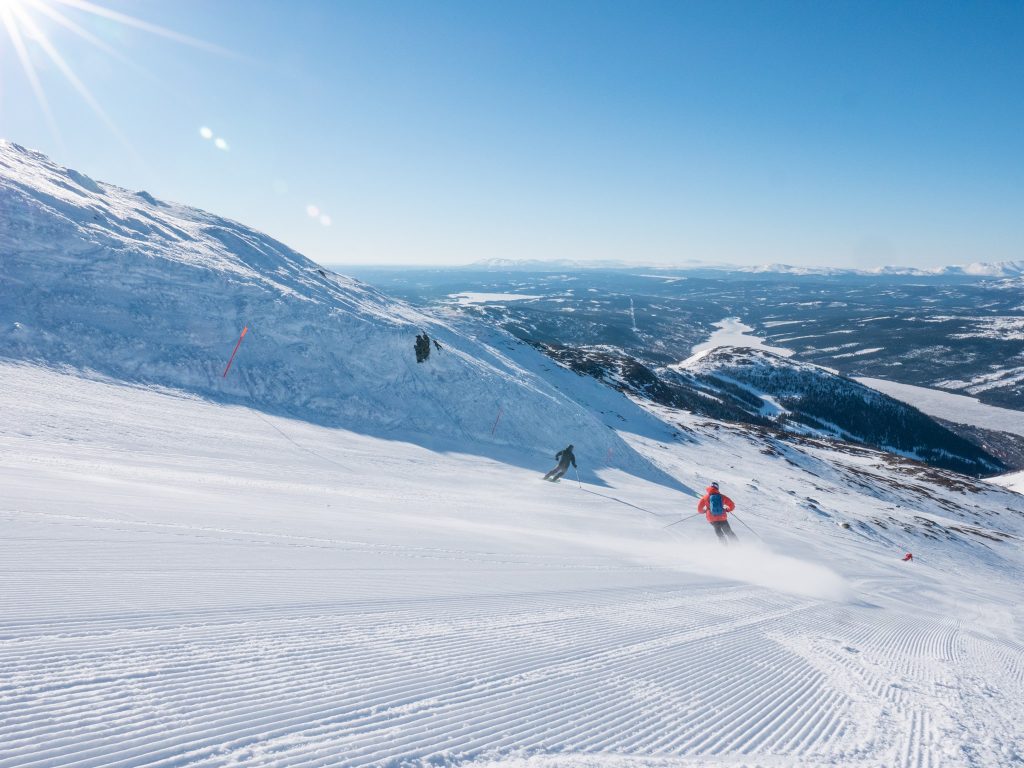
***Updated 21st May, 2021 ***
Current status: All centres closed – end of season.
Sweden Social Distancing Requirements: 1 Metre (40 Inches).
Sweden Ski Centres Currently Open: 0
Sweden’s 2021-22 Season
Idre Fjäll was one of the first two ski areas in the country to open for the 21-22 season on 22nd October, thanks to snow farming. 3.3km (two miles) of cross country and downhill trails were created.
Kabdalias also opened. Most leading Swedish centres started to open in late November or early December.
By mid-December virtually all of the country’s centres were open and the largest, Are, was reporting the most terrain open in Scandinavia.
Sweden had a travel advisory put against it in early 2022 by the US although travel between the two nations remains possible.
Sweden began easing restrictions in February and the season became more ‘normal’ during its final few months.
Most of the country’s resorts closed by the start of May but Riksgranen remained open through May, offering skiing under the midnight sun from the 7th.
What Happened in Sweden In The 20-21 Ski Season?
Sweden’s 2020-21 ski season began on 16th October 2020 at Idre Fjall ski centre which used snow-farming – saving snow from the previous season stockpiled under cover through summer then spreading it back out on the slopes in October – to open a downhill run and cross country ski trails.
Unseasonably warm weather in November delayed some resorts opening and there were also growing concerns that increasing virus case numbers could make opening ski areas a bad idea in terms of potential virus spread.
However Swedish ski areas did start opening in December, with the largest in Scandinavia, Are, opening on December 18th. Most of the country’s ski areas are currently operational with strict pandemic operating restrictions in place. Pandemic cases have been increasing leading to concerns that ski areas might be closed but as of the start of March, so far that has not happened.
Most centres stayed open to late April or early May with Riksgransen staying open through most of May as usual, the only ski area in the world to operate through both seasons of the pandemic pretty much as normal.
Sweden’s Response To The Pandemic in Spring 2020
Sweden took a different tack to most nations in locking down at a more gradual pace and still less severe than most other countries, whilst asking its citizens to behave sensibly.
Most of the country’s ski areas were closed in April however as restrictions were increased, among the last in the world to do so. Not all did though, with several agreeing with their local authorities that they could continue to operate.
The last of these to stay open and become the only resort in the world to operated its normal season through the pandemic to date was Riksgransen in the far north which remained open through to May 24th.
However skiing and boarding under the midnight sun which usually take place in May each year was cancelled in 2020 due to a lack of guests, and the annual season-ending Big Mountain Championships are a video competition this year instead.
Switzerland
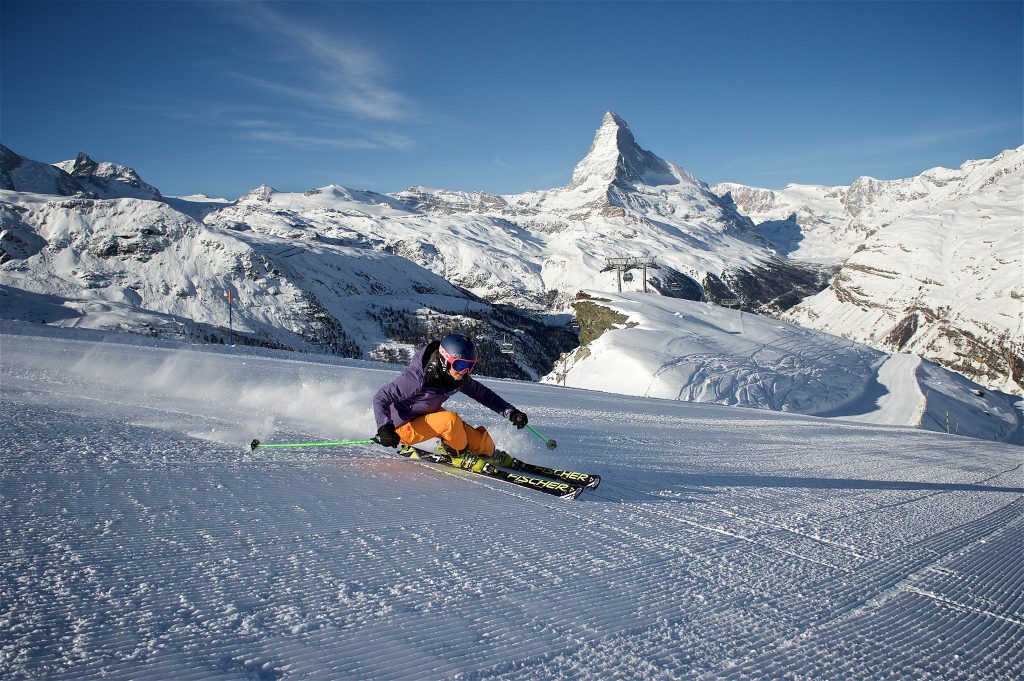
*** Updated October 18th, 2022 ***
Switzerland’s 2022 Summer Ski Season
Crans Montana and Zermatt are the two ski areas open at the end of May for summer skiing and boarding in Switzerland.
Crans Montana closed in early June, leaving just Zermatt open until Saas Fee re-opens for its 22-23 season in July.
Saas Fee opened on 16th July but due to the heat in the Alps decided initially only to open for race team training, not to the general public.
However a week later Zermatt announced it was being forced to end year-round skiing on its glacier due to the thawing snowpack. It has temporarily closed until conditions improve.
As of the start of September Zermatt remains closed and Saas Fee still only open for team training.
Switzerland’s 21-22 Ski Season
The ski season never ends in Switzerland with Zermatt open year-round and Saas Fee from July to April, but the new season kind-of gets going in October when half-a-dozen more glacier areas aim to open, conditions permitting.
The first to Join Saas Fee and Zermatt in Autumn 2021 was Engelberg on October 9th. The Diavolezza Glacier in the Engadin Valley near St Moritz opened fourth with Andermatt, Arosa, Crans Montana and Laax aiming for the final weekend of October.
In the end though only Andermatt made it that weekend due to a warm, dry wend to October.
The snow did start falling at the beginning of November however with Davos, Glacier 3000, Murren and Laax announcing they would open on the 5th.
Arosa, Crans Montana, Lenzerheide and Verbier opened on the 11th/12th, when Andermatt announced they’d have 1500 vertical metres of terrain skiable.
In response to the omicron variant the country announced a 10 day quarantine requirement for skiers arriving from a number of countries including the UK and Australia but dropped it after six days in favour of additional testing.
Measures were tightened again around mid-December but all ski areas opened. From Saturday, 22 January, the Swiss Government dropped its requirement that persons who have been vaccinated or who have recovered from COVID-19 to present evidence of a recent negative test on arrival at their border.
In mid-February Switzerland scrapped work-at-home and quarantine requirements and announced plans for an easing of other restrictions stating: “Despite record high infection figures, hospitals have not been overburdened and the occupancy of intensive care units has fallen further.”
As of 17th February Switzerland no longer required people arriving in the country to prove they had been vaccinated, or even show a negative test result.
“Health-related measures for persons entering the country are lifted on 17 February 2022. It is no longer necessary to provide proof of vaccination, recovery or a negative test or complete an entry form,” a statement from the Swiss government read.
The country is also removed most restrictions on day-to-day life within Switzerland that had been put in place due to the pandemic too. All restrictions on shops and restaurants, among other businesses, were lifted.
“From 17 February 2022, almost all measures are lifted. There only remains the mask requirement on public transport (including cable cars, buses, funiculars, trains),” the statement explained.
The Swiss government say that more than 90% of Swiss nationals now have some protection from the virus due to vaccination or past infection and that although the virus is still in circulation there is no longer a concern of the country’s health service being potentially overwhelmed.
Swiss Summer Ski Centres Open 2021
Swiss glacier ski areas have been open for summer skiing and the country has eased lockdown restrictions so more things like dining in public restaurants are possible.
Glacier 3000, the Diavolezza Glacier and Engelberg’s Titlis glacier were among centres open in to May and Crans Montana extended their season to early June.
From June 7 on only Zermatt was open however, celebrating a year of ski operations since it re-opened after the first Swiss lockdown.
A second Swiss area, Zermatt’s neighbour Saas Fee, opened for its 8 month July 2021 to April 2022 season on 17th July.
Engelberg opened for its 21-22 season on 9th October immediately reporting the deepest base in the world at present at over 3 metres/10 feet.
Switzerland in the 2020-21 Season
Most Swiss ski centres are opening for the 20-21 season as normal, some earlier than normal. Zermatt has been open since June, Saas Fee since July.
Heavy snowfall at the beginning and end of September led a third area, Glacier 3000 near Gstaad and les Diablerets to open nearly six weeks earlier than planned at the start of October.
It was followed by the Titlis Glacier above Engelberg on the 10th. The Diavolezza Glacier near St Moritz opened on the 19th then Davos on the 24th.
There was a fear that the country would go in to a November lockdown like its neighbours but on 4th November the government decided to keep most businesses open although there were increase restrictions on restaurants and other businesses put in place.
An 11th Swiss area, Crans Montana, announced it was opening on the 7th. Swiss centres have comprehensive anti-pandemic-spread measures in place and have created a ‘Safe & Secure’ holiday label.
However many resort amenities including restaurants and shops and other facilities may be closed, the rules vary from canton to canton. More than 100 Swiss areas were open from the weekend of 12th/13th December.
In the first month of winter most Swiss ski areas stayed open. Only the canton of Uri closed ski lifts briefly at Andermatt at the end of the year but they have since re-opened.
There are many strict limitations in place including in resort shops restaurants and hotels, many of which are closed. The famous Lauberhorn World Cup downhill race in Wengen was cancelled in mid-January due to a local coronavirus spike.
The ski centre stayed open to tourists though. Swiss ski areas remain largely open and in early February the closures there have been have been caused by avalanche danger of strong winds.
There were outbreaks in resorts including St Moritz, Wengen and Arosa but these were swiftly contained in individual hotels or, in one case, a school.
At the end of February Verbier said it would close its Bruson sector as operating costs are too high in the pandemic. But with cases falling cantons began announcing resorts will be able to stay open to the end of the season.
On 24th February it was announced that shops and museums can reopen from March 1st, while restaurants can open from March 22nd. Ski resorts had been pushing for restaurants to be allowed to open sooner, if only outdoor terraces.
Switzerland During The First 6 Months of the Pandemic
Switzerland slowly eased its lockdown from May. Zermatt, usually open for snowsports 365 days a year, re-opened on June 6th.Saas Fee opened for it’s nine month season through to April 2021 in mid-July.
However on July 6th the country made wearing face masks on public transport (previously advised but not a legal requirement) a legal requirement. In terms of ski resorts operating ski lifts, this initially only impacts skiers at Zermatt.
“Since this morning it has become mandatory on all cable car cabins and gondolas run by Zermatt’s lift company to wear face masks. We ask you to observe these for the protection of yourselves and others and thank you for understanding,” a statement from Zermatt Bargbahnen advised on July 6th, adding, “If you don’t carry a mask with you, you can buy mouth-nose protection at the kiosks of Zermatt Bergbahnen AG as well as in the Matterhorn glacier paradise restaurant.”
Shops, bars and restaurants re-opened from May 11th although with restrictions in place.
Although now closed again, Crans Montana, announced on 28th May it would re-open its glacier slopes for a nine-day period from Saturday, 6th June.
USA
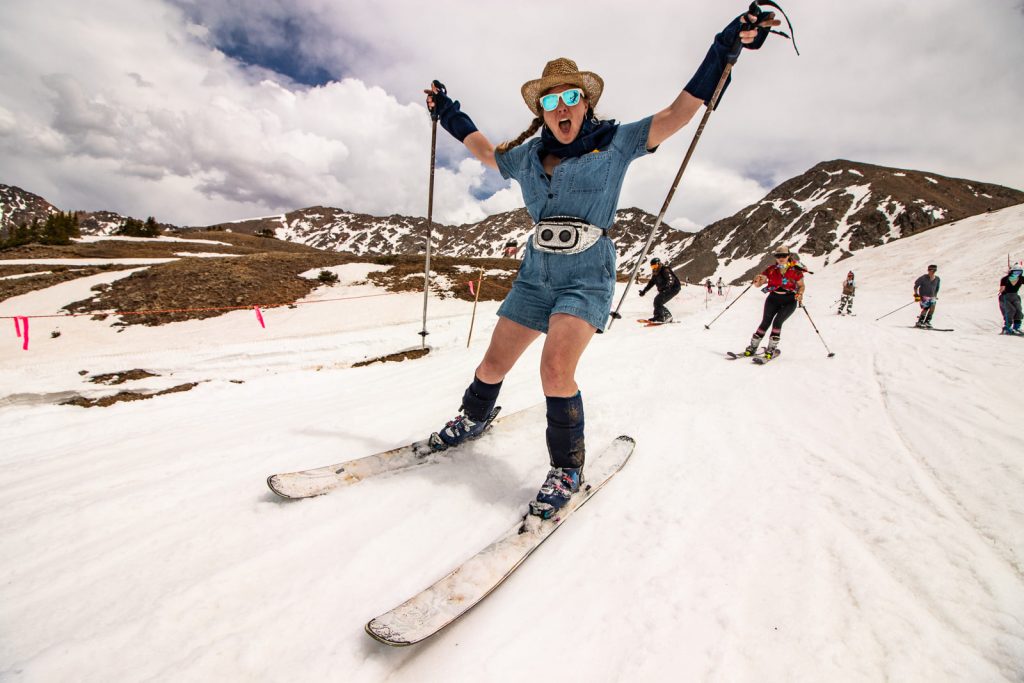
*** Updated 18 October 2022 ***
What Happened in America’s 2021-22 Ski Season
US resorts hoped to start the 21-22 season in October 2021 and an unseasonable large snowfall in the second full week of the month allowed that to happen. Many say they’ll be operating closer to normal but with pandemic measures like online booking, mask wearing and social distancing required.
But lifts may run at capacity. Many are insisting all employees are fully vaccinated. International travellers care due to be allowed to travel to the US for the first time in 20 months from November. There was snow high up in the Rockies and other western mountain ranges in September and early October.
Arapahoe Basin, Keystone, Loveland and Wolf Creek were all candidates for October opening. Wolf Creek was first to open on the 16th, but initially only at weekends, with Arapahoe Basin but open daily from the start following the next day.
On 15th October the USA confirmed it will allow international arrivals of fully vaccinated leisure travellers from a number of countries including the EU and UK from 8th November. Keystone, open daily, was the third to open in Colorado, the US and North America from the 22nd October.
A huge snowstorm hit the western US on 24/25 October, particularly California, and Mammoth Mountain announced it was opening two weeks earlier than planned, from 29th October, in time for Halloween.
In the end 7 US ski areas with open for Halloween weekend with Boreal and Palisades Tahoe in California joining Mammoth Mountain and Loveland in Colorado the latest to announce early opening.
In terms of operating in the second pandemic full season, in 20-21 there were limits on the number of people using some lifts, masks had to be worn in most locations and some larger resorts introduced a requirement to pre-book slots on the mountain, selling out of the limited capacity on peak dates well in advance.
However despite operational challenges last season saw most areas open for longer than in the curtailed 2019-20 season, with some posting their best ever results and overall the season one of the six best on record in the US.
This winter most of that appears to have gone and main onus is on vaccination, for staff and guests. Many of the larger corporate owners of multiple resorts and plenty of smaller centres are requiring staff be vaccinated. For guests it is largely not a requirement, but it is recommended.
Some resorts, like Aspen, have announced a requirement to show proof of vaccination in very limited locations – particularly cafeterias with fast flowing indoor operations with many customers. It doesn’t apply for eating on the terrace or at table-service restaurants.
Mask wearing does not look like it will be widely required so much either, although some resorts are requiring it on shuttle buses and indoor dining.
All are stressing that whatever they decide individually, the main influence is what their local public health body requires, which continues to change regularly depending on the state of the pandemic.
Many of the big destination resorts are currently concerned about finding staff, with problems for international staff obtaining temporary work visas.
Arapahoe Basin offered a free bloody Mary, beer or fizzy drink to those who got vaccinated there on October 29th or 30th.
Breckenridge and Vail opened on 12th November taking the number open in Colorado to 6, and in the US 8.
Warm weather continued to be an issue with some big resorts like Heavenly and Park City delaying pre-Thanksgiving opening plans. However the first areas in the Midwest and on the East Coast (Killlington) were open by mid-November.
Conditions were still challenging across the country but more areas opened at least some terrain. Only resorts on the West Coast were unable to. Things began to improve in mid-December after a warm and dry six weeks with huge snowfalls in the West allowing most areas to open. Some good snowfalls too across ski slopes in the rest of the country so more or less everywhere was able to open by Christmas week. Colorado resorts were unable to operate all terrain due to COVID related staff shortages the Denver Post reported on 6 Jan.
March saw an easing of restrictions in the US. Among many changes at many resorts Aspen announced vaccination certificate no longer needed to work there or for visiting skiers/boarders to access some indoor facilities.
In May hot weather led to several areas including Breckenridge and Snowbird saying they would close earlier than expected and the summer-skiing-only area of Beartooth Basin that they would not open. However the end of the month saw unusual heavy snowfall for late spring with over two feet reported at Arapahoe Basin, one of 7 resorts still open to the end of May. The others were Mammoth and Palisades in California. Mt Bachelor and Timberline in Oregon, Crystal Mountain in Washington State and Killington in Vermont.
Arapahoe Basin and Killington stayed open to the first weekend of June, in Killington’s case their latest closing date for 25 years. Mammoth, Timberline and Crystal Mountain stayed open later into June.
From 11th June it was announced that the USA will no longer require a negative COVID test result for arrivals so skiers heading there or returning there from skiing in the southern hemisphere or Europe’s glaciers will no longer need to take a pre-departure test before flying there .
Timberline was the only area in the US open to the public in late June and into July and hopefully August. Copper has a snowpark open only to those attending Woodward summer camps.
In early August it announced its 21-22 season would end on August 21st after nearly 10 months.
US Ski Areas in Summer 2021
Over a dozen US ski areas were open in mid-May but most closed by the start of June, in part as it is not a great year for snow cover.
Arapahoe Basin, which offered ski-in-vaccinations with a free drink to all those who took up the free jab offer, in May, was one of the last to close on June 6th.
Timberline in Oregon remained open with its Palmer snowfield on My Hood and the Beartooth Basin summer ski area, the only one in North America, located on the Montana/Wyoming state line, was also in operation for a few weeks in June.
Crystal Mountain in Washington State also re-opened weekends in to mid-June. Mammoth and Crystal offered summer training facilities to the US team and Copper also had a terrain park for Woodward campers.
Beartooth Basin’s season was very short, ending after just three weeks or so on June 15th.
Timberline was then the only North American ski area open through July despite having seen record high temperatures impacting snow cover and causing temporary closure at the start of the month.
It remained open to August 15th but then closed for the season 3 weeks earlier than hoped due to the impact of that warm weather on the snow.
What Happened in America’s 2020-21 Ski Season
Wild Mountain in Minnesota was the first ski area in the US (and North America) to open for winter 20-21 on Tuesday 20th October following low temps for snowmaking and some natural snowfall in the Midwest. It was joined by Trollhaugen, over the state border in Wisconsin, on Sunday 25th October. They were joined by Wolf Creek in Colorado opening a week later on 28th October after around two-feet (60cm) of snowfall there.
Next to open in the state was Keystone on November 6th, then Arapahoe Basin on the 9th, Loveland on the 11th and Breckenridge on the 13th. The ski season got underway in Montana on Halloween at the Great Divide ski area. The 4th area in the US to Open.
Lookout Pass was the first ski area to open for the season in Idaho for the new season, with fourteen trails open, five of them groomed on opening day, 14th November.
Crystal Mountain in Washington State opened on 18th November, two days earlier than planned, due to good snow conditions.
Killington was first in the East on 20th November. There have been many more areas open since then.
However Taos delayed its planned opening in late November after the New Mexico state government announced pandemic operating restrictions.
Most of the country’s ski areas had opened by the start of December. Ski areas in the US are offering a “very different” winter 2020-21.
Most opened as usual although some delayed opening for the season to ensure enough terrain is open when they do open.
Vail Resorts are limited early-season access to their Epic Pass season pass holders only, until December 8th. Pass holders now have priority booking for other days.
Many resorts operated at 40-60% capacity limits on mountains to avoid over-crowding, the need to book lift tickets and mountain access in advance and those driving to the mountains to book car parking. This has led to many resorts selling out of lift tickets, particularly at weekends an holiday periods.
Many other measures are being put in place to prevent the danger of spreading the virus when they open. Even with all the safety measures resorts are subject to ever tougher operating restrictions from local and state health bodies and governments but so far all have been allowed to keep operating.
Californian ski areas seemed to come closest to closing in January when there was a stay-at-home order and hotels in resorts were closed, but this was lifted at the end of the month. Ski areas largely stayed open though, operating in this fashion through the ski season to date.
A few smaller areas have even reported business numbers have actually gone up from previously low levels, whilst still remaining below limited pandemic capacity levels, as more people seek to get in to the great outdoors and perhaps forego trips to bigger destination resorts.
What happened in the US during the first 6 months of the pandemic in 2020?
The last resort still open in the US for winter 19-20 ended its season at the end of August.
It was a complex picture in the US during the period from March to June with different states having different lockdown rules, easing restrictions at different times.
All areas were closed for most of April until Mt Baldy in southern California decided that it could re-open if local golf course could. It stayed open to May 5th when the advance of spring weather appears to have led to its closure.
It later brought closing day forward to August 30th after a month of very hot weather.
For July and August Timberline was the only US resort open, although the US ski team and other private groups were reported to have been training on snow at Copper Mountain in Colorado until mid-August.
In terms of other US ski areas that are usually open in late spring and in some cases early summer: Mt Bachelor, a second Oregon resort, also re-opened, from May 16th, but only for 9 days to the 24th May, and only for season pass holders. Both areas sold out of lift tickets for re-opening day very fast.
In Vermont, although re-starting its summer mountain operations, Killington decided ‘on balance’ not to re-open for late-May snowsports on its Superstar trail, although the snow is there and it would usually open to the end of the month in a normal season.
In Minnesota Wild Mountain ski area groomed some of is remaining snow and installed rails and other features to create a hike-up terrain park which it opened on the afternoon of May 9th, charging $10 for access or free to season-pass holders.
In Colorado restrictions were eased a little in early May allowing people to enjoy outdoor recreation within 10 miles of their homes but this was quickly followed by a ban on ski areas re-opening before May 22nd.
This led Aspen, which said it had been hoping to do so if permitted, to then say it wouldn’t re-open this spring. Wolf Creek had also been aiming to re-open.
On 25th May it was announced that Arapahoe Basin would re-open from Wednesday 27th May. This proved so popular the resort had to run a lottery to see who can buy lift tickers each day. It later announced it would close for the season on June 7th due to snow conditions.
Crystal Mountain in Washington State announced a similar short re-opening, just 7 days after initially saying they’d re-open for a fortnight. They were open from June 1st to June 7th.
Other US areas that typically stay open to late spring so could possibly re-open if their states deem it safe to do so and they with and are able to include Mammoth and Squaw Valley in California and Snowbird in Utah but all gave snowsports a miss in spring 2020, although re-opening for summer activities.
The small Beartooth Basin summer ski area on the Montana/Wyoming border reopened for its 2020 season on June 1st and operated for just over three weeks to around June 23rd when it closed due to thin cover.
News Headlines From Earlier in the Pandemic
2022
AUGUST 2022
- Canada has re-introduced random testing at four of its international airports – those used mostly by skiers in Alberta, BC, Ontario and Quebec. The UK’s largest tour op says this has led to a dip in sales for 22-23. (6 August)
- Asia’s 2021-22 season has ended with Gassan ending its 2022 season. (1 August)
JULY 2022
- To access Afriski in Lesotho, South African citizens and permanent residents now only have to produce a Vaccination Certificate or Negative Rapid Antigen test. However travellers from all other countries have to produce a negative PCR test (24 July).
- Summer skiing has ended at Les 2 Alpes about halfway through the planned season. There is now nowhere left open in France (11 July).
- Summer skiing in Tignes has ended almost as soon as it opened this year due to the impact of climate change on the resort’s Grande Motte glacier. (6 July)
- Valle Nevado in Chile has reopened for the first time in three years (6 July)
- Porters ski area in New Zealand delays opening to at least July 7 as staff have COVID-19. (1 July)
JUNE 2022
- New Zealand’s COVID-19 Minister Ayesha Verrall has announced New Zealand’s pre-departure testing regime would be axed for all arrivals as of Tuesday, June 21, just in time for the peak July ski period. (19 June)
- Despite restrictions easing in many leading nations, a study by aircraft charter broker, Air Charter Service says that 76% of countries still have some form of travel restrictions in place at this time. They range from closed borders to vaccination checks and testing requirements. (17 June)
- South America’s ski season gets underway with international skiers able to visit again for the first time since 2019. (15 June)
- Canada’s Blackcomb Glacier above Whistler is re-opening for summer skiing for the first time since before the pandemic. (9 June)
- Australia’s season has started early. There are few pandemic restrictions in place at present, just masks to ne worn on public transport, but resorts warn they’ll move to enforce any fresh government restrictions if there are any announced (June 5).
MAY 2022
- Argentina No Longer Requires Proof of Vaccine or COVID-19 Tests. Travel to Argentina no longer requires proof of vaccine or a test. Medical travel insurance that includes hospitalisation, quarantine, and transportation coverage of COVID-19 is required. (26 May)
- Some New Zealand ski areas report bookings from Australian skiers running higher than in 2019 – the last pre-pandemic season. (20 May)
- Lesotho say all vaccinated travellers can enter the kingdom when the ski season starts from 9th June. Unvaccinated visitors, including children aged 1 and over, must show a negative PCR test result. (May 17th)
- Reports from Japan indicated the border there may be reopened to tourists soon, good news for winter 22-23, but yet to be confirmed. (May 12th)
- The EU has announced that airlines no longer need to insist passengers where masks although they should recommend they do and keep in line with the policies of the countries they’re operating from and to. (May 12th)
- Ischgl reports 21-22 season business is down 25% on pre-pandemic levels but says with the start of the season lost due to lockdown this is a better result than they hoped. (May 4th).
- New Zealand has allowed tourist arrivals to re-enter the country from 23.59 on May 1st. The UK is included in the list of visa waiver countries, as are Belgium, Canada, Denmark, Germany, Japan, Switzerland, the US (May 1st)
APRIL 2022
- Ruka in Finland reports record business in 21-22 despite pandemic restrictions, passing 500,000 skier days in a season for the first time (26 April).
- Switzerland announced business levels were back up to 85% of pre-pandemic levels in 21-22 (20th April).
- Spain plans to lift face mask wearing requirements from 20th April (7th April)
- Canada announces fully vaccinated skiers and boarders can now travel there without needing to take a covid test (5 April).
- France has announced that non-vaccinated people can now enter the country for a ‘non-essential reason’ …like a ski trip. They must have a recent negative test result though. (1st April)
- Italy has stopped requiring people to have a COVID digital pass to buy lift passes and get on lifts (1st April).
- Scotland has extended the requirement to keep wearing masks indoors including on the country’s gondola to mid-April as COVID infection numbers hit record highs in the UK (1st April).
MARCH 2022
- Germany is easing its COVID restrictions from today (23 March). You will no longer need proof of vaccination, recovery or testing to go skiing or boarding, FFP2 masks still required in all closed cabins, trains and buildings and 3G proof (vaccinated or recovered) to access indoor gastronomy. (23 March)
- Continuing easing of restrictions in US. Aspen announced vacc cert no longer needed to work there or for visiting skiers/boarders to access some indoor facilities. (18 March)
- Scotland announce masks to stay until early April as cases surge there. (15 March)
- UK announces an end to COVID restrictions for travellers. (15 March)
- Ski areas in BC, Canada, no longer have to require that skiers wear masks at indoors. (11 March)
- Ski resorts in Ontario have been easing restrictions as the province has removed the need to prove skiers are vaccinated to be allowed on the slopes. Capacity restrictions are also being removed. However masks continue to be required at all times, whether indoors, in lift lines or while on the lift as well as in restaurants and social distancing is still required except with family groups (8 March)
- France is the latest of the big four Alpine ski nations to announce it is easing pandemic operating restrictions. The country is suspending the need to present a Covid-19 vaccine pass – proving vaccination or recovery from the virus – from March 14th. In addition face masks will also no longer be needed indoors from March 14th, except on public transport. which includes gondola, cable car and funicular cabins. (4 Mar)
- After two winters of pandemic lockdowns the South China Morning Post reports tourism revenues down 85% in Japan and a number of ski areas filing for bankruptcy. Tourism is now not expected to be permitted to resume until after the ski season ends (3 Mar).
FEBRUARY 2022
- Scotland’s government has announced it will no longer be a legal requirement to wear a mask indoors from 21st March although still recommended. (23 Feb)
- Austria is the latest country to announce eased entry requirements and life in resort, from 5th March. Proof of vaccination, recovery or a recent test will be accepted to enter the country, while a midnight curfews on bars, restaurants and clubs is to be scrapped. (22 Feb)
- Canada has announced that from Monday 28th February fully vaccinated travellers will no longer be subject to mandatory arrival testing. Instead, all fully vaccinated travellers arriving (from any country) will be subject to the random arrival testing program which has been in place since Canada re-opened its borders back in August. However travellers who get selected for the random arrival testing will no longer have to quarantine while awaiting their test results. (21 Feb).
- Norway has removed almost all of its coronavirus restrictions. (19th February). As hinted at a week ago Switzerland has removed most COVID restrictions. Arrivals in the country no longer need to be vaccinated or have evidence of a negative test. A passenger locator form no longer needs to be completed for arrivals.
- Masks no longer need to be worn except on indoor public transport. (18 February)
- California is allowing people indoors without a requirement to wear masks. (17 Feb)
- France has allowed apres ski to resume and announced Brits will no longer need to take COVID tests to travel there soon, although not yet announced exactly when (13 February).
- Italy has tightened its health pass requirements and now requires at least a negative test within the previous 48 hours to enter banks and post offices, and anyone over 50 who hasn’t been vaccinated risks a 100-euro fine. (13th February)
- Switzerland has scrapped work-at-home and quarantine requirements and announced plans for an easing of other restrictions in coming weeks, stating: “Despite record high infection figures, hospitals have not been overburdened and the occupancy of intensive care units has fallen further.” (13th February)
- Chile has announced international tourism will be possible this coming ski season for the first time since 2019. (11 February)
- Australia has announced the reopening of its borders to vaccinated tourists and other visa holders from February 21st for the first time in almost two years, opening up the possibility of international skiers to return this winter after three seasons. (7 Feb).
- With the New Zealand government announcing a roadmap of re-opening the country’s borders, it currently looks like many international visitors will be able to visit just in time for the 2022 ski season – the first for non-Kiwis since 2019 (4 Feb)
- France has eased restrictions so facemasks no longer need to be worn in major towns outdoors. The numbers that can gather in venues has also been lifted and further relaxations in two weeks will allow nightclubs to re-open. (2 Feb)
JANUARY 2022
- Bulgaria is easing travel rules for red list countries from 1st February. (30 January).
- The Moroccan government has decided to resume air travel to and from Morocco starting on February 7 (28 Jan)
- Japan says its borders will stay closed until at least the end of February. It is currently posting the world’s deepest snowpack. (27 Jan)
- France has now brought in a much discussed law that proof of vaccination is required to enter restaurants, ride long distance trains and in many other situations including at ski resorts (26 Jan).
- Austria is tightening the requirements for vaccination for arrivals from 1st February. Those triple jabbed are able to enter for up to 9 months after their booster but those only double jabbed can only enter Austria up to 6 months after their second jab. An infection recovery counts the same as a jab. (26 Jan)
- Today marks the first day since early 2020, where the Norwegian border is open to all visitors from around the world. Due to COVID-19, the Norwegian government had to shut its borders and demand self-quarantine for all travellers without the EU COVID certificate. This practice ended at midnight, and now travellers from outside the EU are also free to visit Norway without a 10-day quarantine period. (26 Jan).
- Austria has eased restrictions placed on arrivals from the, Denmark and a dozen other countries so restrictions are slightly less onerous and the same as they are to visit Austria from most other European nations again from Monday 24 January
- People returning to England from abroad will no longer have to take Covid tests if they have been fully vaccinated, the Prime Minister has confirmed. (24 Jan)
- From Saturday, 22 January, the Swiss Government has dropped its requirement that persons who have been vaccinated or who have recovered from COVID-19 to present evidence of a recent negative test on arrival at their border. (20 Jan)
- Norway has recently tightened restrictions reintroducing mask-wearing outside in crowded places and 1 metre social distancing among other measures. (18 Jan)
- The Aosta Valley is the latest Italian region to be classified under the country’s orange risk level. This means limits on the numbers allowed on the slopes. Cervinia warns that tickets should be purchased online in advance to ensure validity, although season pass holders and similar have a guaranteed space on the lifts. (16 Jan).
- France is to allow British skiers to re-enter the country from tomorrow after a 4 week border closure failed to slow omicron there (13 Jan)
- Kazakhstan has re-opened its ski slopes (13 Jan).
- Serra Da Estella ski area in Portugal is open for the season with a thin base. (12 Jan)
- Kazakhstan’s ski areas are currently closed due to political unrest in the country. (12 Jan)
- The women’s Slalom race at Flachau was moved to Schladming due to coronavirus concerns (11 Jan).
- From 10 January 2022 skiers in Italy aged 12 and over need a Covid Certificate, that attests that you are vaccinated or recovered (Super Green Pass), to access all lifts, skilifts and gondolas etc meaning only people who have been vaccinated or recovered from Covid-19 will then be allowed to access lifts. The Super Green Pass is also needed to enter huts, bars and restaurants. (9 Jan)
- Colorado resorts unable to operate all terrain due to COVID related staff shortages the Denver Post reports (6 Jan).
- Travellers to England including returning skiers and boarders will no longer need to take a pre-departure COVID test or self-isolate on their return (6 Jan)
- Bulgaria is the latest country to require a negative PCR test taken prior to arrival from its red list countries which currently include most European nations. (4 Jan)
- Ski businesses in Japanese international resorts like Niseko report business down up to 80% due to the country’s ongoing border closure due to COVID 19. (2 Jan)
2021
DECEMBER 2021
- Germany will again allow Brits to enter from 3rd January. (31 Dec)
- Italy will only allow vaccinated or recovered skiers on its slopes from Jan 10th and from Jan 1st new laws on helmet wearing (now to age 18), public liability insurance (all must have it) and drink-ski/boarding rules (same as driving) come in to force. (31 Dec)
- Vail Resorts has reintroduced masks for its indoor spaces across its 37 Canadian and US resorts including lifts as omicron cases surge. (30 Dec)
- Italian resorts offer free vaccinations slopeside for skiers and boarders. (29 Dec).
- France tightens restrictions on gatherings but so far keeps ski areas open.
- The country reported over 100,000 COVID infections for the first time on Christmas Day. (28 December).
- Bulgaria’s Bansko offers on-site COVID testing at base of the slopes. (27 Dec)
- Early signs US resorts seeing bumper holiday season business as people head of the mountains for COVID-safer experience than malls and other indoor public spaces, US media reports. (27 December)
- The Austrian Government says arrivals from Denmark, Norway and the UK must be double-jabbed and had booster to avoid quarantine on arrival. All must take PCR tests too. (23 Dec)
- The French government says it will compensate resorts hit by their ban on British skiers due to surging Omicron cases in the UK (20 December).
- New York state offers free lift passes to children who get vaccinated. (17 December)
- France suspends leisure travel from the UK in response to the surge in Omicron cases, meaning ski holidays in France currently not possible for Brits. (16 December)
- Austria has announced ski areas can re-open tourism from this weekend after a 20 day lockdown successfully halved coronavirus cases. Different provinces are making individual decisions. Tirol ski area can re-open from Sunday, Salzburg from a week on Friday (17th).
- Only vaccinated and recovered people can leave lockdown. (9 December).
- Germany allows more ski areas to open under their ‘2G Rule’ to vaccinated or recovered skiing without the additional need fora negative test (so called 2G+). (8 Dec)
- UK joins list of countries requiring arrivals have negative test result before arrival back in the country or for international arrivals to ski in Scotland. (5 Dec).
- Canada and the US now require arrivals to have a very recent negative virus test, as well as being fully vaccinated, before entering the country. (4 Dec)
- Andorra requires everyone over the age of 16 to have proof of vaccination, a negative test or a recovery certificate to access ski slopes.(3 Dec)
- Fully vaccinated Canadians can now visit the US for 72hrs or less and not need a PCR test to return home. (2 Dec)
- France requires arrivals from non EU nations, now including the UK, to have a negative PCR test on arrival in the country from this Saturday 4 December. (1 Dec)
NOVEMBER 2021
- Andorra’s Grandvalira has opened for the 21-22 ski season. (30 Nov)
- The UK Government require Brits to self-isolate for two days on return from an international trip, then take a PCR test and wait a clear result before ending quarantine. (28 Nov)
- Switzerland with require UK arrivals in the country to self-isolate for 10 days on arrival in the country in response to the new variant being found in England. (28 Nov)
- Slovakia has announced a two week lockdown but that currently ends before the main season begins (26 Nov).
- New Zealand says it will re-open its borders to leisure travellers next year, raising the possibility of international visitors being able to ski there in 2022 for the first time in three winters. (25 Nov).
- Skiers at the Zugspitze Glacier in Germany will need a negative virus test from the past 24 hours as well as proof they have been vaccinated or recently recovered from the virus to be able to ski. (23 November)
- Austria has allowed ski areas to stay open to locals if they wish, but hotels and hospitality must close until December 12th. Around 6 areas have stated open. (23 Nov)
- Austria has announced a 20 day lockdown from 22 Nov to 12 Dec to try to cut pandemic infection numbers. Ski resorts to close. (19 Nov)
- Austria’s Salzburgerland province, as well as Upper Austria, is going in to a 4 week full lockdown from Monday 22nd November, closing ski slopes until Christmas week. (19 Nov)
- Poland’s government says it expects ski areas to stay open as it believes its 4th wave will have peaked before the season starts in late November. (19th Nov)
- Although borders currently remain closed to leisure travellers in Japan, Niseko has published as COVID travel advice page. (18 Nov)
- India has re-opened to international travel (17 November).
Ischgl has cancelled a planned season opening concert in light of rising cases in the country. (16 Nov) - The first ski areas are reported to have opened for the season in Iran and in Kazakhstan (15 Nov)
- Austria announces unvaccinated must stay home in new lockdown for them only (15 November)
- Around 10,000 people in Whistler have signed a petition requesting all skiers be vaccinated there this winter. (12 Nov)
- Some ski nations are issuing limits on how long it can be since arrivals had their last vaccination. The shortest reported in 9 months and skiers are advised to check the country they’re travelling to’s rules, when they had their last jab and when their travel dates are. (11 Nov)
- Austria and Germany have tightened restrictions as cases surge in both countries, so that only fully vaccinated skiers or those who have recovered from an infection can ski, having a negative test result only is not currently enough. This new rule is in place for one month initially. (8 Nov)
- The French government says masks must be worn in lift queues but need not be once on open lifts. Also say if COVID infections hit 200 per 100,000 people then the French Health pass will be required to board lifts. (7 Nov)
- Several BC resorts including Revelstoke and Grouse mountain say all skiers must be fully vaccinated to get on slopes, but Whistler and Big White say they won’t at their resorts (7 Nov)
- More Italian ski areas are opening but stressing the need for skiers to hold the country’s green pass and wear an FFP2 standard or better mask to get slope access. (6 Nov)
- Zugspitze Glacier, Germany’s highest area, says negative test not currently adequate to access lifts, only vaccinated or recovered from recent infection. (6 Nov)
- The ski season in the Eastern US begins Friday 5th November at Killington. (4 Nov)
- 75 areas in Quebec province’s ski association will require skiers to show they’ve been fully vaccinated to access the slopes. This is in line with health guidance/rules that allows areas to open at capacity only if everyone there is fully vaccinated. (3 Nov)
- A number of Canadian resorts including Fernie, Kicking Horse, Kimberley, Nakiska, Norquay, have announced only fully vaccinated people will be able to use their ski slopes this winter. (3 Nov)
- International leisure travel has been allowed to resume to Argentina and Chile today for the first time in more than 18 months. The past two season have been closed to travellers from outside South America but perhaps 2022 will mark the return. (1 Nov)
OCTOBER 2021
- Japan’s 21-22 Season is underway. (31 October)
- It’s possible to enter Iran again after a 20 month border closure. A negative test is required on arrival. Test positive and you must quarantine at your own expense in a government run quarantine hotel. (30 October)
- 7 US ski areas open for Halloween weekend with Boreal in California and Loveland in Colorado the latest to announce early opening. (29th October)
- It should be possible to ski in India this winter at ski areas including Gulmarg with borders re-opened to international travellers. Fully vaccinated travellers can enter with a negative test result, unvaccinated can too but must quarantine and take additional tests. (29th October)
- A second Californian ski area, Palisades Tahoe, has announced its joining Mammoth Mountain in opening this Friday for its 21-22 season after a 3 foot+ snowfall. Only its third October opening in its 70+ year history and first since 2004 (27 October)
- China’s Wanlong ski centre has opened for the 21-22 ski season which is due to see it host the snowboarding parallel slalom at the 2022 Winter Olympics and Paralympics next February. (25 October)
- Mammoth Mountain will open 2 weeks earlier than planned, for Halloween weekend, this coming Friday. Big snowfall forecast from tomorrow. (23 October)
- Keystone is the third area to open in Colorado, the USA and North America for the 21-22 season. (22 October)
Norway’s Galdhopiggen glacier has extended its season to November 14th. (18 October) - The USA says it will allow international arrivals of fully vaccinated leisure travellers from a number of countries including the EU and UK from 8th November. The first time in 20 months. (16th October)
Wolf Creek says it will be first to open in North America, later today. (16 October) - Arapahoe Basin announces it will launch North America’s 21-22 Season this Sunday 17th October. (15th October)
- French 21-22 season due to begin, at Tignes, this weekend. (15 October).
- Engelberg has opened for the 21-22 season with the deepest base in the world at present at over 3 metres/10 feet. (10 October)
- Access to ski slopes in Austria this winter will be impacted by the level of COVID infections in the country’s intensive care wards. All will have access but if the numbers go above 400 people in ICU with COVID stricter PCR testing will be required from unvaccinated/not recently recovered skiers (10 October)
- The 21-22 ski season is underway in Finland at Levi and Ruka ski areas thanks to snow farming. (8 October)
- The Stubai and Kitzsteinhorn glaciers open for season after 25-50cm snowfall on glaciers on 5-6 October. Number of areas open in Alps back to double figures. (8 October)
- At least five New Zealand ski areas will be open to the latter half of October (2 Oct).
- The Chinese Keketuohai International Ski Resort in Altay prefecture is the first in the country to open in Winter Olympics season. (2 Oct)
- French government confirms ski areas will be open with ski lifts running this winter. They say the country’s ‘Pass Sanitaire’ vaccination passport will not be needed to get on a ski lift. (2 Oct)
- A French MP says “this winter we’ll open” as France prepares to issue details of opening plans later this month. (1 October)
SEPTEMBER 2021
- Perisher has closed for the season earlier than expected after New South Wales announced a new 7 day lockdown of the area where it’s located. (30 September 2021).
- Ben Lomond in Tasmania hopes to extend its season to October 10 thanks to snowfall (23 September)
- New Zealand’s Mt Hutt says it plans to extend its season to 21st October. (21 September).
- Vail Resorts say guests and employees will continue to need to wear masks indoors this winter. (21 September).
- The White House says the ban on EU and EU travellers coming to the US will be lifted in November – just as 21-22 the ski season is due to get underway. (20 September).
- Arapahoe Basin says all of its employees must be vaccinated for the coming winter. (19 September)
- Alpine nations are increasingly reported to be talking of using various forms of vaccine passport to allow people to access ski lifts and apres ski venues during winter 21-22. (16 September)
- Ski areas in the Australian state of New South Wales have been allowed to re-open after the lockdown on their location ended. (16 September)
- Ski areas in Australia’s province of Victoria can re-open from Friday, 10th September. (8 Sept)
- Mount Fuji has received its first snowfall of the season, 25 days earlier than average and 21 days earlier than 2021 …which some have optimistically interpreted as meaning it could be another deep snow season this winter. (8 Sept)
- Austrian Health Minister Wolfgang Mückstein has submitted a proposal to restrict nightclubs and apres ski venues only to those who have been vaccinated from October. (8 Sept)
- Canada’s borders have re-opened to international travellers after 18 months. (7 Sept)
- Solden has announced it will open for the season three weeks earlier than expected, this Friday 10th September. (7 Sept)
- New Zealand moving to their covid alert Level 2 on Wednesday morning, allowing ski areas to re-open (6 Sept)
- Lockdown in Australian state of Victoria expected to continue until at least 23 September, when 70% of the population are expected to have had at least one vaccine dose. (2 Sept)
- Portillo has unexpectedly opened for the 2022 season, its first operation since autumn 2019, having previously said it would not open this year. (2 September)
- Chile’s Lagunillas ski area has closed early for the season (2 September)
AUGUST 2021
- Vail Resorts say they currently do not expect to require advanced reservations for access to the slopes this coming winter, as they did last autumn (29 August).
- New South Wales in Australia have extended their lockdown, keeping ski areas closed to at least September 10th. (28 August)
- New Zealand has extended its lockdown again. Much of the country where ski areas are located are due to move down from level 4 to level 3, but the ski centres can’t re-open until Level 2, and when that will be reached is not known. (28 August)
- COVID-19 health recommendations from Vancouver Coastal Health, the Province of British Columbia and Provincial Health Authority have been stepped up and all individuals 12 years old and older are required to wear a mask indoors and on gondolas at ski resorts in the province including Whistler (26 August).
- New Zealand has extended the national lockdown by three more days to 27th August. (23rd August)
- Most of Australia’s ski areas are currently closed now the state of Victoria has started its 8th lockdown, joining New South Wales, the only ski areas still open in the country is on the island of Tasmania (21 August).
- New Zealand has extended the national lockdown by four more days to 24th August. (20 August)
- New Zealand confirms international borders to stay closed until 2022. (19 August).
- All ski areas in New Zealand have closed as the country goes in to a 3 day lockdown due to a new virus case being detected (17 August)
- The number of continents and countries where ski areas are open has dropped from 4 and 10 respectively to 3 and 8 as the only centres still open for winter 20-21 in North America and in the USA and France, have ended their season early. (16 August).
- Australia’s New South Wales has begun a state-wide 7 day lockdown closing ski areas including the country’s largest, Perisher. (14 August).
- Chile’s Nevados de Chillan is the latest to close due to a shortage of snow cover. (14 August).
- A Ski Cross world Cup competition due to be staged at the end of January 2022 in Feldberg, Germany, just before the Olympics, has been cancelled due to “ongoing ‘COVID Uncertainty”. It’s believed to be the first of 21-22 to be cancelled. (12 August)
- Italy’s Cervinia, which is open for skiing much of the year with access to the Klein Matterhorn glacier slopes, but closes next month at the end of summer skiing, says it will open for the 21-22 season on October 16th. (12 August)
- The Australian state of Victoria has changed the terms of its sixth lockdown to allow its ski areas to re-open sooner than hoped – from tomorrow. (9 Aug)
- Police in the Australian state of New South Wales (NSW) have asked people living in the state’s ski areas to look out for and report anyone they believe has broken the state’s tight restrictions on travel during the pandemic. (8 August)
- The owner of three ski areas in New York state says that operating through the pandemic, and with unknown ongoing restrictions possible, means he must close one of the three resorts, Toggenburg, after 68 years and consolidate assets. (8 Aug)
- Chile’s La Parva is the latest resort in South America to announce it has to close early due to lack of snow cover. It hopes to reopen if things improve. (8 Aug)
- The Australian state of Victoria, which currently has the southern hemisphere’s deepest fresh snow, has announced another lockdown, believed to be its sixth, at short notice, starting today for 7 days and closing the state’s ski resorts again. (5 August)
- Argentina’s La Hoya ski area has closed temporarily due to lack of snow cover. Several other ski areas in the country, including Las Lenas, are yet to open this season for the same reason. (1 Aug).
- Australia reports best snow depth for start of August since 2000. (1 Aug).
JULY 2021
- Portillo in Chile now says it will not open for a second successive winter at Chile’s borders remain closed later in to the winter than hoped. (30 July)
- The Molltal glacier in Austria has announced it will close after this weekend due to snow cover melting from the glacier. (30 July)
- The lockdown in Victoria, Australia, ends July 27th meaning, it is believed, ski areas can re-open. (26 July)
- The TransTasman quarantine -free travel bubble between Australia and new Zealand has been closed for at least 8 weeks by New Zealand due to Delta virus cases in Australia, ruling out much of the rest of the ski season. (26 July)
- Portillo in Chile to stay closed to at least August 14th as country delays re-opening international borders, which it had been hoped might happen at the start of August. (25 July)
- Australian ski areas have now reported up to 135cm of snowfall from latest storm. (25 July)
- The 2021 summer ski season in Norway has ended early due to warm weather, along with rain and warm winds, melting the snow covering the glacial ice (25 July).
- The Government of Canada announced that the Canada-US border will re-open to fully vaccinated US travellers on August 9, 2021 and intends to further re-open to all fully vaccinated travellers from other international countries on September 7, 2021 for recreational travel, for the first time since March 2020. (23 July)
- Victoria ‘s Lockdown Extended By another week as resorts report up to 82cm of fresh snowfall so far. (22 July)
- The 20-21 Ski season has ended in Asia with Gassan in Japan, believed to be the last are still open, closing for skiing until 2022. (22 July)
- Australia’s state of Victoria is in a new five-day lockdown with ski areas closed to Tuesday July 21st, due to a pandemic spike. (16 July)
- South America’s largest resort by uplift, Catedral, has finally opened terrain for non-beginner skiers and boarders – it has not had enough snow until now. (16 July)
- The travel bubble between New Zealand and the Australian province of Queensland has re-opened after Queensland recorded no new virus cases in recent days. (13 July)
- After record warm temperatures in New Zealand in June and low snowfall in the Andes, around 90% of the ski areas in the southern hemisphere are now open – much better than July 2020 when most were closed in the pandemic’s first wave (12 July)
- 2021 ski season underway in Argentina. South Africa (again) the only southern hemisphere ski nation where lifts remain closed. (2 July)
JUNE 2021
- Ski areas start opening for the 2021 South American ski season in the Andes. (30 June)
- More ski area in the Andes publish season opening dates, the earliest this coming Tuesday 29th June. (27 June)
- Ski areas in New Zealand and Australia suffer as Sydney lockdown hits over busy school holiday period. (27 June)
- There’s still nowhere open in the Andes as June draws to a close but a second Argentinian resort, Caviahue, has given an opening date – July 9th. It joins Cerro Castor which is aiming for July 2nd. (25 June).
- Treble Cone is the latest NZ ski area to delay its opening date whilst awaiting colder, snowier weather. (25 June)
- Residents of Melbourne no longer need provide a negative virus test result to visit ski areas, but residents of some parts of Sydney now have a local lockdown due to an outbreak of coronavirus Delta variant cases. (25 June)
- Cardrona has opened for the 2021 season after two delays. (21 June)
Most ski areas in the Andes now say they won’t open until at least the first week of July, some saying its due to inadequate snow cover. Valle Nevado says it can’t open due to a local pandemic lockdown in its area. (20 June) - Austria is easing its pandemic restrictions removing the requirement for social distancing and the need to wear medical grade FFP2 masks in most situations from the beginning of July. However more basic face masks must still be worn. (18 June)
- It has been announced that citizens of Melbourne will need to have had a negative virus test within the previous 72 hours to travel to Australian ski centres once their travel ban ends tomorrow (16 June).
- Argentina’s Cerro Castor, the world’s most southerly full ski area, has opened for cross country skiing, says downhill ski season will start July 2nd. (15 June)
- Two summerski areas are closing earlier than expected. North America’s only summer-only lift-served ski areas Beartooth Basin on the Montana/Wyoming border is closing later today as the snow goes. Norway’s Stryn glacier is also closing, this coming Sunday, saying “the snow disappears at record speed” but blaming wind and rain. Both have been open less than a month. (15 June)
- Mt Hutt has opened for the 2021 season. (11 June)
- Afriski opens for Africa’s 2021 ski season – 5th continent to have an outdoor ski area open and 12th country open at present (10 June)
- Huge pre-season snowfalls in Australia perfectly timed for the start of the season this coming weekend, 60cm (2 feet) reported so far. (10 June)
- Mt Baw Baw Alpine Resort said it has had over 275mm of precipitation (beating the previous record of 145mm) but the snow was wet and caused damage and flooding to areas of the resort. As a result the centre will be unable to offer snowsports for its coming opening weekend. (10 June)
- Cardrona in New Zealand has delayed its planned season opening by a week due to inadequate snow cover and an unfavourable weather forecast (10 June).
- The ski season at Mt Elbrus in Russia has been extended to the end of June due to the great snow conditions for early summer (10 June).
- The USA says that despites the many constraints of operating in a pandemic, 2020-21 was their fifth best season on record for skier numbers. (8 June 2021)
- There’s a surprise announcement that Avoriaz plans to offer skiing when it begins summer operations from this Friday June 11th. It says there’s loads of snow left. Limited tickets on sale online from 8.30am Wednesday. Les 2 Alpes is already open and Val d’Isere also opens for summer skiing this weekend (7 June).
- Chile’s El Colorado has announced that the country’s Phase 1 (Total Quarantine) has been decreed for its local area so it cannot open at present as hoped, but will do as soon as conditions allow. (7 June).
- Skiers and boarders in Melbourne due to miss season start weekend due to lockdown. Government financial support approved for ski areas in Victoria. (6 June)
- It’s a year today since Zermatt re-opened after the first and only Swiss lockdown at the start of the pandemic. Other than any bad weather closures it’s believed to have been operating its glacier skis slopes, Europe’s highest, every day for the last 12 months. (5 June)
- New Zealand’s Hanmer Springs first in southern hemisphere to open for 2021 season on 3rd June, Perisher first in Australia on 4th June. (4 June)
- Australia’s Victoria province has ended its mini-lockdown, except in Melbourne, raising hopes ski areas there will be able to open as planned in a week’s time. (4 June)
- PlanetSki is reporting a big jump in avalanche deaths in the alps this past winter – they report up 50% in Switzerland and double 50 year average in France. Part of this may be down to lack of avalanche prevention measures with ski areas closed and people ski touring as lifts closed but without necessary skills (4 June).
- New Zealand has temporarily halted quarantine-free travel from Victoria in Australia dui to the spike in the Indian variant there (2 June).
- Australia’s Perisher ski resort is kicking off their season more than a week early, this Friday, 4th June. They may be the first in the southern hemisphere to open for 2021, unless somewhere else sneaks in in the next 72 hours… (2 June)
- New Zealand has temporarily halted quarantine-free travel from Victoria in Australia due to the spike in the Indian variant there (2 June).
- Australia’s Perisher ski resort is kicking off their season more than a week early, this Friday, 4th June. They may be the first in the southern hemisphere to open for 2021, unless somewhere else sneaks in in the next 72 hours… (1 June)
MAY 2021
- Ski area’s in Australia’s Victoria are hoping they’ll still be able to open on schedule after the state went in to a 7 day lockdown after cases of the new Indian variant of the virus were identified. (31 May)
- Beartooth Basin, the only summer-ski-only ski area in North America, opens for its 2021 season in the USA. (30th May).
- Les 2 Alpes has put in place a system to avoid skiers queuing all at the same time to get on the Jandri Express – the cable car linking the resort to the glacier – when it opens for summer skiing this weekend. Between 6.30am and 7.10am, only pros and their coaches will be able to get on (and they have a specific time during these 40 minutes). From 7.10am to 7.20am, skiers who have booked private lessons, followed by ski clubs from 7.20am. And anyone else will be able to get on the Jandri Express from 8.00am. (28 May)
- You can now ski on the Italian side of the border above Cervinia, or on the Swiss side of the border above Zermatt, but for a few more weeks you can’t actually ski across the border. (28 May)
- Italy’s summer ski season is underway at Cervinia but Passo Stelvio, due to open on Saturday, has delayed doing so by a fortnight to 12 June due to delays getting lifts maintained due to the pandemic. (27 May)
- Norway’s Stryn glacier has opened for the 2021 summer ski season. (27 May).
- Washington State’s Crystal Mountain has announced it will be re-opening for the US long holiday weekend next weekend, reopening from Friday May 28-31. The resort is opening the Green Valley chair for skiing and snowboarding from 10am to 3pm each day on terrain they say is suitable only to intermediate and advanced level skiers and riders. (25 May)
- The first lift-accessed skiing in France today at La Clusaz after the French government relaxed restrictions. Two days only for 1000 lucky pass holders but summer skiing and boarding starts in 6 days at Les 2 Alpes , followed by Val d’Isere and Tignes next month. (23 May).
- Italy’s Ski season has got underway with fantastic conditions at Passo Tonale. (22 May)
- Four Italian ski areas have announced they’re opening during the last week of May after the government announced they could from 22nd May. (20 May 2021)
- Russia’s Mt Elbrus has extended their 20-21 season to the end of May. (19 May 2021)
- In Austria hospitality is allowed to resume. Seven glacier areas open for the end of May with Stubai and Pitztal extending season and Dachstein, Kaunertal and Molltal re-opening. (19 May 2021)
- French ski resort La Clusaz announces it will open for the season this Saturday and Sunday May 22 and 23 running lifts for free. (19 May 2021).
- After a six month delay, the French ski season is due to finally get underway on Saturday, May 29th (16 May, 2021).
- French summer ski areas confirm they will open for the season from late May (Les 2 Alpes) – the first lift-accessed skiing in the country this year (11 May).
- New Zealand’s government is reported to have waived the current usual travel restrictions to allow 27 highly skilled ski resort workers from overseas to be employed at centres there this upcoming winter. It’s a fraction of pre-pandemic numbers but will allow centre to 100% open. (11 May)
- Gulmarg in India is closed to new tourists (unless booked in before 29 April) due to pandemic lockdown rules (11 May)
- Arapahoe Basin in Colorado will offer ski-in/ski-out vaccinations against COVID this coming weekend. (10 May)
- Austria’s Stubai Glacier will stay open for a third additional long-weekends (Friday-Sunday) up to May 22nd. (10th May)
- France at lowest COVID death numbers since last October and plans easing on restrictions. Chamonix announces ski lifts will open from mid-May. (6th May)
- Italy says it will be ready for international tourism from mid-May, with its own green travel passport for those vaccinated, recently recovered from COVID or holding a negative test result (6th May).
- Winter Park in Colorado has extended its season to May 16th. (6th May) .
- Austria will offer free COVID tests to arrivals in order to encourage tourism. (6th May)
- Slovenia’s Krvevec will now stay open to at least May 9th (2nd May).
APRIL 2021
- The EU says it will introduce a health pass by mid-June, allowing easy travel across the continent for those who had been vaccinated, had just tested negative or could prove they had recently recovered from COVID-19.
- Slovakia’s Jasna will now stay open to at least May 9th (30 April)
- Austria’s Molltal glacier will re-open on 22nd May following the announcement that tourism can resume. (28 April)
- International leisure travel in to Lesotho is possible again, ahead of the 2021 ski season starting there in June. (28 April)
- Austria’s Stubai Glacier will stay open for two extra long-weekends (Friday-Sunday) up to May 15th. (29 April)
- Ski areas in Germany have all been closed again by a new government pandemic order. (27 April)
- Austria’s Kaunertaler Glacier says it will re-open from May 15th as Austria announces hospitality can re-open from the middle of next month. It has been closed all winter with hotels closed. (26 April)
- Austria’s hospitality can re-open from 19th May, hotels and restaurants at glacier ski areas still open then for summer skiing can re-open. (24 April).
- French ski resort Les 2 Alpes hopes to open earlier than thought – from 29th May – for summer skiing if permitted to do so by the French government (23 April)
- Austria’s Kitzsteinhorn Glacier has extended its season by two months to 24 July saying easing of Austrian tourism restrictions in mid-May has allowed it to do so. (23 April)
- Australian ski resort says strong pre-season demand, expects busy season, advises book early. (23 April)
- Ski areas in Scotland won’t be able to open any ski runs when they are allowed to reopen from Monday 26th April due to a lack of snow. (23 April)
- Only a dozen or so Swiss ski areas remain open, but diners can now get served in restaurants again, so long as outside on the terrace. (21 April)
- Crans Montana has announced it is staying open to June 6th. (April 19th)
- Ski areas in Slovenia have been allowed to re-open under new ‘red level’ restrictions following the latest lockdown there. A number, including Krvavec and Kanin – Sella Nevea/Bovec say they intend to stay open to early May. (18th April)
- Slovakian ski areas can re-open from 22nd April, with Jasna confirming they will do. (16 April)
- Glencoe is the only Scottish area that may offer lift-accessed skiing when the country’s ski areas are allowed to re-open from the 26th. (16 April)
- Whistler Blackcomb has more than 200 cases of the Brazil variant of the virus, believed to be part of the largest outbreak outside Brazil. (13 April)
- Andermatt in Switzerland has been closed suddenly as part of new restrictions across the canton where it is located (13 April)
- New Zealand has reopened its border to Australians, with quarantine-free travel resuming between the two countries at 11.59pm on Tuesday night. (13th April)
- New Zealand has announced a quarantine-free travel bubble which will allow Australians to visit this winter – a major boost for the country’s ski industry. (7 April)
- Ski areas in Slovenia have been closed once more as part of a new lockdown from 1-10 April. (2 April)
- More ski areas in BC are closing early due to tighter pandemic prevention measures in the province. Revelstoke say they are now closed for the season due to being unable to get adequate staff in due to new restrictions, Big White will close a week early.(1 April)
MARCH 2021
- Revelstoke say they cannot open on 31 March due to lack of staff due to new COVID restrictions in BC, Whistler say they will not now re-open for 20-21 season after 3 week closure order announced yesterday. (31 March)
- Whistler Blackcomb has been ordered to close for three weeks due to a spike in the Brazil variant of the coronavirus at North America’s largest ski area. (30th March)
- Scottish ski centre Glencoe says it hopes to open for 1-2 weeks in April/May when Scottish lockdown restrictions are due to end on 26th April. (30th March)
- The 4 Vallées have announced they’ll be closing a week earlier than planned this winter, on 18th rather than 25th April, as they face ongoing operating losses. The area has been operating what has been the largest ski area open in Europe this winter, at one point offering 370km of runs, about 80% of the maximum area, though more recently nearer 300km. (26 March)
- Cervinia in Italy has said it will re-open in April if allowed to do so (Unlike most other Italian areas) (24 March)
- Poland has closed ski resorts again in a new lockdown as cases increase. (24 March)
- Vail Resorts say their mandatory reservation system to buy lift tickets this season won’t be needed next winter. (23 March)
- Bulgaria, which dramatically eased restrictions at the start of March, is seeing a spike in virus cases and is entering a new 10 day lockdown with restaurants and most shops closed from 22nd March. (18th March)
- Some restrictions have eased in Spain from 15th March, with people able to travel further to reach the slopes. As a result some of the country’s open ski areas are hoping for a little more business and are therefore opening a little more terrain. (17th March)
- Ski areas in the German region of Bavaria, home to most of the country’s larger resorts, say they won’t now be opening this season, even if they are eventually allowed to by the regional government. Germany’s ski lift operators association said collectively Bavarian ski areas lost around €90 million through their closure between November and March. (17 March)
- Bukovel in Ukraine closed due to spike in virus cases there. (15 March).
- Restaurants re-opening in the Arlberg as an Austrian test-case from Monday. (13 March)
- Big White ski area, which had a coronavirus infections spike in the winter, says it now has no cases. (13 March)
- Arapahoe Basin ski area in Colorado says online-ticket sales only and limited numbers on the slopes will be the norm after the pandemic now too. (13 March)
- Scottish ski areas say they hope for an update on when they may be able to reopen from the Scottish government on Tuesday 16th March. (12 March)
- Austria has announced plans to gradually re-open its society and tourism attractions. First up will be a pilot opening of restaurants, cultural and sports facilities from next 15 March just in the province of Vorarlberg, home to ski areas including St Anton. If that goes well outdoor restaurants will be allowed to reopen from 27th March. If infections do not increase, “The goal is to open culture, hotels and gastronomy in April,” Austria’s chancellor Kurz said, warning, “But no one can predict the infection pattern.” (11 March)
- Ski areas in one part of Germany are allowed to open for the first time this season. (7 March)
- Several US ski areas extend ski seasons in to May (7 March)
- A Number of leading Italian ski areas have announced they won’t now be opening at all this winter. (6 March)
- Ischgl has announced it won’t be opening its ski lifts at all this winter. (3 March)
- Italy has announced ski areas will stay closed until at least April. (3 March)
- Skiwelt in Austria’s Tirol says it will close for the season Sunday March 7th after 70 days operation with no profit on any of them, and sometimes staff outnumbering skiers. (3 March)
- A number of Austrian ski areas including Fieberbrunn and St Johann are now offering free COVID testing on site to stay in the rules. (18 Feb).
FEBRUARY 2021
- St Anton and Solden which closed last week due to stricter pandemic operating restrictions in the Tirol region have both said they’re re-opening. St Anton this weekend, Solden on March 5th (27th Feb.)
- Switzerland, where ski areas and hotels are open, has announced that shops and museums can reopen from March 1st, while restaurants can open from March 22nd. Ski resorts had been pushing for restaurants to be allowed to open sooner, if only outdoor terraces. (26 February).
- Israel’s ski centre is reported to have re-opened as the country eases its lockdown now almost half the population vaccinated. (25 Feb).
- The boss of Switzerland Tourism says the evidence to date is that his country made the correct decision to keep ski areas open this year when others closed theirs down. (24 Feb)
- England’s government confirms no international travel until at least mid-May essentially ruling out the remainder of the ski season for most Brits. (23 Feb).
- India’s Gulmarg reports booming domestic business this season after India’s lockdown ended last autumn. (22 Feb)
- Courchevel ski resort in France has started offering a taxi service to the top of a 2km groomed run as ski lifts remain closed by government order (22 Feb).
- Ski areas in Lebanon are reported to have been closed due to a new lockdown (22 Feb).
- Resorts including Formigal and Garmisch which have not been able to open this season have now said they won’t now open this season even if allowed to in the spring. More Austrian ski areas that were open to locals including St Anton and Solden have now closed after stricter rulers made operations untenable. (16 Feb)
- Sierra Nevada in Spain has re-opened it’s slopes to all residents of the surrounding Andalucía region providing they live is a district with less than 500 COVID infections per 100,000 people. (16 Feb)
- Italy’s government unexpectedly extends the enforced closure of Italian ski areas to 5th March just hours before they were due to re-open. (15th February).
- Austria’s Tirol region requires skiers to provide a negative coronavirus test before purchasing a lift pass. More resorts decide to close as a result. (15th February)
- Italy’s Trentino region is to move up to the orange tier from Monday, the day ski areas would have been allowed to open there. So resorts including so resorts including Val di Fassa, San Pellegrino, San Martino di Castrozza and Val di Fiemme will remain closed along with ski areas in South Tyrol, also in the orange tier. (13 Feb)
- Germany has extended its lockdown to 7th March leading a number of leading ski areas to call it a day on the 20-21 ski season. They say even if allowed to open that late in the season it will be too late for it to be worth the cost and effort to do so for a few final weeks. (12 Feb)
- There’s still some uncertainty but most Italian ski areas are increasingly confident they’ll be able to reopen next week and different areas have begun announcing precise opening days – they hope. It does not mean a return of ski holidays yet though. France will be the only major ski country with lifts still closed (Feb 11).
- As rumours persist, ski areas in Austria are insisting skiers do not, at this point in time, require a negative COVID test to be allowed on the slopes. (Feb 11)
- Ontario, the only province in North America to close slopes due to the COVID pandemic says they can reopen from February 16th (Feb 9th)
Rumours of a stronger lock down or pandemic rules in Tirol has led Skiwelt to publish a note that it does NOT require skiers to provide a negative virus test to be allowed on the slopes. (Feb 9th) - South Tyrol is currently in an orange tier on Italy’s pandemic measure so it appears it will be not able to reopen its ski centres next week when (it appears) most of the rest of the country will be able to. (8 Feb)
- Italy has announced ski areas in the country’s ‘yellow zones’ on 15th February under the country’s new tiered system will be able to re-open slopes and lifts. Most of the country’s ski areas are currently in yellow zones. (5 February).
- Ski areas in Poland appear to be preparing to re-open to all from 12th February (5 February).
- Scotland has extended the closure of ski areas to the end of February during what would be one of the best seasons in the past decade (3 Feb 21)
- Austria is cautiously easing its lockdown restrictions but says a decision on restarting tourism is two weeks away. (3 Feb 21)
- Among a list of predictions for coming ski seasons, a holiday company has predicted it will be at least two winters before apres-ski might return to normal, “I think après ski could return during the 2021-21 season in some capacity but there will be capacity limitations in place for any bars or restaurants and it will be for seated clients only. I think it will not be until 2023 that we see a return to après ski as we knew it,” said Natasha Robertson, Co-Founder of chalet companies Bramble Ski & Haute Montagne. (3 Feb 21)
- French Government have closed borders to non-EU nationals and confirmed on 1st February that ski areas would not be allowed to open until at least March. Earlier in the day around 100 ski area workers blocked access to the Frejus Tunnel between France and Italy protesting against resulting hardship (2nd February, 2021)
- Ski areas in most parts of Slovenia have been allowed to re-open, to skiers only, under a new tiered system (2nd February, 2021).
- Ministers in the provincial government of Ontario in Canada, the only area in North America to have closed its ski areas, announced they hope they will be able to re-open ‘early-February’.
- Some ski areas in Poland open to “sportsmen and women” who have evidence they’re part of some sports team. (2nd February 2021).
JANUARY 2021
- 96 skiers deemed to be in Austria illegally have been caught by police and issued with fines of up to 2,180 Euros in St Anton. Reuters reports the skiers come from countries including Australia, Denmark, Germany, Ireland, Poland, Romania, Sweden and the UK. (30 January)
- Poland’s government has extended the closure of ski resorts to February 14th, whilst allowing shopping malls to reopen, causing some anger. (28 January)
- Turkey has cracked down on apres ski gatherings after Turkish media showed social media images of unmasked groups of people having apres ski fun in the resort of Uludag whilst the country has strict pandemic restrictions in place. (27 January)
- The Czech government has announced the country’s state of emergency would continue to at least February 14th. The country’s ski area operators association say they’re safe to open and must open by January 29th to be able to do so viably this winter. (26 Jan)
- Organisers of springtime music festivals in The Alps are being forced to cancel for the second successive year. (24 January)
- Morocco has closed Africa’s Oukaimeden ski area after a coronavirus case was identified (14 January)
- Italian resorts optimistic that they will open for the season at the third attempt on February 15th after multiple government agencies signalled this time they would be good to go. (24 January).
- The French government says the country’s ski areas will not re-open at the start of February as hoped and that opening in mid or late February is “highly improbable”. (20 January).
- German leaders have extended the lockdown there until 14 February at the earliest and surgical or higher protection masks will now be required in shops and public transport. (20 Jan)
- The Austrian government have announced the hard lockdown there will be extended until at least 8 February 2021. At that point they hope there will be small loosenings of restrictions but hotels and restaurants are expected to remain closed until at least the end of February. Ski areas will remain open to local people. (17 Jan)
- Italy’s ski areas have announced they won’t open on Monday, January 18th, as had been hoped with the Italian Government now saying they will now not open until at least February 15th because of, “the spread of the Covid-19 pandemic.” (16 Jan)
- Spain’s Sierra Nevada ski area has been allowed to stay open, to local skiers only after Andalucia brought in tougher new pandemic restrictions. It had previously been feared the resort would have to close. (16 Jan).
- Ski resorts in South Korea have re-opened (15 Jan).
- Some ski areas in Norway have been selling out of limited availability tickets in advance at weekends and holidays with Voss saying the only way to get a lift pass after they sold out for a day was to book resort accommodation which comes with a lift ticket included (14 Jan).
- Several ski areas in Poland have said they will operate in defiance of a government order that they close (14 Jan).
- Ski areas in Iceland have been allowed to open to adult skiers for the season (14 Jan).
- Uncertainty continues as to whether Italian ski areas will be able to re-open on 18th January (next Monday), as has been the provisional date for a few weeks now since the original 7th January date passed. The country’s regions are currently being divided in to colour coded levels according to pandemic levels with Veneto and Lombardy in orange (the middle rating) for now, and South Tyrol in the highest, red. Currently it is being suggested maximum capacity at re-opened ski areas would be 30-40% of the norm. Ski areas are questioning whether people living in the lowest infection areas (yellow) will be allowed to travel to them and whether they will be able to cover their operating costs. Some are saying it would be better to delay and ‘open well’ for the last few months of the season than ‘open badly’ on the 18th. (12 Jan)
- There are (very) early signs that some of the ski areas in the Alps currently closed by their governments may try to stay open later in to spring if snow and pandemic conditions are good enough then. (11 January).
- The famous Lauberhorn World Cup downhill ski race in Wengen, Switzerland, has been cancelled due to the pandemic. (11 January)
- There’s been relief in Quebec that, so far at least, ski areas have been permitted to remain open despite ever more draconian measures to limit the spreads of the virus there. Ski areas in neighbouring Ontario remain closed by provincial government order. (9 Jan)
- French resorts probably won’t open until at least mid-February, government announces. (8 Jan)
- Germany has delayed its opening date for ski resorts. The Zugspitze Glacier says they now hope it will be by February. The centre, the country’s highest, says they may extend the ski season if snow conditions allow in spring. (7 Jan)
- Austria has delayed its opening of its tourism industry and ski lifts again, now to at least 24th January (5 Jan)
- Andorra’s ski centres have opened for the season, although initially only to people living locally. The Grandvalira and Vallnord resorts ran their lifts free of charge over opening weekend – 2nd/3rd January. (4 Jan).
- Scotland’s remaining still-open ski areas have been ordered to close from Tuesday January 5th as the country goes into a full lockdown. Three of the country’s centres had been open under tight restrictions.(4 Jan).
- Austria has delayed its planned opening to ski tourism (slopes are currently only open to ‘locals’) until at least January 18th. At that point ski tourism may resume if infection rates are much lower than at present. (4 Jan)
2020
DECEMBER
- Italian ski areas may be able to open from 18th January according to the country’s government. The country will be divided in to tiers according to virus infection rates.
- French ski resorts won’t be allowed to open from 7th January, as the French government had hoped in December. Exactly when they will be able to open remains unclear but it looks like the latter half of January at the earliest.
- Ski areas in Germany won’t open until later in January (they had originally hoped to from the 7th) due to a full lockdown there.
- Slovenia has banned the operation of ski lifts until January 1st in a ‘short notice’ decree. Inspectors are reported to have fined the managers of Krvavec ski resort 4400 Euros after they continued to operate (27 December).
- Austria’s Molltal Glacier has closed again after a few days operations, apparently as they cannot make enough money from limited visitor numbers due to the virus to cover operating costs, although no official reason has been published. The country has entered a third lockdown to January 24th. (27 December).
- The Slovak Republic has announced ski resorts must close between 1st and 24th January 2021 after being open at Christmas and over New Year’s Eve.
- Several leading ski areas in Austria, including Ischgl and Saalbach, have not yet opened for the season as they say they have issues include problems breaking even, or of preventing border crossings, with the current restrictions.
- Ontario is the first and so far only region in North America to announce its ski areas must close, from December 26th, due to a new lockdown. (24 December)
- Ski areas in Austria are able to start opening for the 20-21 season from today. Initially to local people only. Hundreds have opened on Christmas Eve. (24 December).
- Ski areas in Scotland are reacting in different ways to the move to tier 4 from Saturday. Glencoe and The Lecht say they’ll stay open to local skiers only; Cairngorm say they’re closing; Glenshee that they’ll decide what to do after Christmas. Nevis Range had already closed in to 2021. (23 December).
- South Korea will close ski resorts and other tourist attractions from Dec. 24 to Jan. 3 in a bid to control a virus surge (22 December)
- Ski areas in the Czech republic are to close until at least January 10th. (22 December)
- Big White has been declared safe to all those who follow virus safety advice by the local health body after more than 70 staff test positive for the coronavirus there (20 December).
- Most Swiss ski areas now appear certain to stay open for Christmas (19 December)
- Formigal, one of the leading ski areas in Spain, say they won’t be able to open for Christmas from December 23rd as planned, due to the pandemic. (19 December).
- Ski season starts in Czech Republic this weekend with Spindleruv Mlyn opening Friday 18th. (15 Dec).
- The Saslong lift company in Italy, which runs some of the lifts in Val Gardena including the famous World Cup race course about to be hosting it’s annual races, has announced it won’t open this season (although the races are still on) (15 Dec)
- Bad news from Big White in Canada where a cluster of more than 60 coronavirus cases have been confirmed by testing. (16 December)
- Ski areas in Estonia and Latvia have opened for the ski season. (15 Dec).
- Les 2 Alpes in France say they’ll groom two blue pistes, the longest with 750 metres of vertical, for ski tourers to use over Christmas and New Year (15 Dec)
- Serbia’s leading resort Kopaonik has opened for the 20-21 season. (14 Dec)
- Some reports indicate ski areas in Andorra may now open on 3rd January, earlier than previously thought (14 Dec).
- Bansko in Bulgaria say they’ll open for the season this Thursday, 17th December (14 Dec).
- Ski season underway in Slovenia. Lifts are open at Kranjska Gora, Pohorje above Maribor and at Krvavec, but only for locals, with apres ski banned.
- Reuters report the French government is looking at January 7th as the probable season start date – lining up with Austria and Italy (12 December)
- Ski areas in Catalonia say they’ll open for the 2020-2021 season next Monday, December 14. Resorts including Baqueira Beret say they’ll open “with all the relevant Covid19 security measures.” With Ski areas in Andorra and the French Pyrenees closed until January only ski areas in the Spanish Pyrenees will be open over Xmas/NY (11 Dec).
- Italy’s ski season set to begin on 7th January. (11 Dec).
- Ski areas have begun opening for the 20-21 ski season in Turkey. Ejder 3200 ski area near Erzurum offered free ski sessions to health workers fighting the virus today. (11 Dec).
- Leitariegos ski area is the first ski area in Spain to open, to locals only. (10th December).
- The group which represents French ski resorts, Domaines Skiables de France, is suing the French government over its plans to shut down ski areas over Christmas and New Year (10 Dec).
- Portugal’s Serra da Estrela ski area is the first to open on the Iberian peninsular (10 Dec).
- Ski areas in Poland have begun opening for the 20-21 season, although only to local skiers with tourism closed. Białka Tatrzańska was one of the first of the country’s ski centres to open, on December 5th (9 Dec).
- Scandinavia’s largest area, Are, say it will open on December 18th (9 Dec)
- Ski areas in Spain appear to be allowed to open by the government there, against the wishes of their EU neighbour nations to the east, however many Spanish ski areas won’t open for now for various logistical reasons, many virus related. One of the country’s largest, Baqueira Beret, say they do plan to open for the season on Thursday 10th December. With ski areas closed in Andorra and France it will be one of the few resorts open in the Pyrenees. The French Prime Minister says there will be border patrols to try to intercept French skiers heading to Spain or Switzerland (5 December).
- Ski areas in Poland will be permitted to open from 8th December, according to reports. (5 December)
- Concerns raised over slope safety in France when resorts are closed. (4 December)
- Larger ski resorts in Japan are opening for their 2020-21 season including Appi, Hunter Mountain and Rusutsu. (4 December)
- Larger resorts in Norway are starting to open including Geilo and (next week) Hemsedal (4 December).
- Slovakia’s leading ski area of Jasna will open for the season tomorrow, although with tickets limited to season pass holders initially. (4 December).
- There’s increasing anger in mountain regions and resorts in France and Italy at the closure of ski slopes over Christmas and new year from the region’s businesses. (3rd December).
- Andorra has announced resorts will stay closed until January. (3 December).
- France announces border guards to stop skiers heading in to Switzerland at Christmas (2nd December).
- Austria has announced its ski lifts can re-open from Christmas Eve, but only for locals with hotels and restaurants, 2021 (2nd December).
- The opening of ski areas in Quebec has given hope to people according to the region’s ski areas association president. (2 December)
- Ski areas in France expect to get an update on the government’s closure of the slopes over Christmas and new year on December 11th. (2 December)
NOVEMBER
- Tirol Anger at plans to close French and Italian ski areas over Christmas is growing in the Alps from the people who work there (30 November)
- Taos ski area delays opening due to coronavirus restrictions in New Mexico (27 November)
- Bulgaria and Austria have both stated their opposition to a plan by France, Germany and Italy for all EU ski areas to close their ski resorts until January 10th (27 November).
- The Portes du Soleil ski region which straddles the border between France and Switzerland says its Swiss side will be open for skiers over Christmas and new year but its French side will be closed. (27 November)
- Switzerland say their ski resorts will be staying open through Christmas. (26 November).
- Leaders of Bavaria, France and Italy Call for EU Wide Christmas/New Year Ski Resort Closures. (25 November)
- Most French ski resorts have said they will be offering Christmas and New Year holidays to visitors even if they are not permitted to run ski lifts. (25 November).
- A number of states and provinces in the USA and Canada have tightened restrictions on businesses to curtail growing virus numbers but ski areas in Minneapolis and Alberta are the latest to announce that they have been permitted to remain open. (25 November)
- French President Emmanuel Macron has announced this evening that the country’s ski resorts will probably not be permitted to re-open in December when the country ends its November lockdown. Instead they will most likely stay closed through Christmas and New Year holidays but, he hopes, will be able to open in January. A final decision is due in the next 10 days. (24 November).
- Spain’s Sierra Nevada which was due to open this weekend says it won’t open until virus conditions improve. Baqueira Beret, another leading Spanish area, say they’ll open on 11th December, later than usual (23 November)
- Largest ski area in the US, Park City, is open for season (21 November).
- Canada joins list if countries with ski areas open for season now in double figures (the others are Switzerland, the US, and before its latest lockdown, Austria). Ski areas in Alberta post up to 3 feet (90cm) of snowfall in past week (21 November)
- Shymbulak ski area has opened for the season in Kazakhstan (19 November).
- Killington announces plan to open for 20-21 on Friday, 20th November, believed to be first in the Eastern US. (19 November).
- World Cup competition coming up this weekend on the Stubai Glacier in Austria (Slopestyle) and at Levi in Finland (Slalom) (19 November)
- Crystal Mountain is first to open in Washington state, USA (19 November).
- Lookout Pass (48/60” / 120/150cm) was the first ski area to open for the season in Idaho for the new season, with fourteen trails open, five of them groomed. (17 November).
- Zermatt says it will delay opening its lower areas and commencing its main winter season by a week to 5th December because of the recent warm weather in the Alps. (16 November)
- Pictures of long lift lines at Zermatt ski area in Switzerland, apparently not socially-distanced, go viral. ( 15 November).
- Scotland’s Nevis Range ski area says it is shutting down operations until the trading situation is better, having made substantial losses during the pandemic. It hopes to re-open in the New year if snow conditions and trading possibilities improve sufficiently (14 November).
- Cypress Mountain is the first ski area to open in BC, Canada – but sells out of tickets. (14 November) .
- Mountain High ski area in California which had expected to be the first to open for 20-21 in the state postponed after four employees tested positive for COVID-19. Mammoth Mountain will now be the first, probably, opening a day earlier than planned (12 November). Mountain High opened on Saturday the 14th.
- Loveland announce they are opening today, 4th in Colorado (11 November).
- The number of ski areas open in North America for 20-21 is in double-figures With Arapahoe Basin, Keystone, Nakiska and Sunshine opening and some areas receiving more than two feet (60cm) of snowfall. Mammoth, Breckenridge and Marmot Basin (Jasper) among those due to open later this week. (Nov 10).
- Some leading Austrian ski areas including St Anton and Ischgl say they don’t plan to open the day Austria’s November lockdown ends but later in December. (9 November).
- Nakiska and Sunshine ski areas are opening in Canada. Mt Saint Sauveur in Quebec has begun night skiing and Panorama in BC is open for team training. (7 Nov)
- Crans Montana is the 11th Swiss ski area to open for the 20-21 season. (7 Nov)
- Keystone Resort has got the go ahead from the authorities in Colorado to open for 20-21. There were limited opening weekend tickets due to pandemic restrictions, available to season pass holders only, and already sold out. (6 Nov)
- Switzerland’s government has decided not to have a November lockdown like its neighbours and ski areas will stay open, however Valais region has introduced new restrictions with most facilities including restaurants and cafes closing from the weekend (5 November).
- Bulgaria has announced a ‘Ski Holidays are good for your health” promotion for winter 20-21 (5 Nov).
- Italy’s three open ski areas will only be open to race teams from Sunday 8th November. (5 Nov).
- Keystone on target to open Friday, November 6th, as planned, but Winter Park set-back opening date to end on Month, at earliest, blaming warm weather, forest fires and the virus. (4 Nov)
- The ski season got underway in Montana at the weekend at the Great Divide ski area. 4th in the US to Open. (3 Nov)
OCTOBER
- The ski season is underway in Eastern North America with Quebec’s Summit Ste Sauveur opening (31st October).
- Austria will begin a November lockdown on Tuesday 3rd, closing the nine ski areas already open and delaying the opening of areas like Obergurgl, Obertauern and Ischgl which usually open in November. (31 October).
- 10 Swiss areas expected to be open this weekend, more than any other country at present. Arosa, Andermatt, Laax and Verbier opening. Greater emphasis on pandemic prevention with limited numbers on the mountain, on cabin lifts, online ticketing only and other measures at some areas – a change from previous policy at most already autumn opened ski areas in the Alps. (30th October).
- Verbier say they’ll open early, this Friday 30th October, due to the good conditions. Andermatt opening Saturday but with limited numbers allowed to maintain social-distancing. (29th October).
- A new national lockdown to 1st December in France means Tignes and les 2 Alpes have to close (Les 2 Alpes was due to close on Sunday anyway after October opening) and Val Thorens must delay its planned Nov 21 opening. (29 October)
- Italy’s Val Senales, one of two ski areas in the country that have stayed open despite a new Italian ‘mini lockdown’ to November 24th requiring ski areas to close, says they’re staying open. “We take the current situation very seriously: that’s why we have developed a safety plan and ask our visitors to respect our safety regulations on site. Especially at this particular time we want to keep giving you the opportunity to enjoy winter sports, walk outdoors and breathe in the fresh mountain air. This year we have learned that circumstances can change at any time: if this happens, we will keep you informed on our website. In the meantime, we wish you an exciting ski season – with safety and awareness!” Of the other three other areas Cervinia closed but re-opened to racers and Passo Stelvio closed at end of season anyway. Sulden also remains open. (28 October).
- Lake Louise is the second Banff area ski centre to announce its earliest ever opening from Thursday, 29th October, joining Mt Norquay, a week earlier than planned following great early conditions. 4 lifts, 7 runs, 1 terrain park and almost 2500 feet of vertical to be open. (28 October).
- Wolf Creek in Colorado first in state and first larger ski area in US to open for 21-22 season on Wednesday 28th October, 2020. (27 October)
- The Southern Hemisphere’s 2020 ski season has ended earlier than expected due to warm spring weather at the last areas open on Mt Ruapehu in New Zealand. (26 October).
- It appeared the four Italian ski areas that had opened already for the 20-21 season would have to close from 26 October until November 24th as part of a new national lockdown in the country. But initially only two have. The hope is that the main ski season will be saved by acting now. (25 October)
- Kitzbuhel in Austria, Banff in Canada, Cervinia in Italy and Davos in Switzerland are the latest big name resorts to open for winter 20-21 under pandemic operating restrictions. 30+ ski areas now open in 10 countries. (24 October).
- US and North American ski season underway at Wild Mountain in Minnesota on Tuesday 20 October 2020. (24 October).
- Canada’s 20-21 Ski season will kick off Saturday 24th October, with Mt. Norquay Banff in Alberta, Canada the first in the country to open (its earliest opening date in 95 years) (23 October).
- Just one ski area is believed to be still open for winter 2020 in the southern hemisphere, Whakapapa on Mt Ruapehu’s on New Zealand’s North Island. It should stay open until the end of the month then its neighbour, Turoa, plans to re-open for the first half of November, conditions permitting (22 October).
- Davos has announced their Parsenn ski area will open two weeks earlier than planned, this Saturday 24th October, due to the good October snow conditions. (22 October).
- The 2020 season is finally over at the Fonna Glacier summer area in Norway, one of the first areas in the world to open after the lockdown, at the time with about 13 metres (43 feet) of snow lying. That saw it through the past five months and 171 days of operations, although with some summer snowfall top ups too. Fonna opens for next season on 15th of May 2021 (18 October).
- 40cm (16″) of snow on the mountain and 40 days to go to the start of the season at Big White in Canada. It currently sadly seems unlikely non-Canadians will get a chance to be there this winter. (18 October).
- Less than a fortnight until the start of the North American ski season. (17 October).
- Alpine Skiing World Cup Tour resumes for first time since pandemic lockdown in March with first 20-21 event, at Solden in Austria (17 October).
- Ski season starts at Les 2 Alpes and Tignes in France as well as Idre Fjall in Sweden taking number of countries with ski areas open to nine (17 October).
- Ski areas in France and Sweden open this Saturday meaning more than 20 ski areas will be open in 7 countries. In the Alps there are great conditions on glaciers after three snowfalls in recent weeks. The 20-21 Alpine ski world Cup is also due to begin in Solden (14 October).
- Natural snowfall and now snowmaking underway mean the start of North America’s 20-21 ski season is very close. (Oct 12).
- Mt Hutt, the first major ski area to open for 2020 southern hemisphere ski season nearly 4 months ago to the day has ended its season, most of which took place without the usual virus restrictions as New Zealand kept the virus out. Two ski areas on the country’s Mt Ruapehu are aiming to stay open into ‘Snowvember” – conditions permitting. (11 October).
- The 2020 ski season in the Andes has about ended with the last ski area still open in Chile closing (11 October)
- A snowmaking company has trialled a machine that fires disinfectant in to a gondola cabin rather than snow on to the slopes (10 Oct).
- Engelberg 14th glacier in the Alps (4th in Switzerland) to open for 2020-21 ski season (9 October).
- French 20-21 ski season set to start at two glacier ski areas in a weeks’ time (9 October).
- FIS give green light to World Cup 2020-21 Season start races in Solden in a week’s time (below) (9 October).
- Several more Austrian glacier resorts including the Kitzsteinhorn and Stubai have opened for the 2020-21 season meaning 12 areas are now open in the Alps. (5 October).
- Italy’s Sestriere ski area is not selling season passes as it is concerned that it cannot guarantee it will be able to open all season if pandemic restrictions return. (5 October)
- Austrian ski resort Axamer Lizum, a former Innsbruck Winter Olympic downhill race venue, is seeking permission not to open this winter due to the virus. (5 October)
- Cervinia has announced temperature scanners will be in place on some lifts when it opens for the season on 24 October. (4 October)
- The 2020-21 ski season has started in Finland at 9.30am this morning, Friday 2nd October, 2020 with two of its largest resorts – Levi and Ruka – re-opened after six months closure (2 October).
SEPTEMBER
- Turoa and Whakapapa on Mt Ruapehu in New Zealand will stay open to late-spring (mid-November) this year, snow permitting, to give kiwis that chance to hit the slopes for longer in a tough year, its operator says. (29 September).
- Glacier 3000 near Gstaad and les Diablerets in Switzerland has opened for winter 20-21 nearly 6 weeks earlier than planned after a 70cm late September snowfall at the weekend (28 September)
- Another three Austrian glacier ski areas are expected to open for their 2020-21 ski seasons at the weekend, taking the country’s total to five – the most in the world right now after New Zealand. The Mölltal Glacier, Kaunertal Glacier and Sölden’s glacier all plan to open. (23 September)
- Badger Pass ski area, California’s oldest ski area and located within Yosemite National Park, has announced it won’t open for the 2020-21 ski season. An online statement from the resort says, “Due to ongoing concerns related to COVID-19, Badger Pass Ski Area will not open for the 2020-21 season,” but does not elaborate on why it is different here to other Californian ski areas which are opening. (23 Sepember)
- Ski areas in France are confirming that at present they plan to operate without limits on the number of people using lifts, nor on the mountain, beyond normal limits. Frequent cleaning will be in place and skiers and boarders will need to wear masks. The announcements are in line with those already made by Austrian ski areas and may change if French government policy changes. (22 Sepember).
- A number of ski areas in North America have announced additional outdoor temporary dining facilities to improve social-distancing options. Telluride is looking at using gondola cabins. (22 September).
- New Zealand’s ski areas have started closing for the 2020 season but most of the country, including the areas where the ski centres are, are going back down to level 1 virus restrictions, as of Tuesday 22 September, meaning face masks and social distancing are no longer required again. (21 September).
- Austria’s Pitztal Glacier has opened for the 2020 ski season. (19 September).
- Sun Peaks, which operates the second largest ski area in Canada, has announced it has sold out of season passes for the coming winter. These guarantee slope access through the season when reduced numbers will be allowed on the mountain due to the pandemic – in common with most North American ski areas (18 Sept).
- Val Senales has opened for its 2020-21 ski season in Italy, joining already-open Passo Stelvio (18 September).
- A number of ski areas in Europe and North America have announced they’ll be running their lifts faster, where that’s an option, this winter, to minimise time on board. This is along with frequent cleaning, contact-less-access open windows and mask wearing. Italy’s Alta Badia and Jackson Hole in the US are among resorts announcing this. (16 September).
- Copper Mountain, usually one of the first to open for the season in North America and the world, in early November, say they’ll open a little later for 20-21, just after Thanksgiving, to avoid the risk of too many skiers on potentially limited early-season terrain. Most other North American ski areas are so far announcing usual opening dates. (6 Sept).
- Austrian ski areas confirm no social distancing needed this winter in lifts: “Mountain railways are part of public transport in Austria. Accordingly, mouth and nose protection must be worn in all closed vehicles such as gondolas and armchairs with hoods. This makes it possible to use the transport equipment with the usual capacity – e.g. 8 people in an 8-seater gondola, 6 people on a 6-seater chair, etc.),” a statement on the COVID19 pages of Austria’s Wildschonau region explains. Other Austrian resorts now have similar clarity. (3 Sept).
- Vail Resorts have announced their operating plans for their 34 North American resorts this winter. Holders of their Epic Pass season tickets will have exclusive access to the slopes until December 8th then priority access for the remainder of the season. (2 Sept)
AUGUST
- Ischgl, the Austrian ski resort that found itself, more than any other, the subject of criticism as the pandemic spreads in Europe in the late winter, and is now facing a huge class-action lawsuit from those who claim they caught the virus there, have launched the most comprehensive programme to make the resort virus-free this winter. (27 August)
- A third ski area in Chile, Corralco, has announced it will open for the 2020 season this Saturday – over two months later than normal and a month before the usual end of the ski season there. (26 August)
- La Parva and El Colorado ski areas opening for pass holders from 18th and 19th August respectively, first in Chile (17th August).
- Will Chile’s ski areas, which have had some of the best snowfalls in years, be able to open at all this winter? There are a few possibly hopeful signs and they’re stressing the snow could last in to November… (15 August)
- Every ski area is taking stock as to whether they can operate safely and financially viably next winter. So far the vast majority are deciding yes, but a few have decided No. (14 August)
- Caviahue is the latest ski area in Argentina to announce it is opening for its ‘micro-region’ of local skiers. Most Argentinian ski areas are now open for local skiers. (14 August)
- An increasing number of North American ski areas say they’ll operate a ‘normal’ schedule this coming winter, but with the usual social-distancing and similar measures in place. (13 August).
- Ski areas in New Zealand are having to introduce social-distancing and other anti-COVID measures for the first time after four cases found in the country, the first for over 100 days. (12 August).
- Most ski areas in Argentina are now open. (6 August).
- With the surge in virus cases in the Australian province of Victoria now leading to a state of emergency being declared, two ski areas which had so far only managed to open for three days this season, say that’s skiing over for them now until 2021 (4 August).
- The world’s largest amateur downhill ski race, The Inferno at Murren, says it hopes to run its 78th race in January after the Swiss government announced events of up to 1000 would be allowed to resume. There’s a Plan B if more stringent rules are re-introduced (it was later cancelled) (2 August).
JULY
- A second Argentinian ski area will open its lifts on Saturday, joining Catedral. Cerro Castor, the world’s most southerly resort, will run its lifts for the first time in 2020. (29 July).
- There are different approaches to social-distancing emerging depending on the country you’re skiing in. Some offer self-policing by skiers; others have resort-staff policing distancing and still others have actual police occasionally checking everyone is following the rules. (29 July)
- If not ‘normal’ New Zealand ski areas nonetheless appear to be having a better season than feared, with some opening daily this week due to demand having planned only weekends at this point in the season. (July 23)
- Catedral becomes the first ski area in Argentina, the Andes and South America to open for the 2020 ski season. (22 July)
- The key Jandri Express giant gondola lift which carries skiers to Europe’s largest summer ski area above les 2 Alpes in France does not require social distancing anymore, according to the resort, although face masks must be worn. This is believed to be the first time a cabin lift has been allowed to run at capacity and may be a model of how things will be allowed to work at busy resorts next winter. (17 July)
- There are now both more ski centres currently open and more kilometres of slopes open in the southern hemisphere than the northern hemisphere for the first time in 2020. (15 July)
- What’ happening at ski areas in Australia’s state of Victoria during the pandemic surge? Well it’s complicated: Mt Buller and Mt Baw Baw are staying open for now but the lifts at Mt Hotham and Falls Creek are closed for at least six weeks. HOWEVER the resorts themselves are open for tourists and back country skiers, for example. The good news is it’s snowing, a lot. Here’s our summary. (12 July)
- It just keeps snowing in the Andes. This would have been one of the best winters this century if resorts were not closed by the pandemic. Corralco is one of several reporting bases now nearly 5m/17 feet. One sign of light Cerro Castor, the world’s most southerly resort, has re-opened its base area to locals and is allowing backcountry skiing. (12 July)
- Is there light at the end of the tunnel in the Andes? Cerro Castor down near Tierra del Fuego in Argentina and the world’s most southerly developed ski area has opened its resort base and ice rink to local people in the province. It is believed it is the first ski area in the Andes to also permit back country skiing this winter, although its lifts are not running and it’s open to locals only. (12 July)
- Falls Creek and Hotham ski areas in Australia have closed for at least 10 days due to a surge in virus cases in Victoria. Mt Baw Baw will open weekends, Mt Buller will make a decision tomorrow. (July 9)
- Positive signs from Argentina as one ski area re-opens some facilities to locals …although not yet its ski slopes. (July 9)
- With Mt Hotham and Falls Creek now open after fresh weekend snowfall, all of Australia’s major ski areas (Except Selwyn Snow Resort, rebuilding this year after bush fires damage) are now open for 2020. (July 7).
- With travel restrictions easing, innovative instructor Warren Smith is going ahead with summer ski courses on the glacier above Zermatt later this month. (July 7)
- Switzerland has made wearing masks compulsory on public transport – which includes cable cars, gondolas and funiculars in ski resorts. This initially affects skiers at the only Swiss area open, Zermatt, but Saas Fee is due to join them this coming weekend. (July 6)
- It’s turning in to one of the snowiest starts to winter in years in the Andes with base depths already nearly 4 metres (13 feet). Very sad it’s not safe for the ski areas in Argentina and Chile to open. (July 6)
- North American ski resorts say that as we look ahead to winter 2020-21 it’s important to consider the positives of a ski holiday whilst being aware of what’s likely to be different next season. (July 2)
JUNE
- With Chile’s state-of-emergency extended by another three months to the middle-of-September, the final weeks of the normal ski season, there are increasing doubts that ski areas will be able to open there in 2020. (June 30).
- South Africa eases lockdown but says tourism businesses won’t be able to open until September – this appears to be bad news for the country’s ski area, Tiffindell, where the ski season usually runs to the end of August. (June 30)
- Mt Buller in Australia has opened with visitors to the resort receiving an SMS notification to generate a streamlined QR code registration process on arrival at the slopes. The new technology will be important if required for contact tracing, simple and effective,” a resort spokesperson said. (June 24).
- Hotham in Australia says it will delay the opening of its ski lifts for the 2020 snow season until 6 July (conditions permitting) due to challenging early-season conditions, not the virus. (June 24)
- Portillo in Chile announces its planned opening date, already set back a month of July 19th, has now been “suspended indefinitely” whilst better news is awaited in the Andes. (June 23)
- Australia’s 2020 ski season has started, the third southern hemisphere ski nation to open for 2020. (22 June)
- Ski areas have now re-opened in 10 countries but social-distancing requirements on the slopes and using lifts vary. The distances change frequently but at time of writing they’re believed to be 1 Metre (3.3 Feet) Austria, France and Italy; 1.5 Metres (5 Feet) in Australia and Norway; 1.8 Metres (6 Feet) in the USA and 2 Metres (6.7 Feet) in Switzerland. In Lesotho and New Zealand there’s no social-distancing requirement. (June 22).
- Several ski areas in Argentina and Chile are warning backcountry skiers that they should not be hiking up to ski slopes in the Andes during the ongoing lockdown there. They warn there’s been no avalanche prevention measures and there are currently no rescue or medical staff on site whilst resorts are closed. (June 17).
- Some Australian ski areas are noting that limited snow cover may be an issue for slope access when resorts open next week, as much as limited numbers due to the pandemic. (June 17).
- Australian ski areas to initially operate at 50% capacity and with 1.5 metre social distancing in place when they open for the season next week. (June 16).
- With usual ski season start date now here, ski areas in Argentina, Chile and South Africa yet to find out when or if they’ll be able to open for winter 2020. (June 16).
- It has been snowing in the Andes but there’s no news yet when areas in Argentina and Chile will be able to open. Ski Portillo Chile say they hope for good news soon but have set back their opening day to July 18. (June 13) .
- Lift ticket sales website crashes as Australian resort opens ahead of season start due to high demand. (June 12)
- Norway’s Stryn Glacier has opened a fortnight later due to delays digging out the access road from spring snowfall (June 12).
- New Zealand’s 2020 ski season has begun a week later than originally planned with Mt Hutt opening with no social distancing or off-slope mask wearing required. (June 12)
- New Zealand’s ski areas to operate normally without social distancing when season starts on Friday after lockdowns there eased further. (June 9)
- Italy’s first lift-served skiing for more than three months will resume at Passo Stelvio on 13th June after the government allowed it to open to the public earlier than expected. (June 9).
- Crystal Mountain has joined Arapahoe Basin in announcing it will close again tomorrow, 7 days after it re-opened. Beartooth Basin and Timberline Lodge ski areas remain open through June in the US. (June 6).
- Southern hemisphere’s 2020 ski season gets underway with Afriski in Lesotho first to officially open slopes. (June 6)
- Cervinia has announced that ski lifts will re-open to the public on June 20th, earlier than expected (June 5th).
- After snowless May, Arapahoe Basin announces closing for season on Sunday June 7th. (June 5th)
- Australian media has noted that one of the first resorts there to publish 2020 winter season pricing has increased the lift ticket cost by 20% in a bid to cover the impact of having fewer skiers allowed on the staff but needing to employ more staff due to the virus. (June 4th)
- Val d’Isere publish details of their glacier opening on Saturday. Among pandemic spread prevention measures ticket sales will be limited to 500 a day initially and must be bought online at least 48 hours in advance.(June 3rd).
- Whistler’s Blackcomb Glacier won’t open for summer skiing this year. (June 2nd)
- Italy’s Passo Stelvio expected to open for international race team training, but not public access, from June 3rd. Slovakia’s Petra Vlhova and upcoming star Alice Robinson from New Zealand are also reported to be expected to be training there according to Italian media (June 1st).
- Japan’s Gassan ski area re-opens until July. (June 1)
- With Australia’s 2020 season only days away at least one resort says it has sold out of its current quota of lift tickets for much of the season, and bans snowballing. (June 19).
- Cervinia opens for summer skiing from 20th June and has announced it will be open to the end of September, about three weeks later than usual. Tignes re-opens too (June 19).
MAY
- Australian ski resorts firm-up 2020 season opening dates – with most opening on June 22nd or June 24th. (May 29)
- In an unexpected move, the Swiss ski resort of Crans Montana has announced it will be re-opening for a nine-day period from 6-14 June (May 28th).
- Crystal Mountain in Washington State is sixth US area to re-open since pandemic, and will be one of four in the country open on June 1st. (May 28)
- Kitzsteinhorn says it will have a terrain park when it re-opens tomorrow. (May 28)
- Zermatt says there’ll be no limit on the number of people on the slopes when the resort re-opens for year-round snowsports on 6th June. (26 May)
- Australia’s province Victoria says resorts there can open from June 22nd (25 May).
- Hintertux announces it will have 26km of runs open and a base of over 3 metres (10 feet) when it re-turns to year-round ski operations on Friday 29 May. (24 May)
- Leading South American ski resort Las Lenas says it won’t open this winter due to the pandemic, even if Argentina’s lockdown eased (22 May).
- Riksgransen is to re-open for midnight-sun skiing over midsummers weekend in late June.
- Mont St Sauveur in Quebec Canada says it will open its summer snow park if permission granted by province’s leaders (May 21st).
- Les 2 Alpes has confirmed it expects to open its glacier for summer skiing to those able to get there safely on June 27th, a week later than originally planned (May 20th).
- Australian ski areas have begun confirming they won’t be able to open for the season from June 6th as planned, however the loosening of the lockdown in New South Wales has raised hopes that the opening won’t be too much delayed (May 20th).
- Although re-starting its operations, Killington has decided ‘on balance’ not to re-open for late-May snowsports on its Superstar trail, although the snow is there and it would usually open to the end of the month in a normal season. (May 20th)
- It remains unknown whether Chile’s season can start on time, Portillo is offering 100% refund guarantee or free re-booking for 2021 for those who want to reserve a place in the hope that they will (May 20th).
- Mt Ruapehu confirms Whakapapa ski area won’t open May 30th, earliest New Zealand ski area opening currently Mt Hutt on June 12th. (May 19th)
- Ski areas in South American Andes appear unlikely to open for 2020 season before July (May 18th).
- Mt Hutt delays season start by a week from planned June 5th date to June 12th, Coronet Peak will open June 26th.
- Following a new agreement with their government, ski areas in New Zealand will be able to open for the 2020 season next month with no limit on the number of people on the hill. However several centres have announced their planned opening dates are delayed and that opening will be weekends-only for much of the season (May 16).
- Mt Bachelor joins Timberline in Oregon to announce it is re-opening, from 16 May, but in its case only for nice days and only for season-pass holders. Both areas sell out of lift tickets very fast (15 May).
- New Zealand moves to ‘Level 2’ lockdown making it possible for ski-areas to open for the season in June and July (14 May).
- Colorado decision on re-opening ski-areas now due May 25th, Appears only Arapahoe Basin may still re-open (14 May). Austria’s Kaunertal is 4th in the country to announce 2020 summer skiing, although for only 9 days… (13 May).
- Kanin ski area in Slovenia re-opening May 14th (13 May).
- Timberline ski area in Oregon, USA, to re-open on 15th May (13 May).
- Austria’s Hintertux glacier will re-open for snowsports on 29th May.
- Chamonix re-opens mountains for ski touring, with restrictions.
- Aiguille du Midi cable car to resume operation at the weekend.
- Italian Summer Ski Centre ready to open from June 1st exclusively for national team training if permission given.
- Norwegian ski areas that had re-opened in April begin closing again due to natural season end.
- Austria’s Molltal glacier second in country to confirm summer ski opening – from 6th June.
- Italy’s Cortina d’Ampezzo offering free ski holidays to the country’s health workers
2020 Calendar Archive
JUNE 2020
June 1: Beartooth Basin summerski area in US opened for 2020.
June 1: Crystal Mountain in Washington State, opens for summer skiing.
June 5: Mt Hutt scheduled to open in New Zealand (delayed to June 12th).
June 5: Stryn glacier new season start date (delayed again to June 12th).
June 5: Afriski is first ski area in southern hemisphere to open for winter 2020.
June 6: Zermatt re-opens. Crans Montana re-opens ski slopes for 9 days.June 6: Austria’s Molltal glacier opens for 2020-21 ski season.
June 6: Les 2 Alpes and Val d’Isere open for glacier skiing for ski team training. Val d’Isere also offering public skiing.
June 7: Tiffindel, South Africa, aimed to start season (but could not).
June 7: Arapahoe Basin, Crystal Mountain and Kaunertal end ski seasons.
June 12: First full scale southern hemisphere ski resort starts 2020 season – Mt Hutt in NZ.
June 13: Italy’s ski-season restarts at Passo Stelvio.
June 18: Riksgransen in Swedish Arctic Circle re-opening for midsummer skiing.
June 20: Tignes aims to open for summer skiing.
June 20: Cervinia provides ski lift access to Zermatt’s glacier as borders reopen.
June 22: Thredbo and Mt Baw Baw season start.
June 24: Perisher and Mt Buller season start.
June 26: Charlotte Pass opens for 2020 season.
June 27: Les 2 Alpes to open for summer skiing for all.
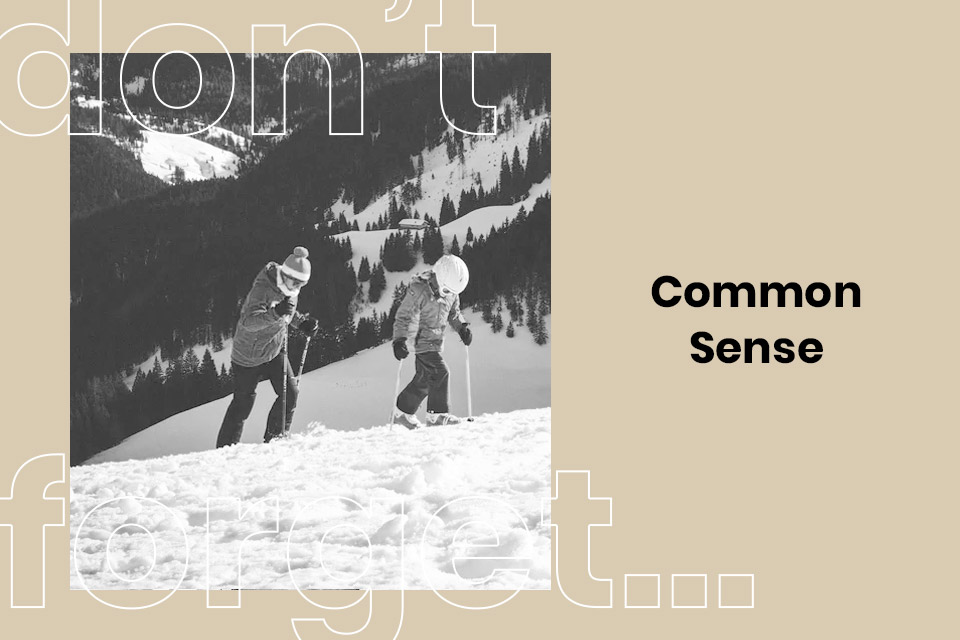
Common Sense
Please note that we are a ski and snowboarding information site and exist to provide snowfall information to people who love skiing and snowboarding …whether we’re in lockdown due to a pandemic or not. By endeavouring to provide information on what is open or opening we are certainly NOT implying that now is the time to try to break through closed borders to travel to the slopes. But there will be a time in the future when we can travel again, and we think most people can cope with knowing the truth about the current state of the ski world, and dream about getting back to it when safe to do so. That’s what we’re here for.




